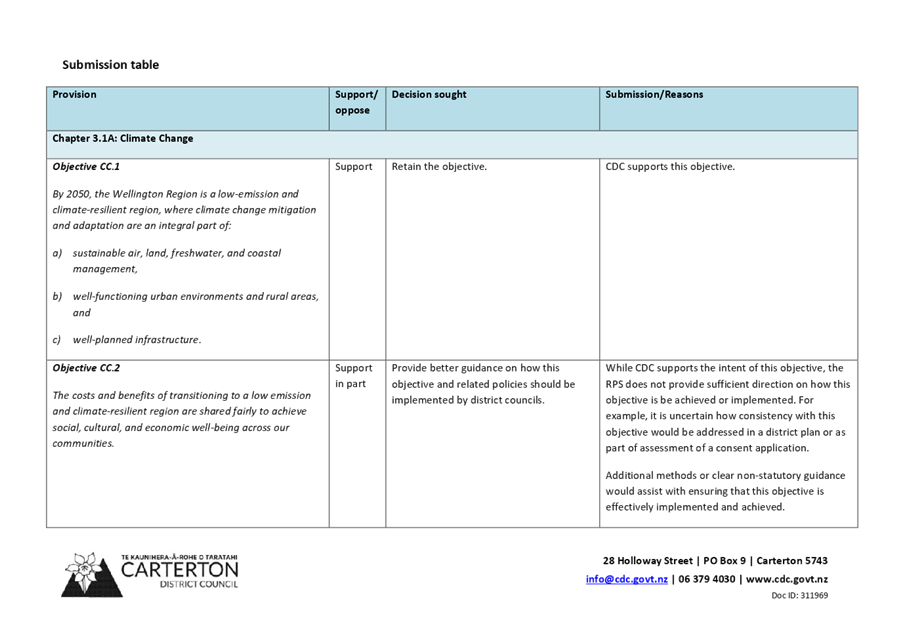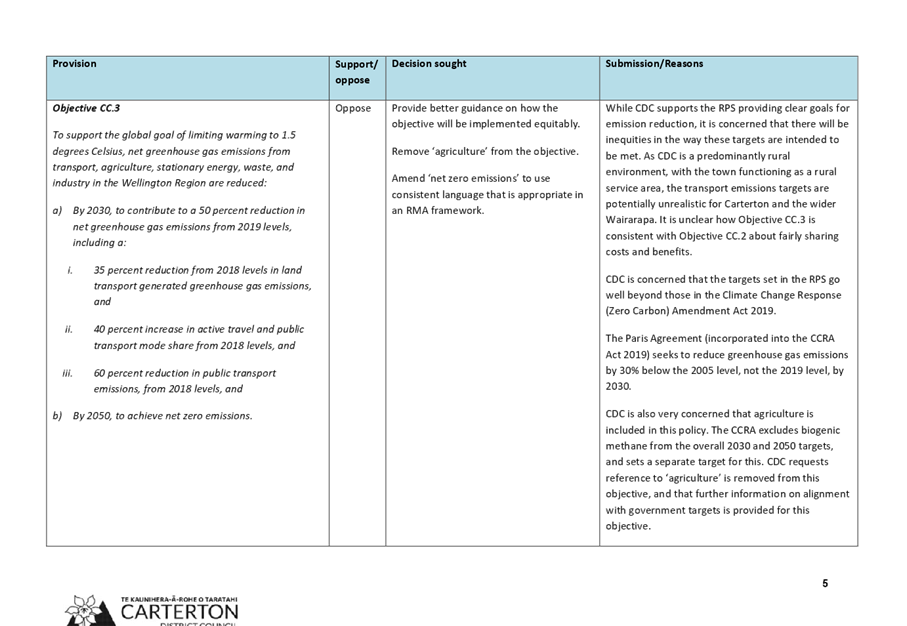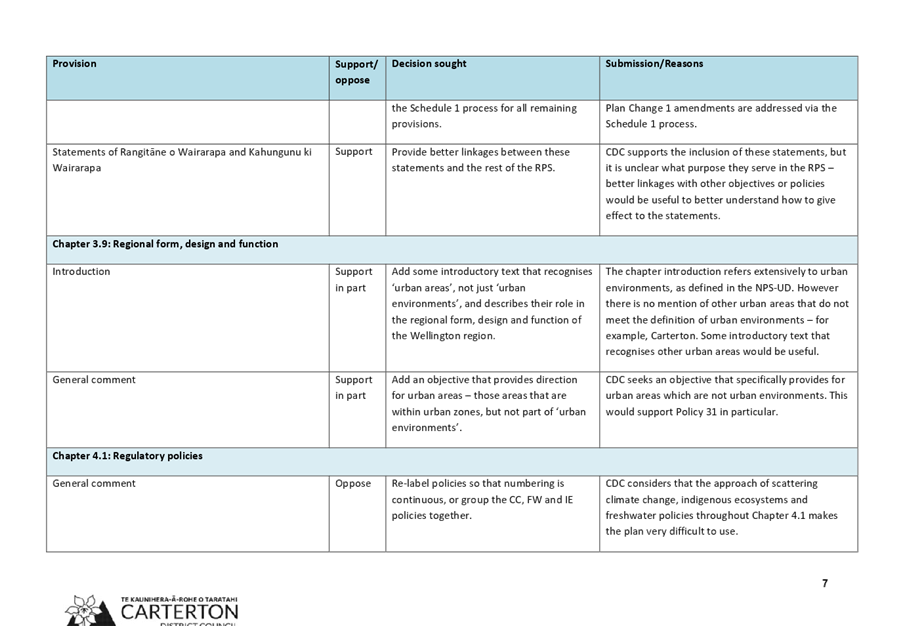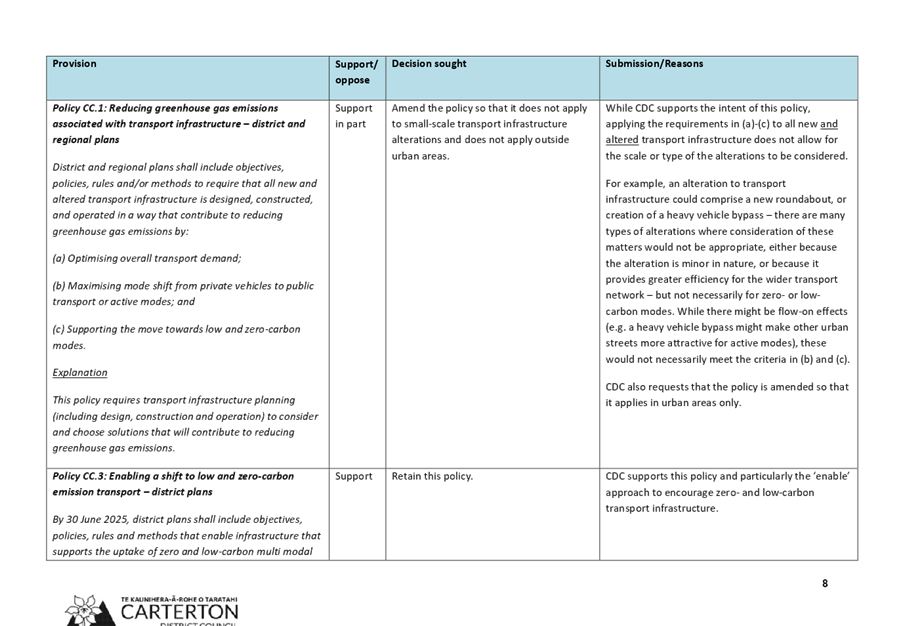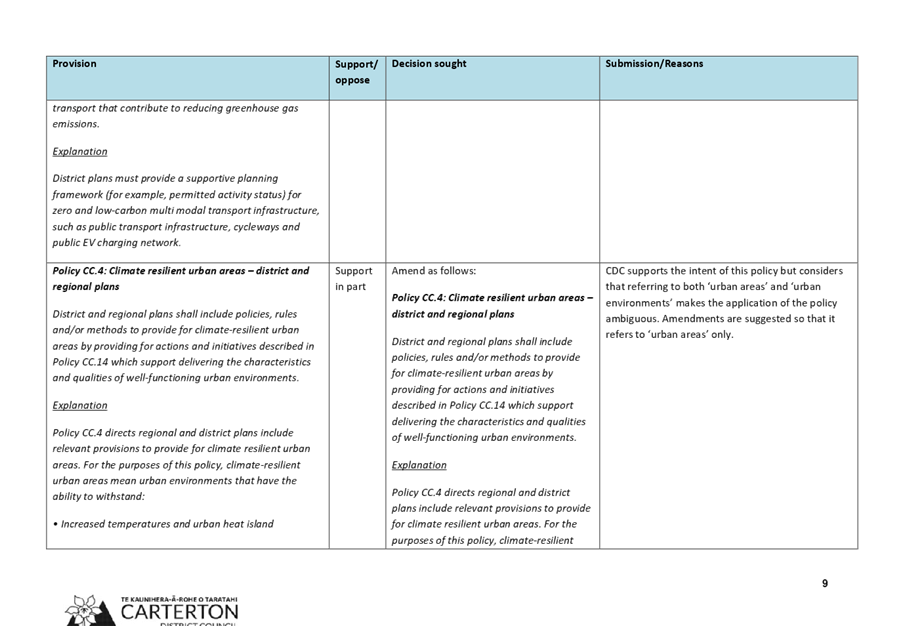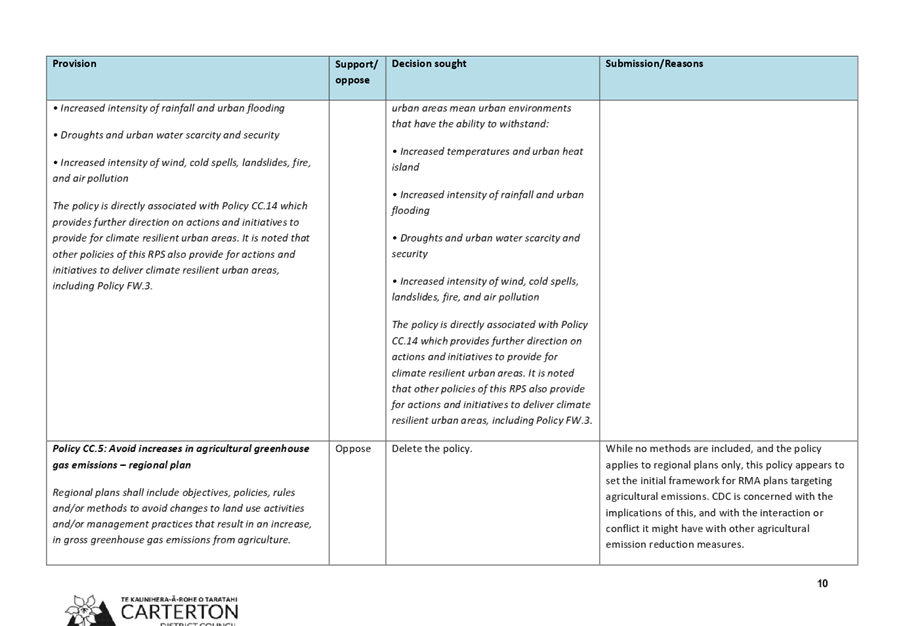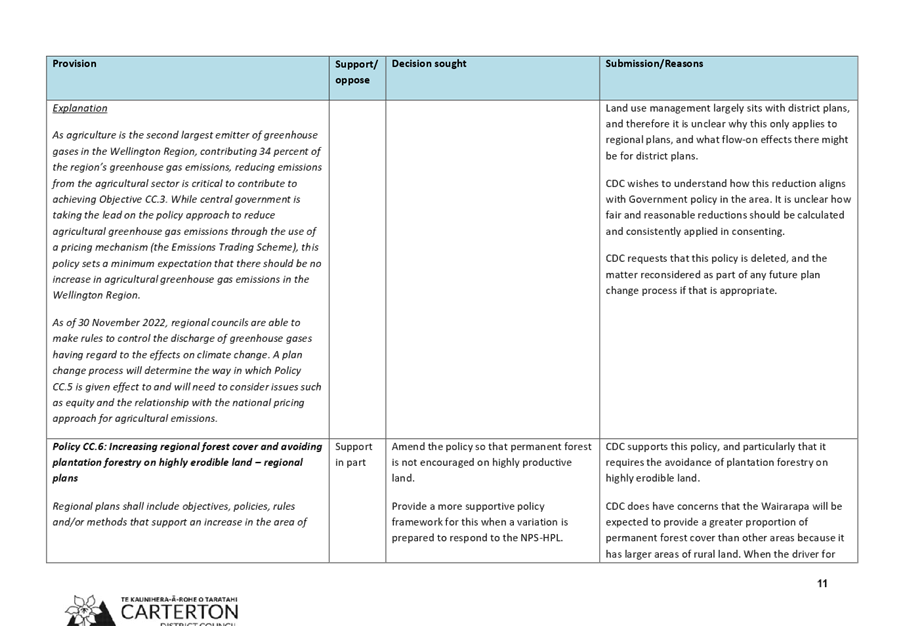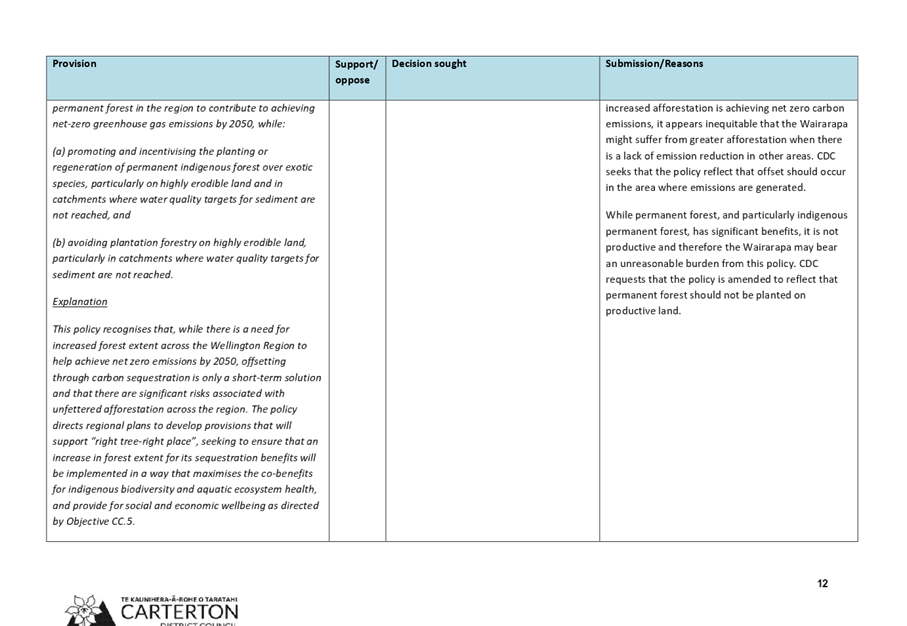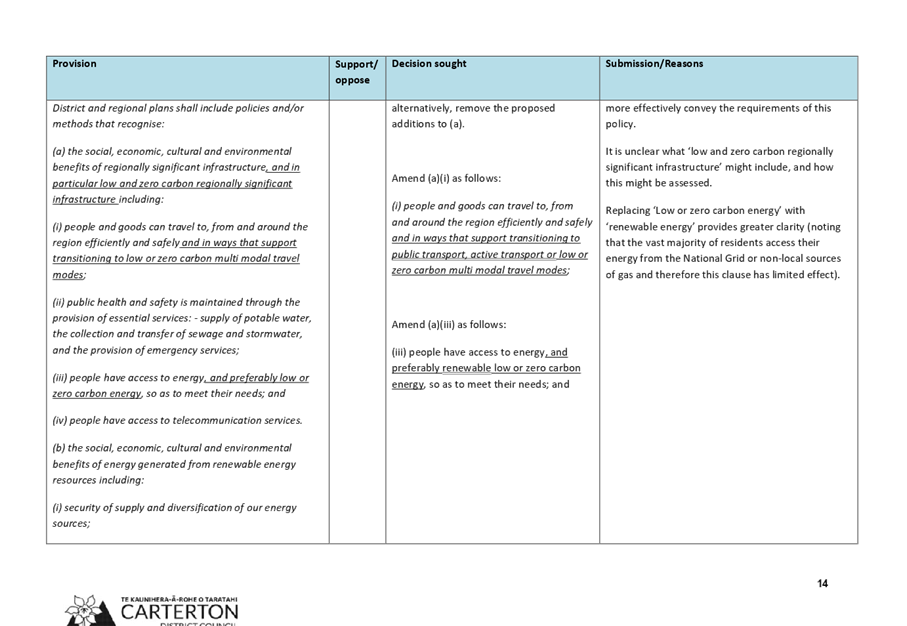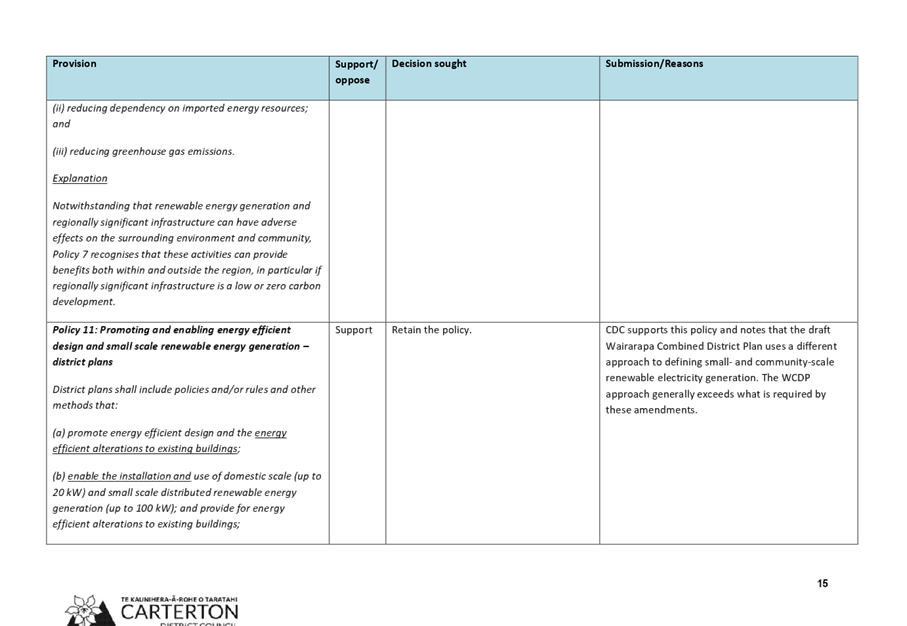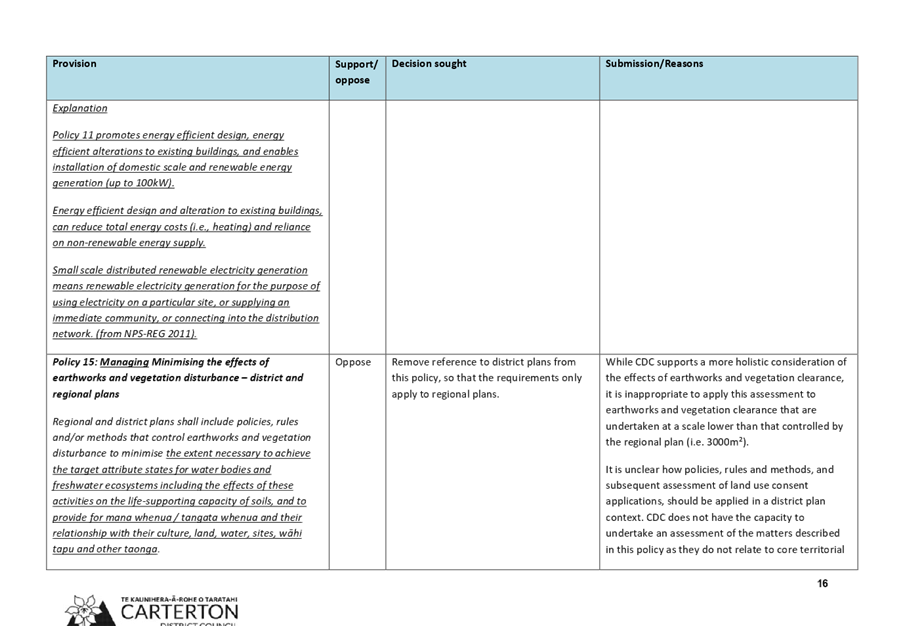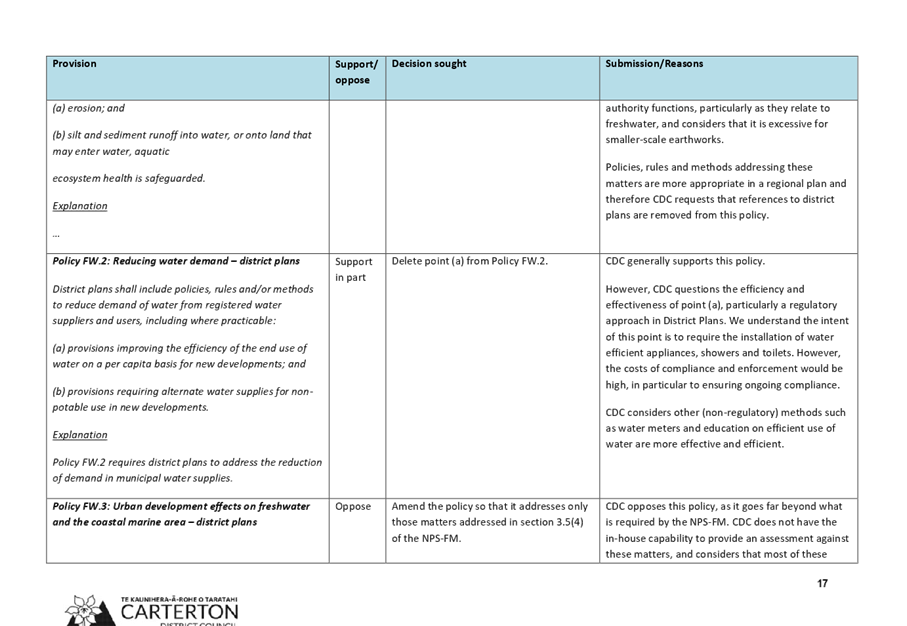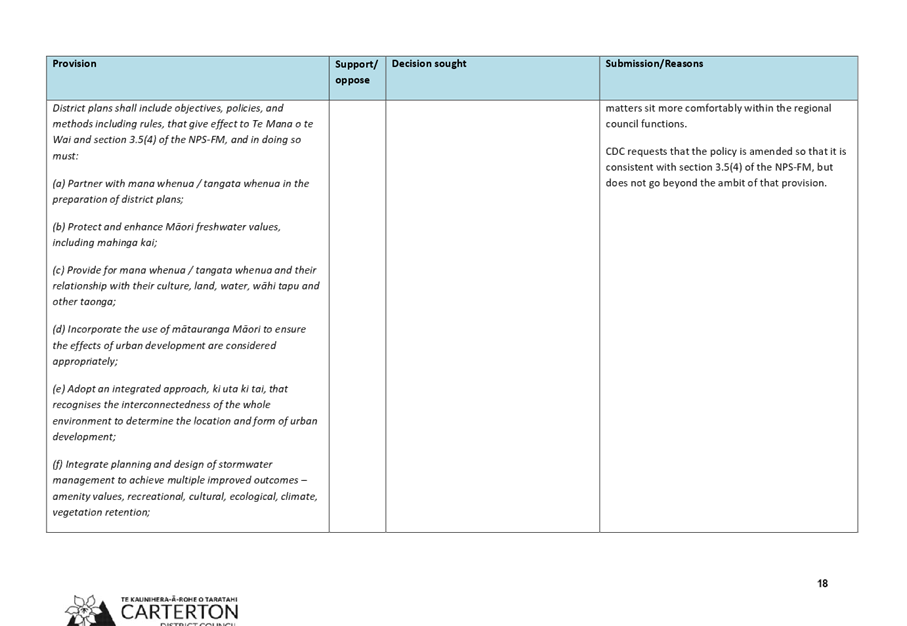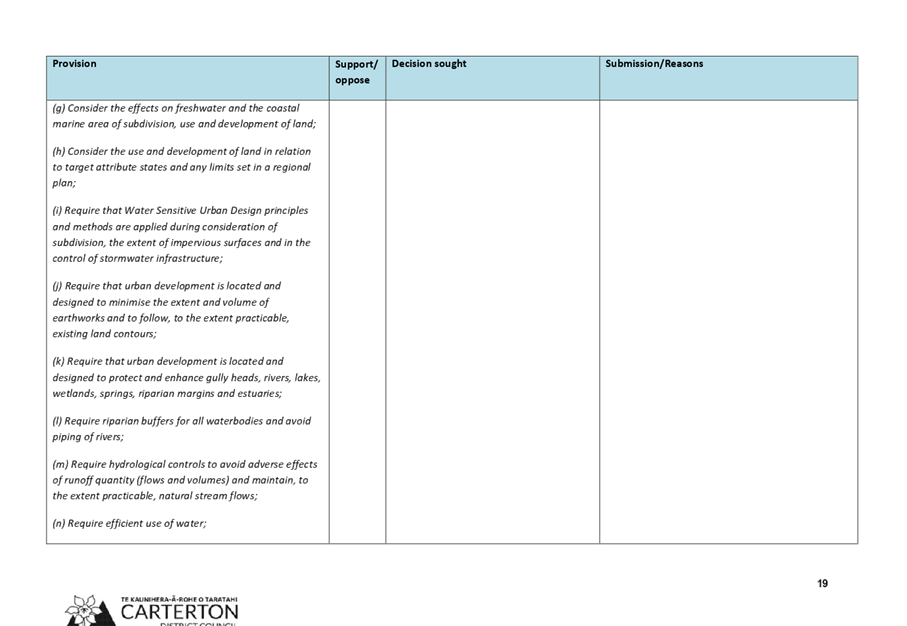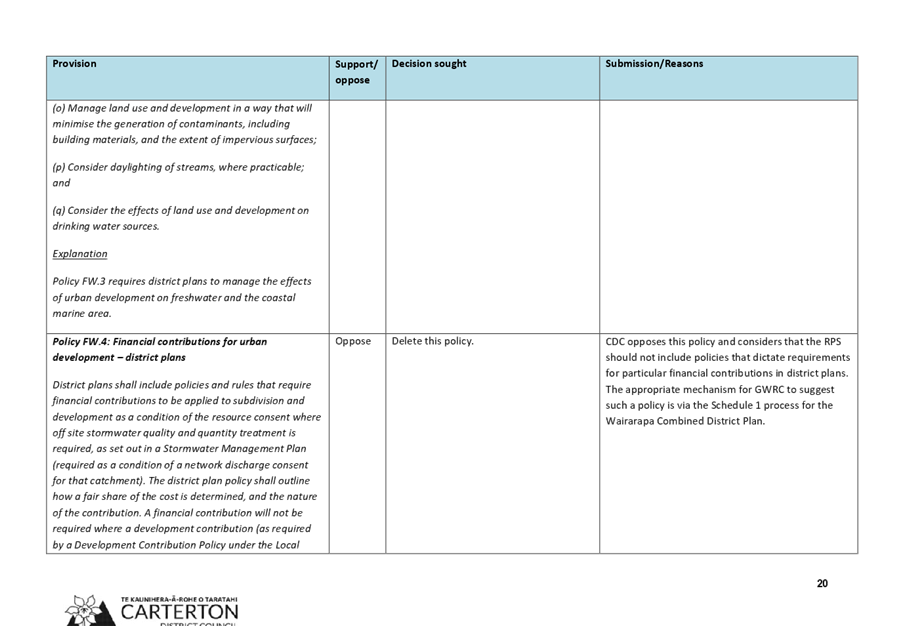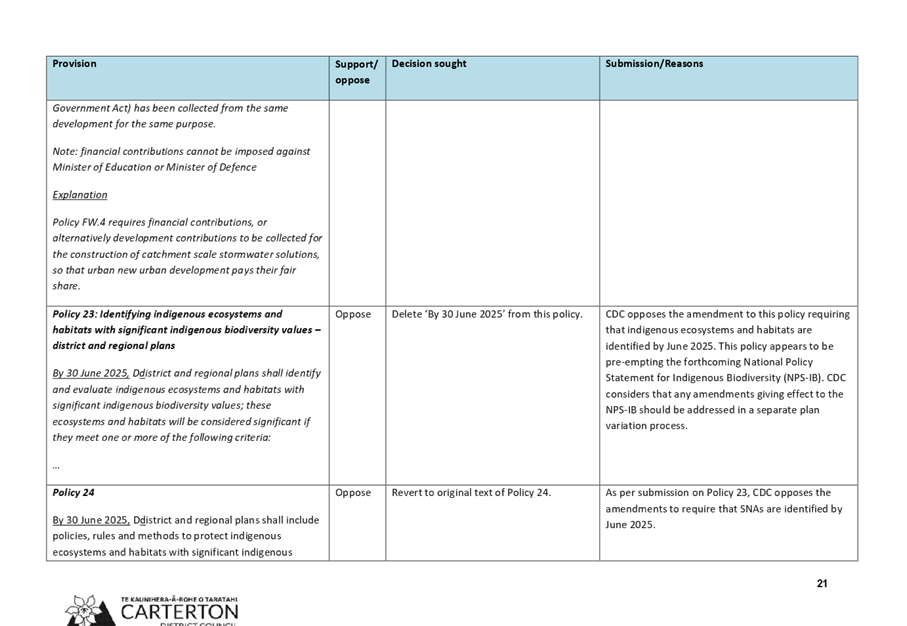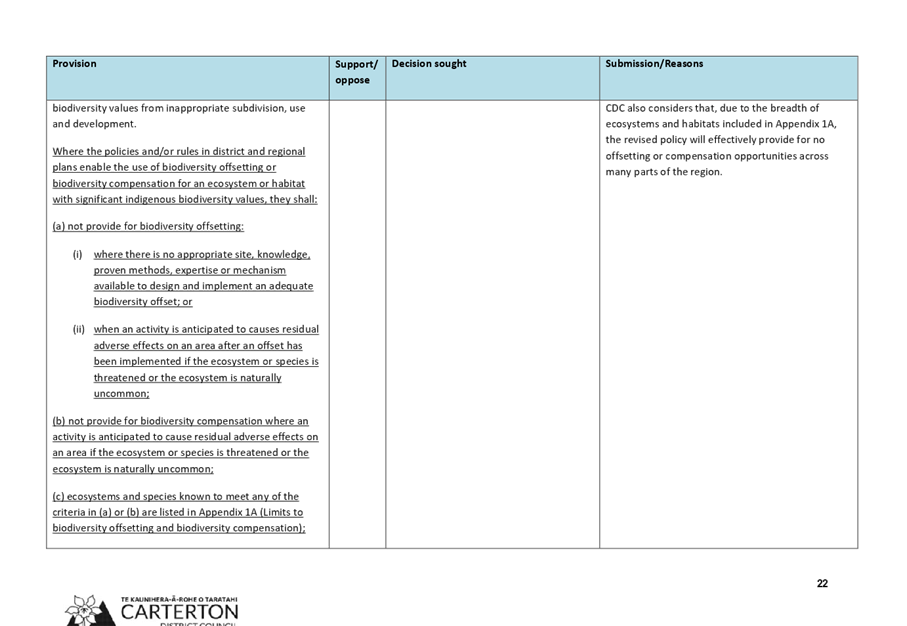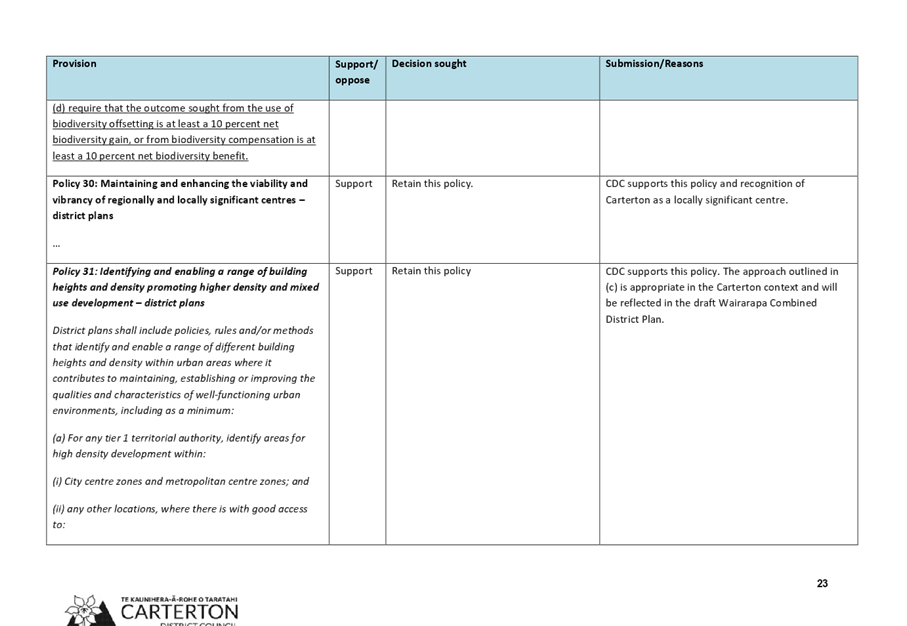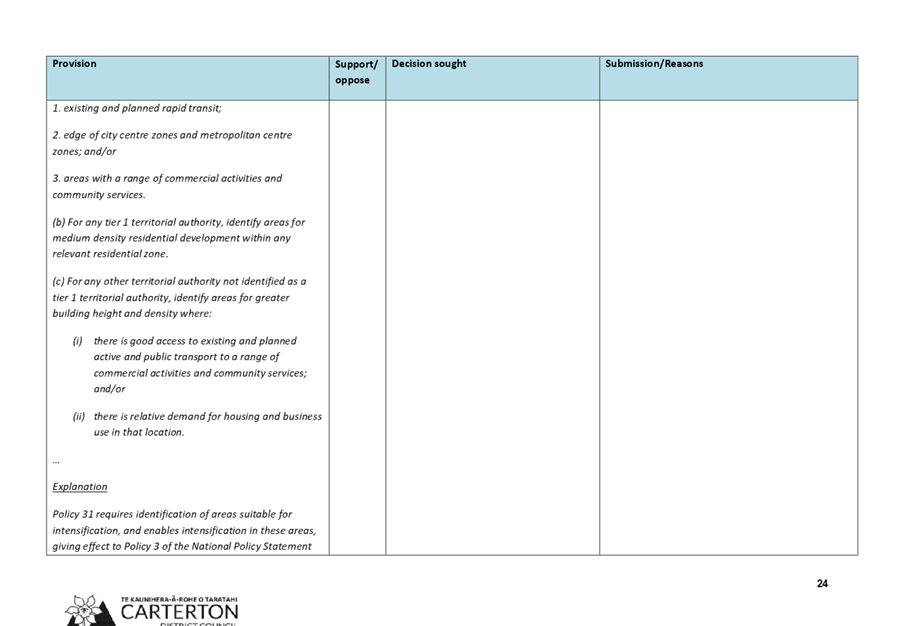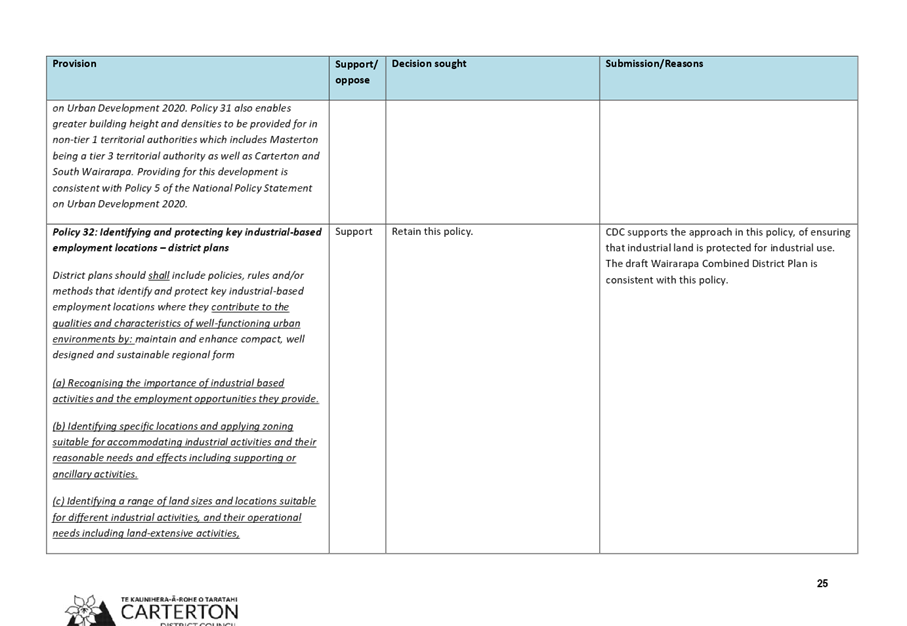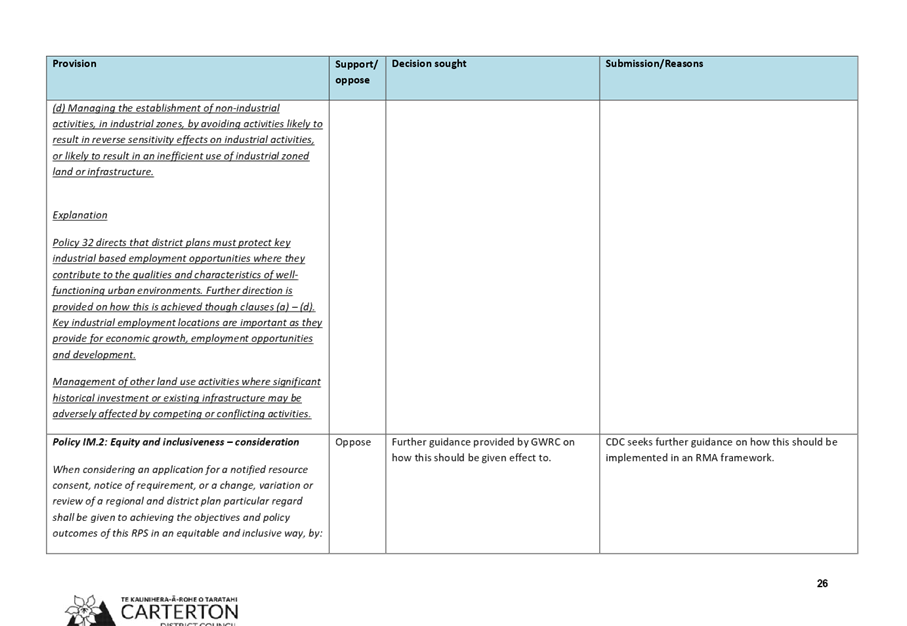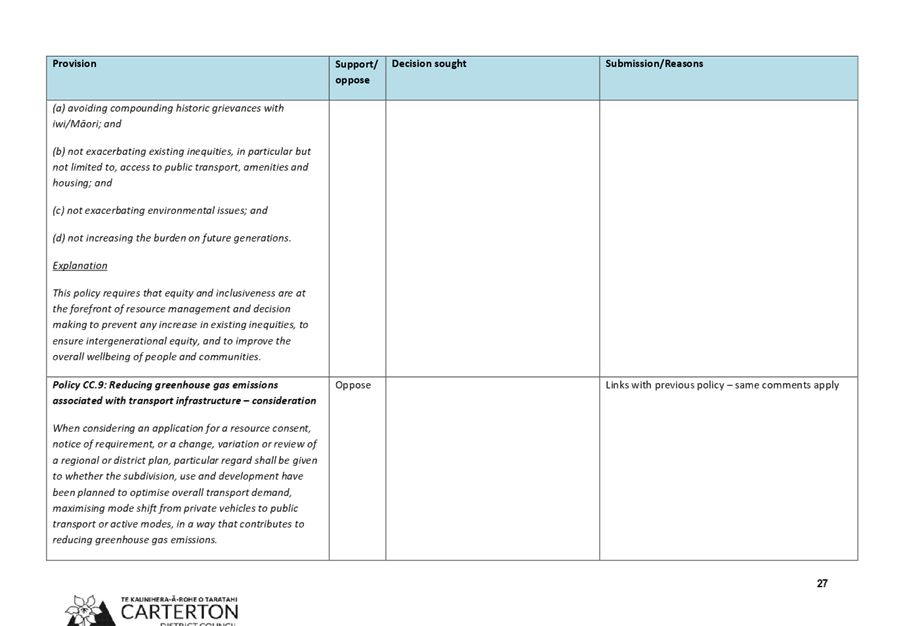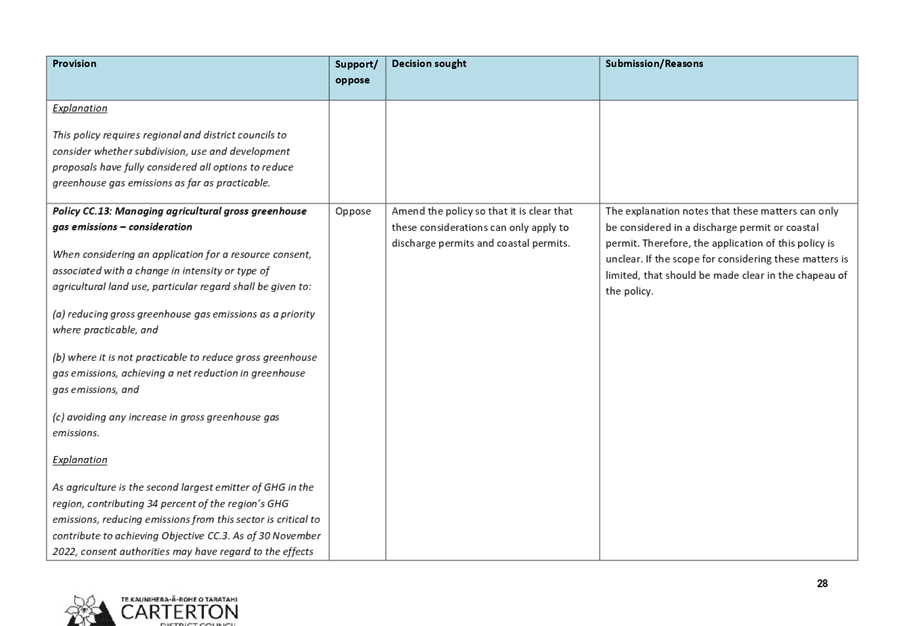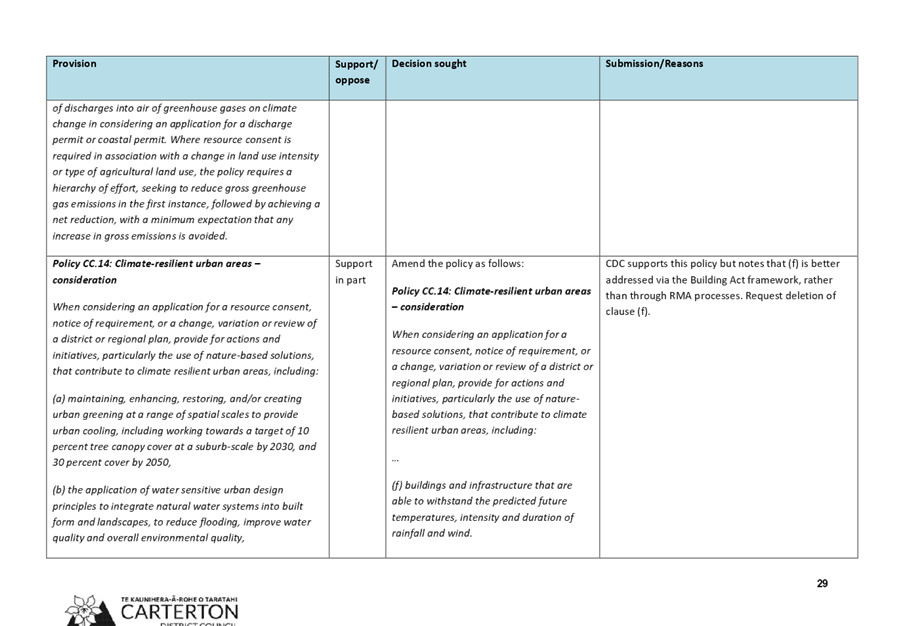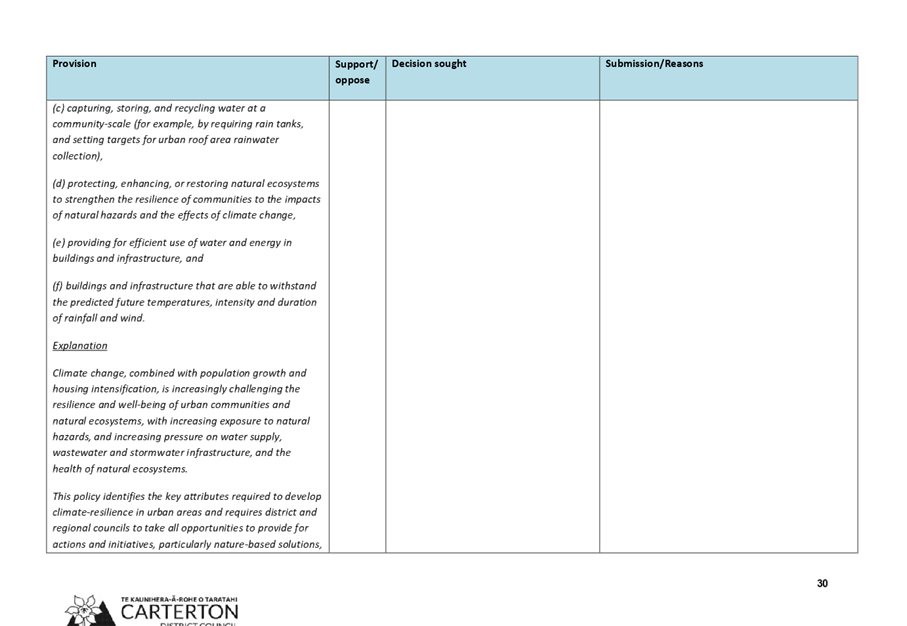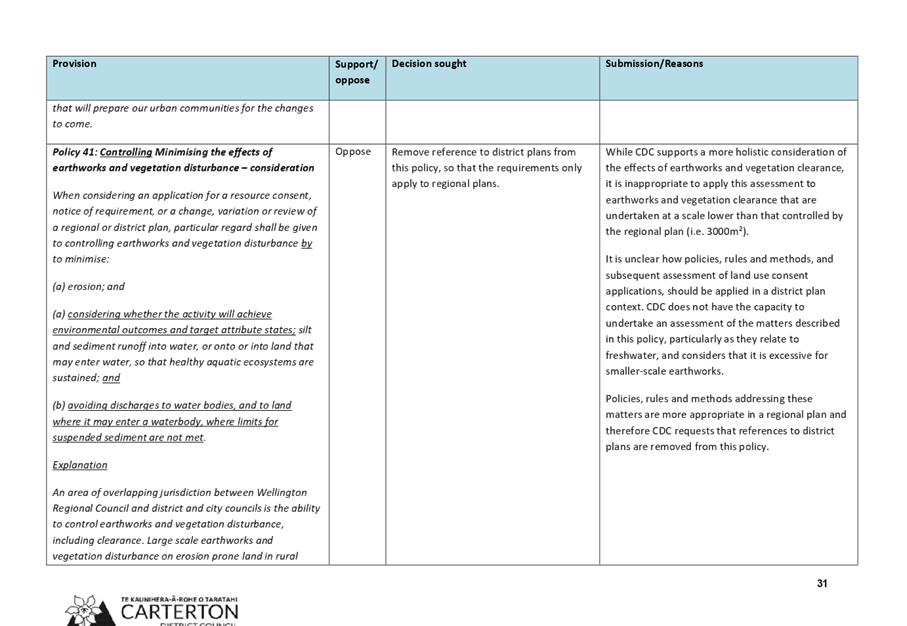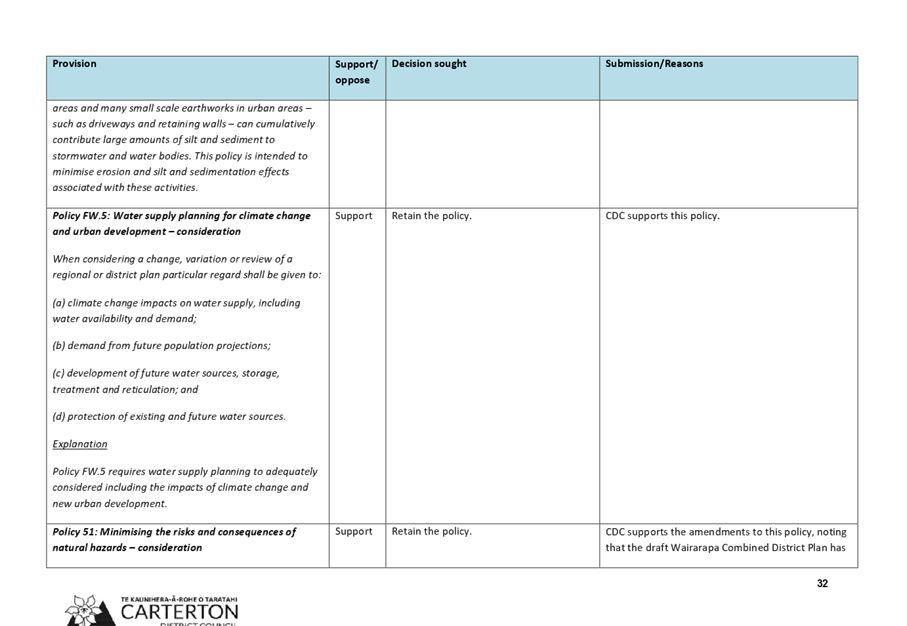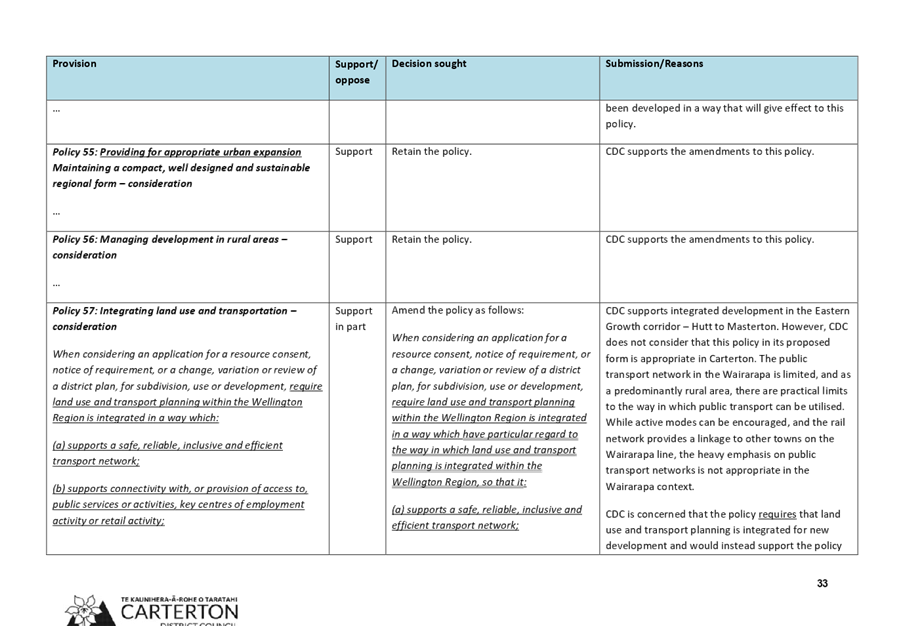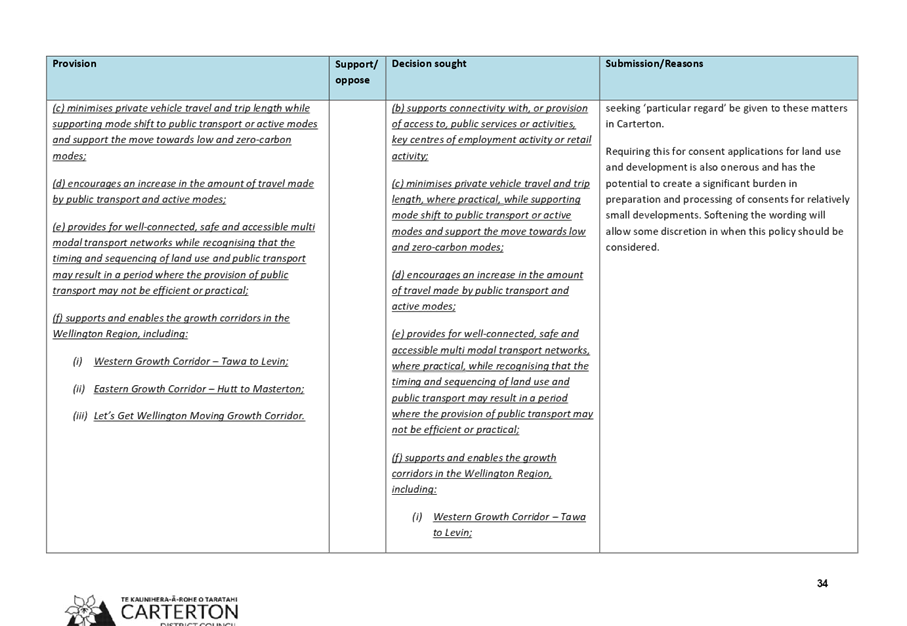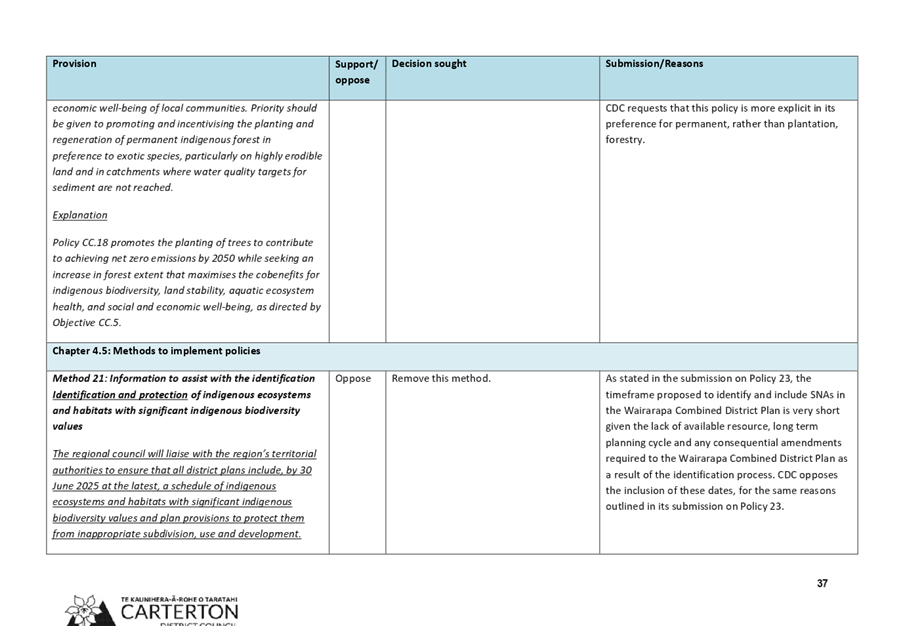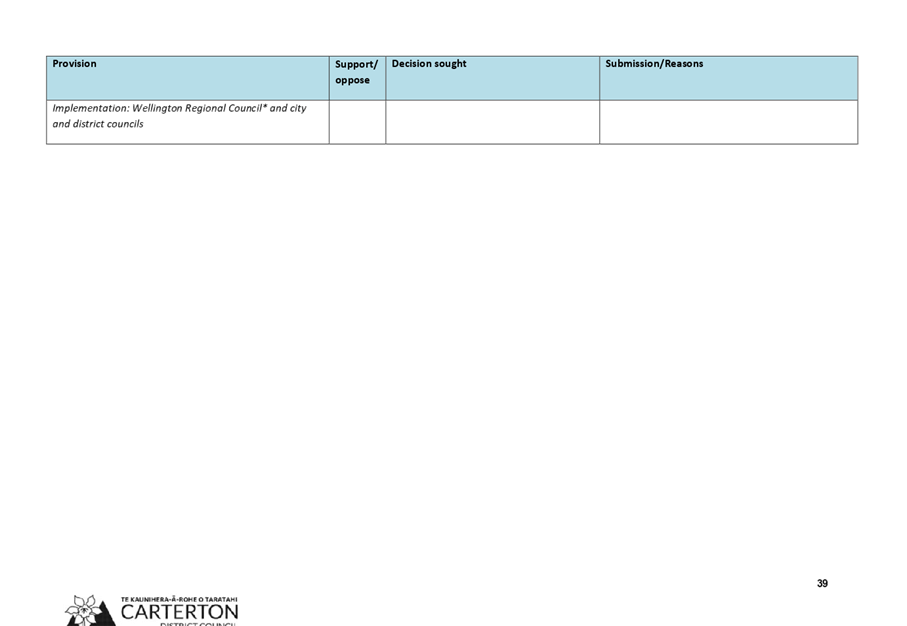|

|
|
AGENDA
Ordinary Council meeting
|
|
Date:
|
Wednesday, 7 December
2022
|
|
Time:
|
1:00pm
|
|
Location:
|
Carterton Events Centre
50 Holloway St
Carterton
|
|
Mayor R Mark
Deputy Mayor D
Williams
Cr S Laurence
Cr R Cherry-Campbell
Cr B Deller
|
Cr S Cretney
Cr L Newman
Cr S Gallon
Cr G Ayling
M Fox - Hurunui-o-Rangi
Marae
|
|
Ordinary
Council meeting Agenda
|
7
December 2022
|
6 Confirmation
of the Minutes

6.1 Minutes
of the Inaugural Council Meeting held on 26 October 2022
1. Recommendation
1. That
the Minutes of the Inaugural Council Meeting held on 26 October 2022 are true
and correct.
File
Number: 317141
Author: Robyn
Blue, Democratic Services Officer
Attachments: 1. Minutes
of the Inaugural Council Meeting held on 26 October 2022
|
Inaugural Council Meeting Minutes
|
26 October 2022
|
MINUTES OF Carterton District Council
Inaugural Council Meeting
HELD AT THE Carterton Events Centre, 50
Holloway St, Carterton
ON Wednesday, 26 October 2022 AT 12.30 Pm
PRESENT: Mayor Ron Mark, Deputy Mayor Dale Williams, Cr Robyn
Cherry-Campbell, Cr Steve Cretney, Cr Brian Deller, Cr Steve Laurence, Cr Lou
Newman, Cr Steve Gallon, Cr Grace Ayling
IN ATTENDANCE: Geoff Hamilton (Chief Executive), Kelly Vatselias
(Corporate Services Manager), Geri Brooking (People and Wellbeing Manager),
Glenda Seville (Community Services and Facilities Manager), Johannes Ferreira
(Infrastructure Services Manager), Solitaire Robertson (Planning and Regulatory
Services Manager), Elisa Brown (Communications and Engagement Manager, Marcus
Anselm (Communications and Engagement Coordinator), Robyn Blue (Democratic
Services Officer)
1 OPENING
OF THE MEETING AND Karakia Timatanga
The Chief Executive of Carterton
District Council, Geoff Hamilton declared the meeting open at 12.30 pm.
This was followed by a karakia led
by J J Carberry, Hurunui-o-Rangi Marae
2 Apologies
An apology was received from
Marama Fox, Hurunui-o-Rangi Marae representative.
3 Conflicts
of Interests Declaration
There were no conflicts of
interest declared.
4 Public
Forum
There was no public forum.
5 Youth
Council views on agenda items
There were no Youth Council views
on the agenda items.
6 Reports
|
6.1 Declarations
by elected members
|
|
1. Purpose
For Councillors to make the declaration required by
clause 14 of Schedule 7 of the Local Government Act 2002.
|
|
NOTED
·
Mayor Ron Mark made his declaration
in front of the Chief Executive of Carterton District Council and put on the
mayoral chains.
·
The remaining 8 elected members did
their declarations in front of Mayor Ron Mark.
·
The Mayor congratulated councillors
for being elected to their important roles and adjourned the meeting at 12.45
pm for refreshments.
|
The
meeting resumed at 1.30 pm.
|
6.2 Voting
procedures for the election of Deputy Mayor and other appointments, and
election of the Deputy Mayor
|
|
1. Purpose
For councillors to agree the voting procedures for the
election of the Deputy Mayor.
For the appointment of the Deputy Mayor.
|
|
MOVED
That the Council:
1.
Agrees that voting system A be used to determine the election of
the Deputy Mayor.
Cr S Cretney / Cr B Deller
CARRIED
2.
Appoint Cr D Williams as Deputy Mayor.
Mayor R Mark / Cr S Cretney
CARRIED
|
|
6.3 Elected
Members' Remuneration
|
|
1. Purpose
For the Council to consider and set remuneration for
Elected Members.
|
|
MOVED
That the Council:
1.
Receives the report.
Cr G Ayling / Cr R Cherry-Campbell
CARRIED
2. Agrees
to recommend to the Remuneration Authority
remuneration for the 2022-2025 Triennium of: Deputy Mayor $49,995 and
all other Councillors $25,253.
3. Notes that Council
can review this allocation during the Triennium and seek approval for changes
from the Remuneration Authority.
Cr L Newman / Cr S Cretney
CARRIED
|
|
6.4 Code
of Conduct 2022-25
|
|
1. Purpose
For the council to adopt a Code of Conduct for the
2022-25 Triennium.
|
|
MOVED
That the Council:
1. Receives
the report.
2. Adopts
the Carterton District Council Code of Conduct (attachment 1).
Cr R Cherry-Campbell / Deputy
Mayor D Williams
CARRIED
|
|
6.5 Standing
Orders for the Triennium
|
|
1. Purpose
For the Council to adopt the Standing Orders 2022-2025.
|
|
NOTED
·
There was a consensus to retain
clause 19.3 in the Standing Orders - ‘The Mayor, Chairperson, or any
other person presiding at a meeting, has a deliberative vote, and in the case
of an equality of votes, has a casting vote.’
MOVED
That the Council:
1.
Receives the report.
2.
Agrees to Option A for speaking and moving motions in clause 22.
Cr S Cretney / Cr B Deller
CARRIED
3.
Agrees to:
a.
Add in clause 13.7 that ‘Members attending a meeting by audiovisual link must
have their camera turned on, unless having the camera off has been
approved by the Chair prior to the meeting.’
b.
Add a Meeting Protocol in Appendix 7
that ‘Members ensure that cell phones are silent and with no vibration
during council, committee and advisory group meetings’.
4.
Adopts the Carterton District Council Standing Orders
2022 with the changes noted in this paper and identified in the Standing
Orders, and agreed in (2) and (3).
Cr R Cherry-Campbell / Deputy
Mayor D Williams
CARRIED
|
|
6.6 Council,
Committees, Advisory Groups and Portfolio Responsibilities for the 2022-25
Triennium
|
|
1. Purpose
For the Council to consider and adopt a committee
structure for the 2022-25 Triennium.
|
|
MOVED
That the Council:
1. Receives
the report.
2. Agrees
to adopt the governance structure, as set out in sections 5 and 6 of this
report including forming a Rural Advisory Group.
3. Adopts
the Terms of Reference for the following committees and advisory groups as
outlined in Attachment 1.
(a) Audit and Risk
Committee
(b) Policy and Projects
Committee
(c) Water Race
Committee
(d) Hearings Committee
(e) Sport NZ Rural Travel
Fund Committee
(f) Community Grants
Committee
(g) Walking and
Cycling Advisory Group
4. Notes
that the Terms of Reference of the People and Places Advisory Group, Rural
Advisory Group, the Wastewater Treatment Plant Advisory Group, and the
Investment Committee will come to Council for approval after they have been
endorsed by the Investment Committee and respective Advisory Group.
Cr L Newman / Deputy Mayor D Williams
CARRIED
5.
Appoints Philip Jones as Chair of the Audit and Risk Committee
for an interim period until such time as a decision is made on a Chair for
the triennium 2022-25.
Cr R Cherry-Campbell / Cr B Deller
CARRIED
6. Appoints
the following members to the committees, and the chairs and deputy chairs
of those committees:
|
Committee
|
Members / Chair
|
|
Audit and Risk Committee
|
Chair - As agreed in Recommendation 5, Philip Jones
Deputy Chair – Deputy Mayor D Williams
Elected members – Cr G Ayling / Cr S Cretney
Hurunui-o-Rangi Marae representative
|
|
Policy and Projects Committee
|
Chair – Cr S Cretney
Deputy Chair – Cr S Gallon
All elected members
Hurunui-o-Rangi Marae representative
|
|
Investment Committee
|
Independent Chair - TBC
Deputy Chair – Deputy Mayor D Williams
Elected members - Cr L Newman / Cr S Laurence
|
|
Water Race Committee
|
Chair – Cr B Deller
Deputy Chair (appointed by the Committee from Community
members)
Elected members - Cr S Gallon / Cr S Cretney
The following community members will continue as
members of the Committee until the Water Race elections are held in 2024:
· David Ellison
· Jill Eastham
· John McFadzean
· Neil Wadham
|
|
Hearings Committee
|
Chair – Cr R Cherry-Campbell
Deputy Chair – Cr B Deller
Elected members – Cr S Laurence
|
|
Rural Travel Fund Committee
|
Chair – Cr S Cretney
Deputy Chair – Cr B Deller
Elected members – Cr S Gallon / Cr L Newman
|
|
Community Grants Committee
|
Chair – Cr R Cherry-Campbell
Deputy Chair – Deputy Mayor D Williams
Elected members - Cr L Newman / Cr G Ayling
|
Deputy
Mayor D Williams / Cr S Laurence
CARRIED
7. Appoints
the following Chairs, Deputy Chairs and members to the following advisory
groups:
|
Advisory Group
|
Members / Chair
|
|
People and Places Advisory Group
|
Chair – Cr R Cherry-Campbell
Deputy Chair – Cr S Cretney
Elected members – Cr L Newman / Cr S Laurence
|
|
Walking and Cycling Advisory Group
|
Chair – Cr L Newman
Deputy Chair – Cr S Laurence
Elected members – Cr S Cretney
|
|
Wastewater Treatment Plant Advisory Group
|
Chair – Deputy Mayor D Williams
Deputy Chair – Cr S Cretney
Elected members - Cr S Gallon / Cr G Ayling
|
|
Rural Advisory Group
|
Chair – Cr B Deller
Deputy Chair – John Booth (appointed)
Elected members – Cr S Gallon / Deputy Mayor D
Williams / Cr G Ayling
|
Cr
G Ayling / Cr S Cretney
CARRIED
8. Agrees
to continue to invite the Hurunui-o-Rangi Marae to have a representative
sit at the Council table, with full speaking, but not voting, rights.
Mayor
R Mark / Deputy Mayor D Williams
CARRIED
9. Notes
that the governance structure will be reviewed in 2023.
|
|
6.7 Elected
member appointments to external bodies, joint committees and other groups
|
|
1. Purpose
For the Council to make
Elected Member appointments to various external bodies, joint committees and
other groups for the 2022-25 Triennium.
|
|
MOVED
That the Council:
1. Receives
the report.
2. Makes
the following appointments for the term of the Triennium:
|
Committee / Entity
|
Elected Member Appointee
|
|
Wairarapa District Plan
Review Committee
|
Crs B Deller and R Cherry-Campbell
|
|
Joint District Licensing
Committee (2)
|
Cr B Deller / Deputy Mayor D Williams
|
|
Wairarapa Economic Development Strategy Governance
Group
(1)
|
Mayor R Mark
Cr R Cherry-Campbell (alternate)
|
|
Wairarapa Trails Action
Group
(2)
|
Cr L Newman / Cr S Laurence
|
|
Wairarapa Road Safety
Council
(1)
|
Cr S Laurence
|
|
Zone 4
(LGNZ)
(1)
|
Mayor R Mark
|
|
Wairarapa Climate Change
Caucus (2)
|
Cr R Cherry-Campbell / Cr G Ayling
|
|
Wellington Regional Waste Minimisation and Management
Joint Committee (WCC)
Wellington Regional Waste
Forum (1)
|
Cr S Cretney
Mayor R Mark (alternate)
|
|
Mayor’s Taskforce for Jobs
|
Mayor
Deputy Mayor D Williams (alternate)
|
|
Mangatārere Project
Team
(2)
|
Cr S Cretney / Cr S Laurence
|
Cr S Laurence / Cr L Newman
CARRIED
|
|
6.8 Appointments
to Greater Wellington Regional Council's regional committees
|
|
1. Purpose
For the Council to nominate elected representatives to
Greater Wellington Regional Council’s regional committees.
|
|
MOVED
That the Council:
1. Receives
the report.
2. Agrees
to nominate the following members to the
Greater Wellington Regional Council committees:
|
Committee
|
Nominee
|
Alternate
|
|
Wellington Regional Transport Committee
|
Mayor
|
Deputy Mayor
|
|
Wellington Region Leadership Committee
|
Mayor
|
Deputy Mayor
|
|
Civil Defence and Emergency Committee
|
Mayor
|
Deputy Mayor
|
Cr B Deller / Cr G Ayling
CARRIED
|
|
6.9 Local
Authority Triennial Elections 2022
|
|
1. Purpose
For Council to receive a report on the conduct of the
2022 Local Authority Elections.
|
|
MOVED
That the Council:
1. Receives
the report.
Cr R Cherry-Campbell / Cr G
Ayling
CARRIED
|
|
6.10 Confirmation
of the Delegations Manual for the Triennium
|
|
1. Purpose
For Council to confirm the Delegations Manual for the new
triennium.
|
|
MOVED
That the Council:
1. Receives
the report.
2. Approves
the Delegations Manual (Attachment 1) with the identified amendment (i.e.
Infrastructure & Services Committee is replaced with Policy &
Projects Committee in clause 10.11).
Cr L Newman / Cr R
Cherry-Campbell
CARRIED
|
|
6.11 Council
meeting schedule November-December 2022
|
|
1. Purpose
To establish the schedule for Council and Committee
meetings to be held in November – December 2022.
|
|
MOVED
That the Council:
1. Receives
the report.
2. Adopts the committee
and council meeting schedule for November and December 2022 as outlined in
this paper.
Deputy Mayor D Williams / Cr B
Deller
CARRIED
|
|
6.12 Laws
and obligations relating to elected members
|
|
1. Purpose
To provide information to elected members on key
legislation that affects them.
|
|
MOVED
That the Council:
1. Receives
the report.
Cr S Gallon / Cr L Newman
CARRIED
|
|
6.13 Chief
Executive Report
|
|
1. Purpose
For the Council to be informed on planned Council
operational activities, major projects, and other matters of importance and
interest.
|
|
MOVED
That the Council:
1. Receives
the report.
Cr R Cherry-Campbell / Deputy
Mayor D Williams
CARRIED
|
7 Exclusion
of the Public
Not applicable.
8 Karakia
Whakamutunga
The meeting was closed with a
karakia led by Cr R Cherry-Campbell.
The meeting closed at 3 pm
Minutes confirmed:
…………………………………………………
20 December 2022
Date:
...................................................
|
Ordinary
Council meeting Agenda
|
7
December 2022
|
7 Reports

7.1 Correspondence
1. Purpose
To note relevant
correspondence received by Council.
2. Recommendation
That the Council:
1. Notes
the correspondence received.
File
Number: 318818
Author: Kelly
Vatselias, Corporate Services Manager
Attachments: 1. 24
November 2022 - RMA Reforms ⇩
2. 15
November 2022 - Services/issues for older people ⇩
|
Ordinary
Council meeting Agenda
|
7
December 2022
|

|
Ordinary
Council meeting Agenda
|
7
December 2022
|


|
Ordinary
Council meeting Agenda
|
7
December 2022
|

7.2 Destination
Wairarapa Quarterly Report
1. Purpose
For the council to
receive a report of activities for the quarter ending September 2022.
2. Significance
The
matters for decision in this report are not considered to be of significance
under the Significance and Engagement Policy.
3. Background
The
three Wairarapa Territorial Authorities collectively invest in Destination
Wairarapa as the Regional Tourism Organisation.
4. Activities
of Destination Wairarapa
Attached
to this report are the following:
· General Managers and Marketing activities for the period of July
– September 2022 is included as Attachment 1.
· The financial report for DW is in Attachment 2.
· The Budget Variance report for DW is in Attachment 3.
· Audited Financial Statements 2022 in Attachment 4.
Key
points to note
The
new MOU with Destination Wairarapa and the three councils has been finalised
and signed.
5. Recommendation
That the Council:
1. Receives
the report.
File
Number: 317127
Author: Glenda
Seville, Community Services Manager
Attachments: 1. GM
Report ⇩
2. Financial
Report ⇩
3. Budget
Variance ⇩
4. Audited
Financial Statements ⇩
|
Ordinary
Council meeting Agenda
|
7
December 2022
|








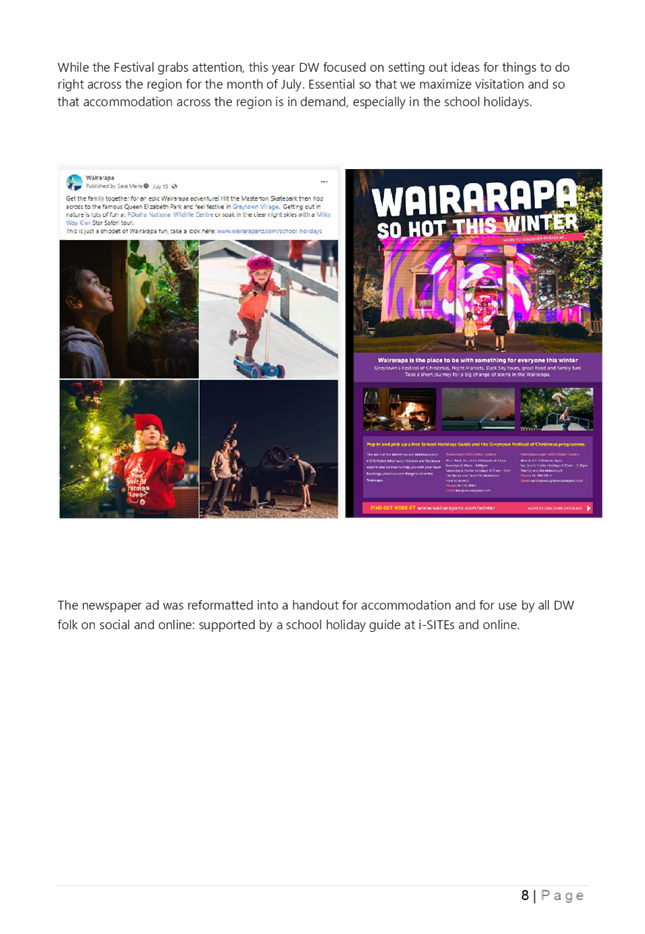
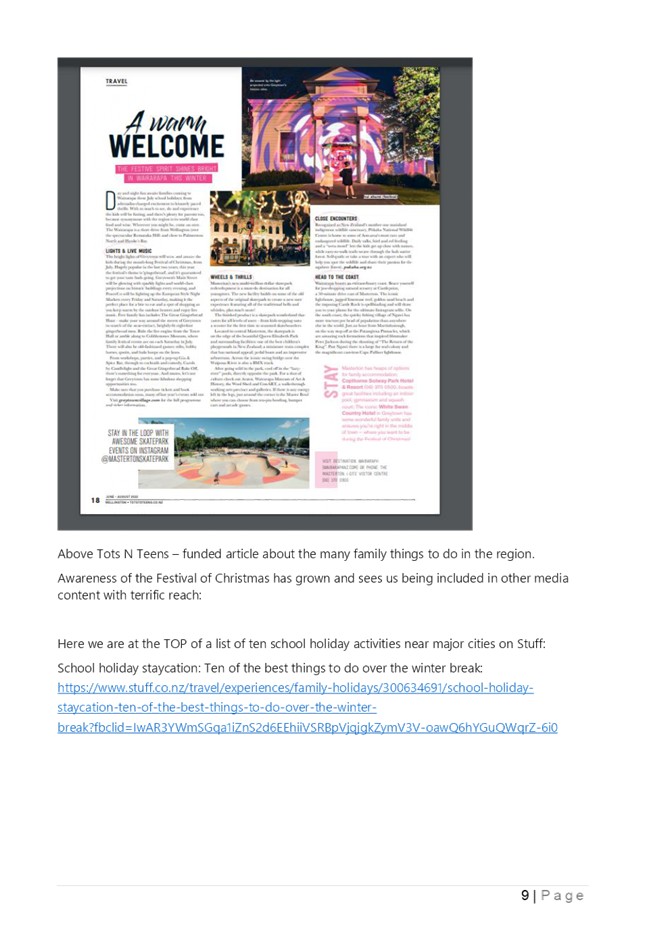
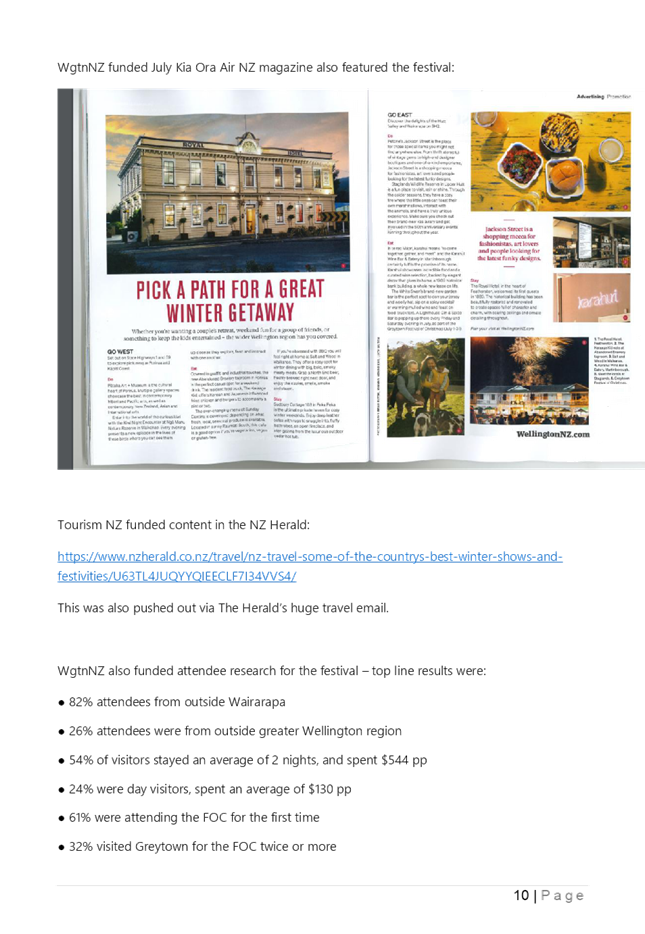
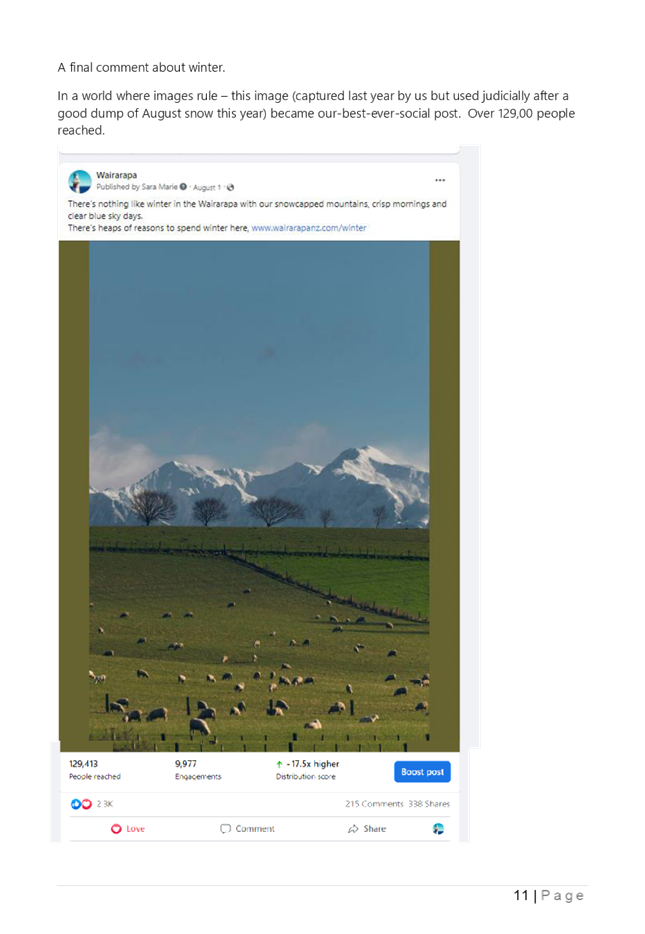

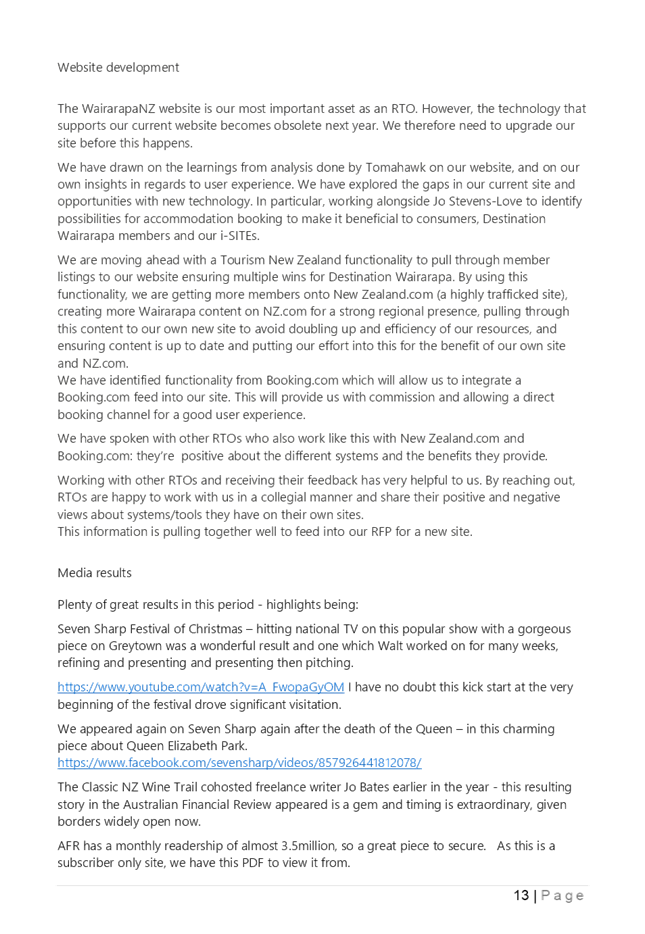
|
Ordinary
Council meeting Agenda
|
7
December 2022
|

|
Ordinary
Council meeting Agenda
|
7
December 2022
|
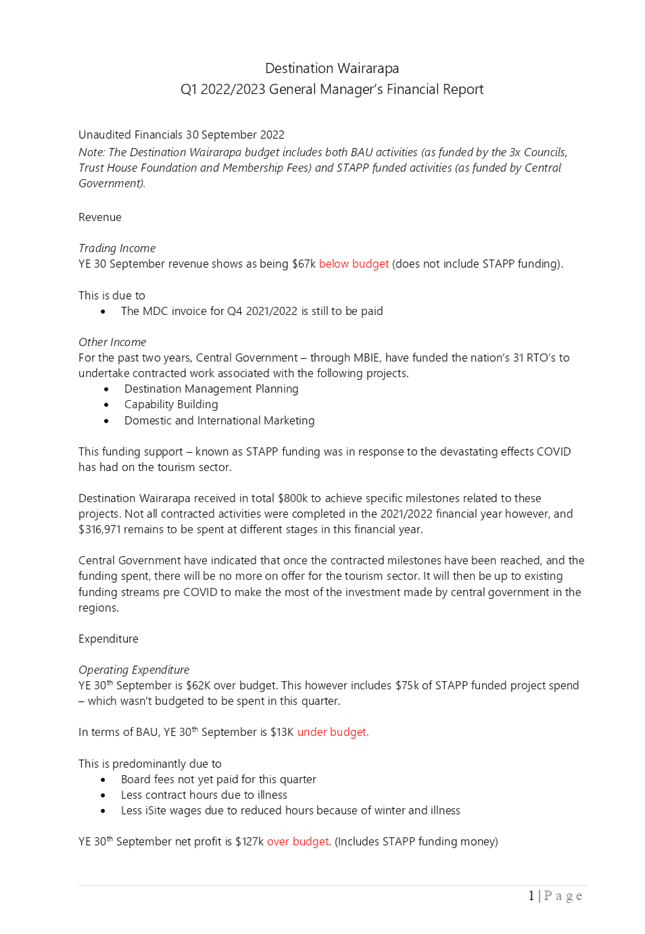
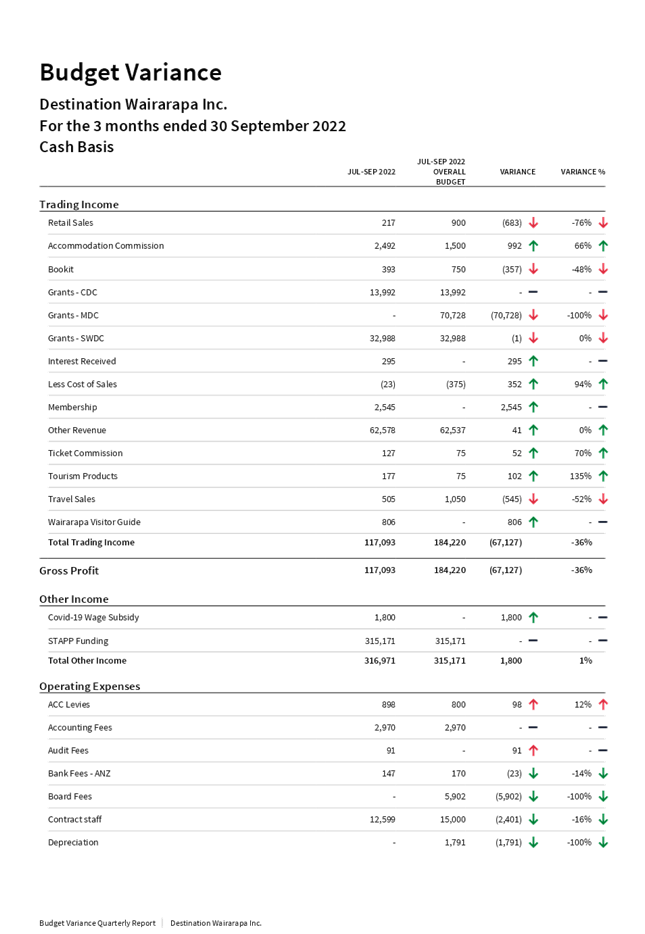
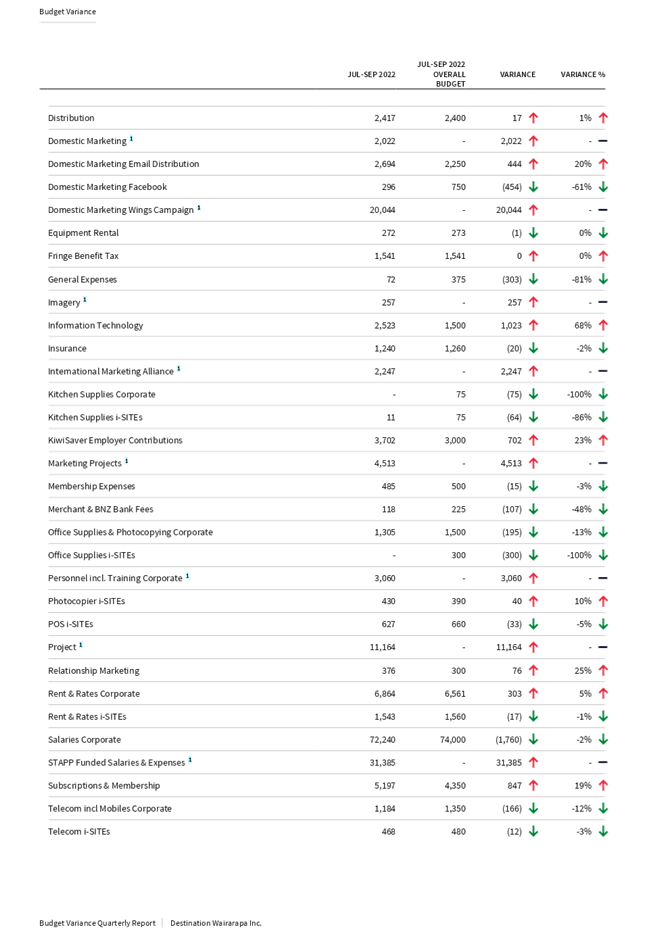
|
Ordinary
Council meeting Agenda
|
7
December 2022
|
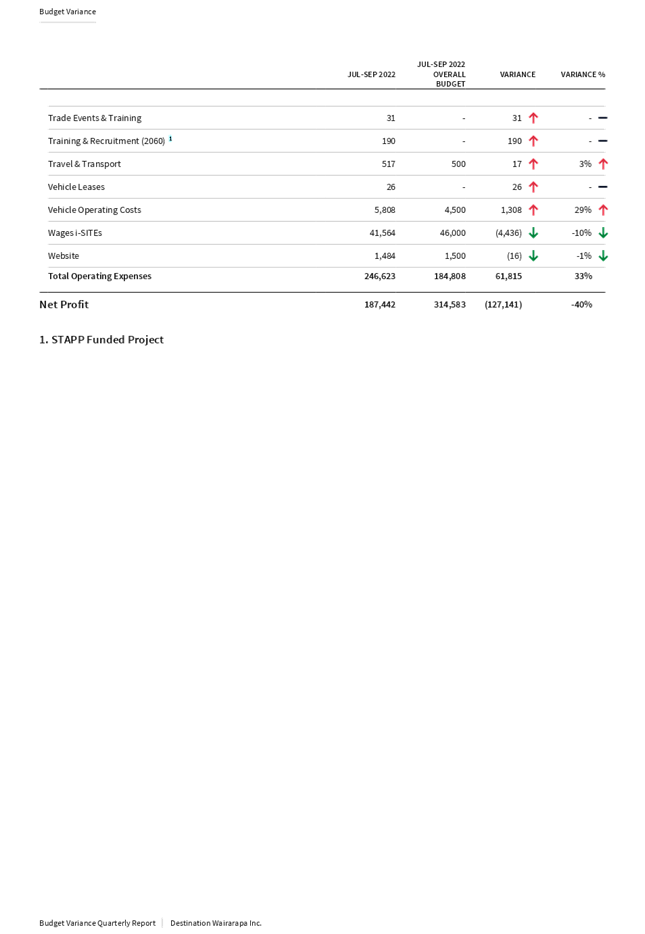
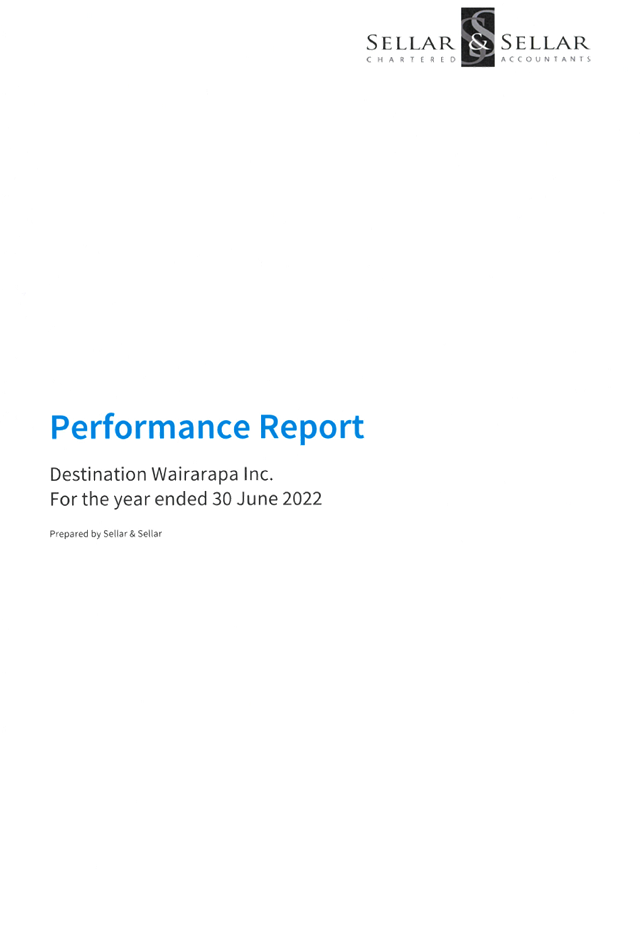
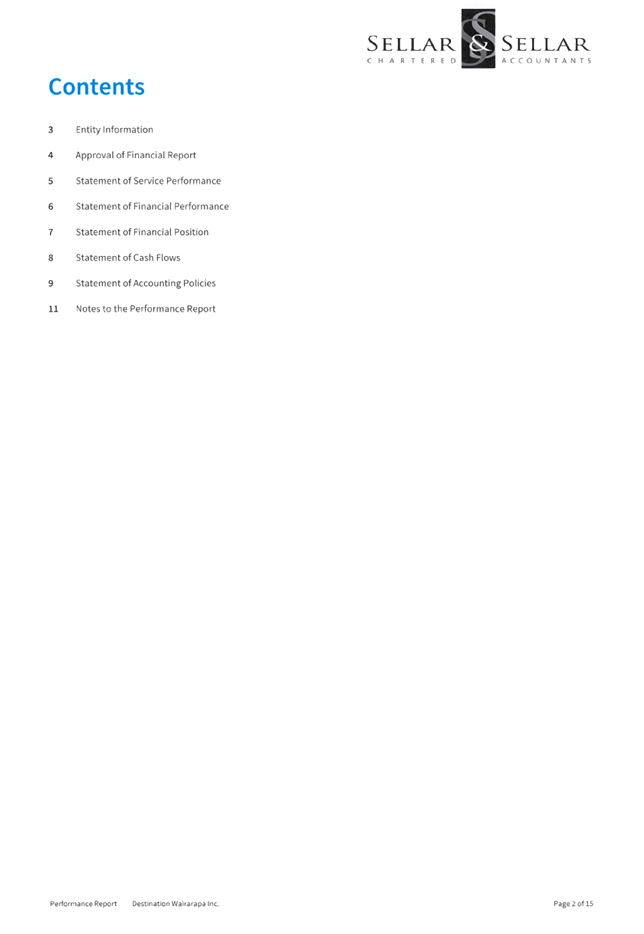
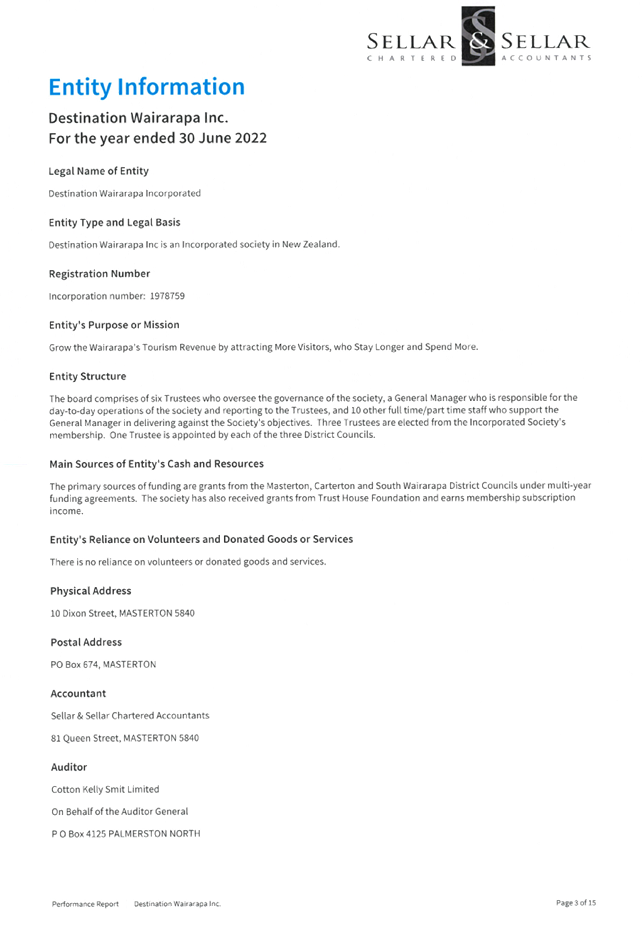

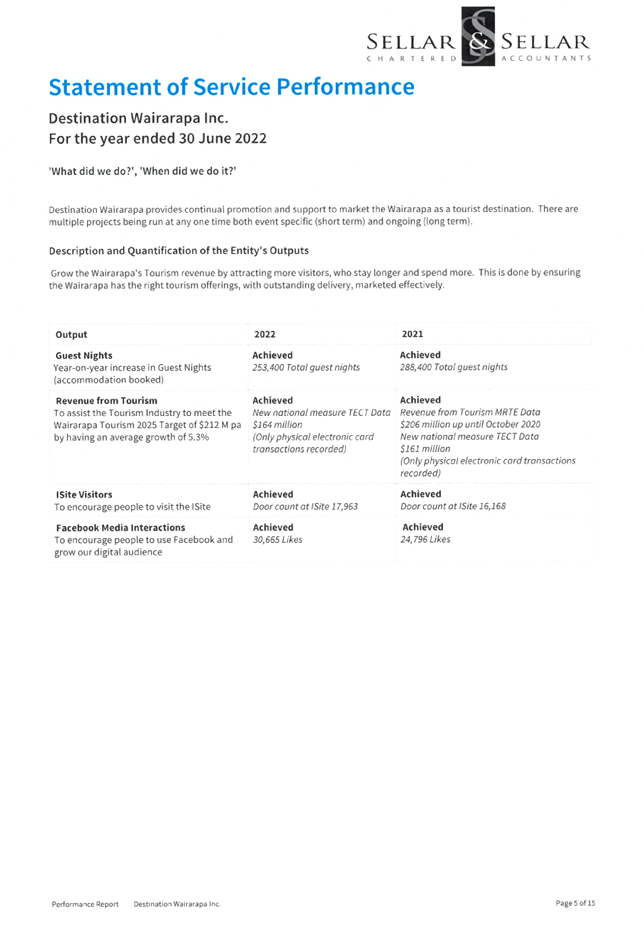
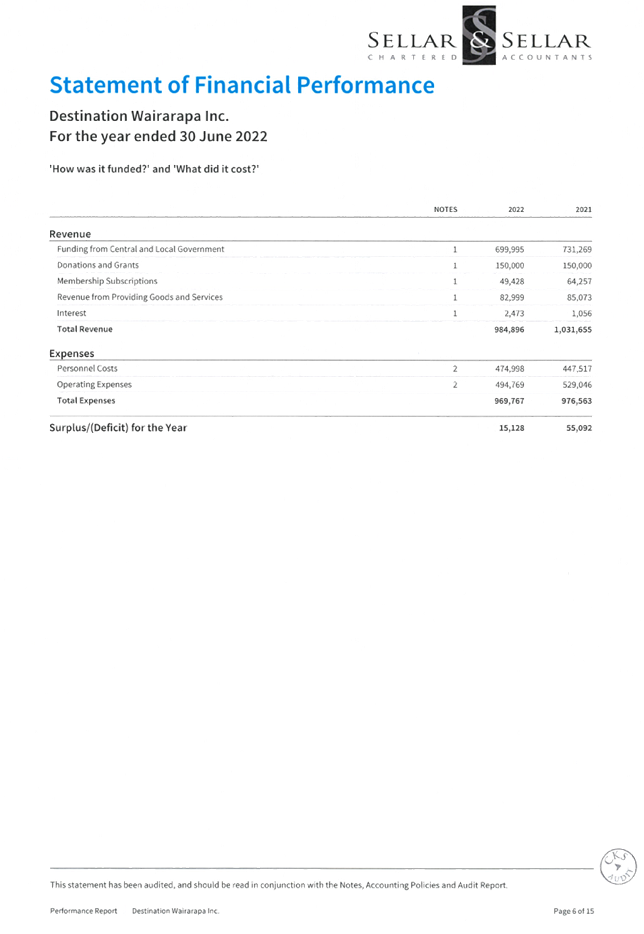
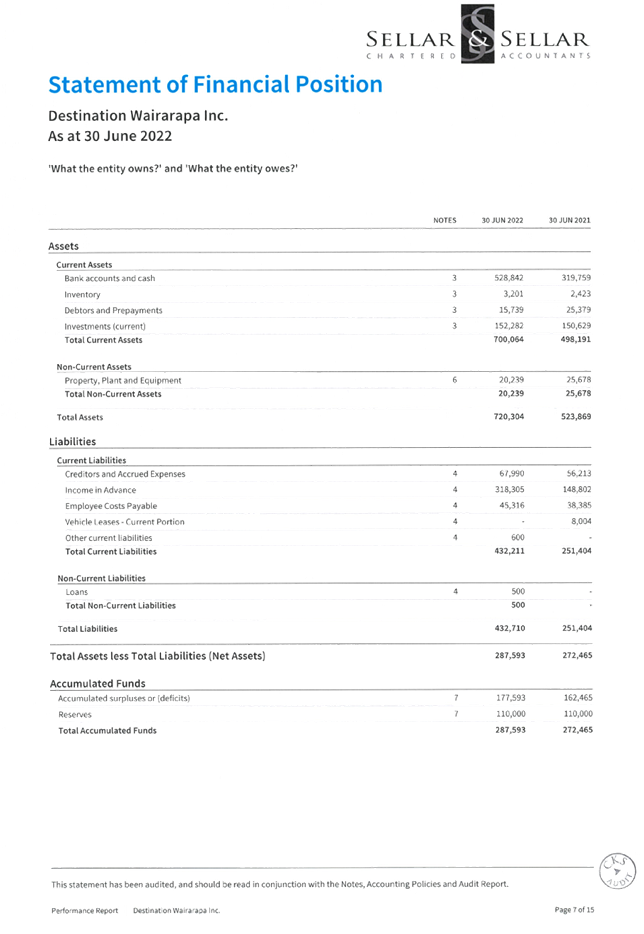
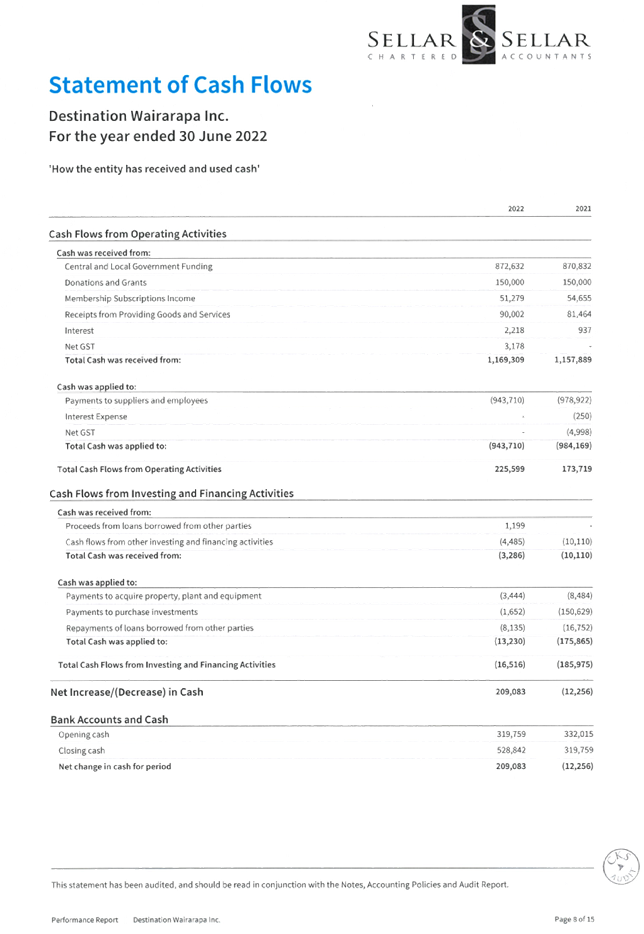
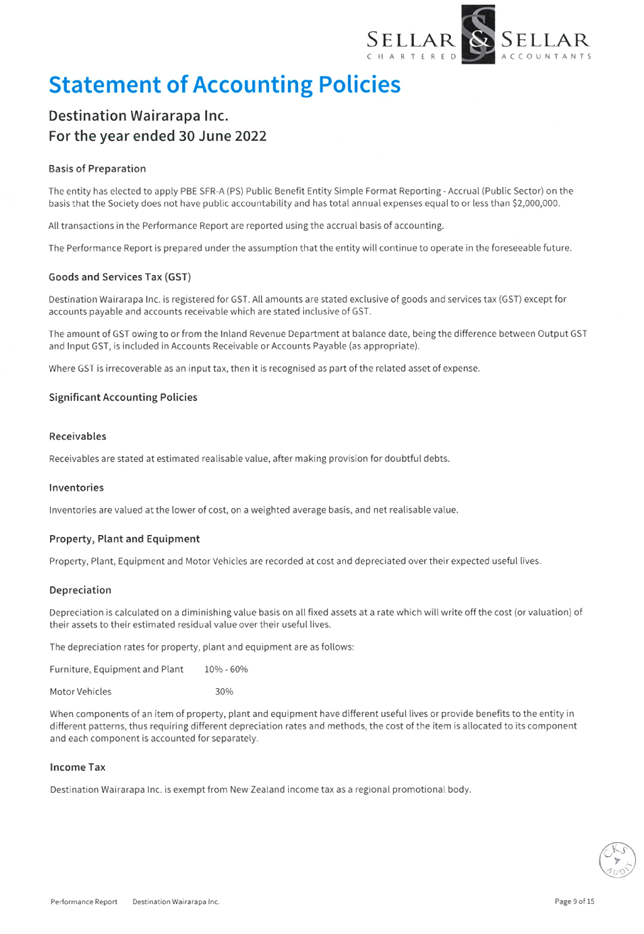
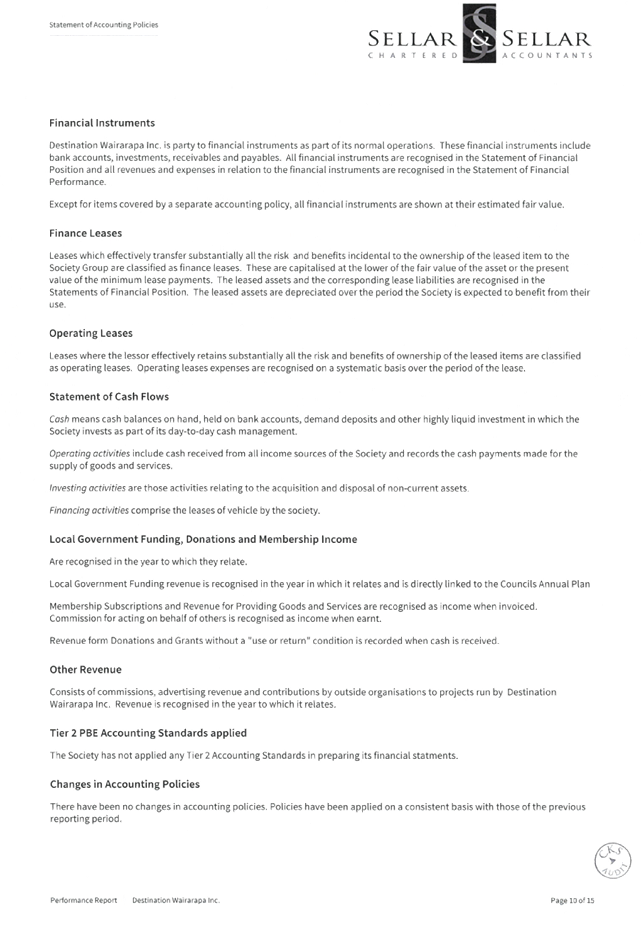
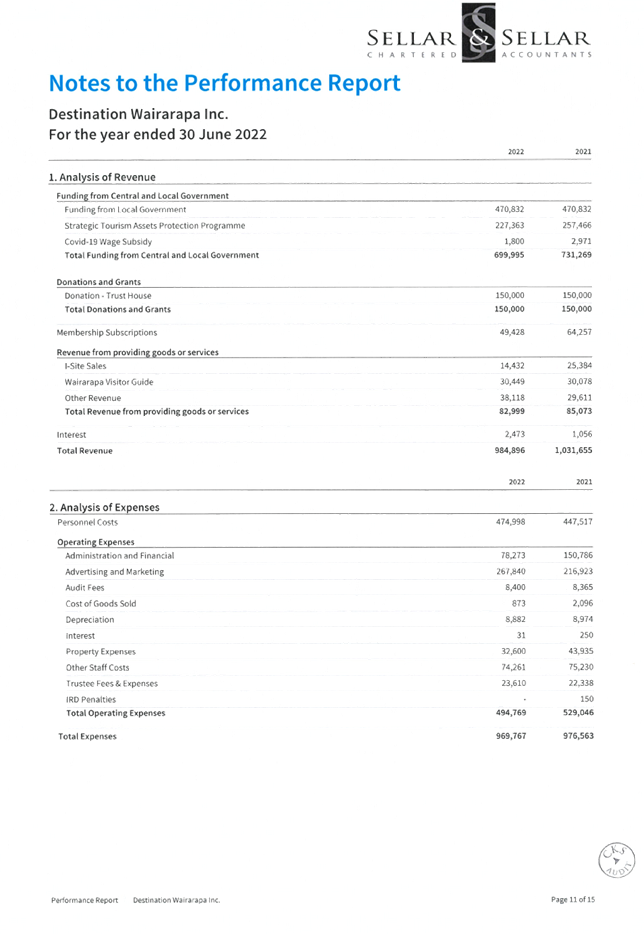
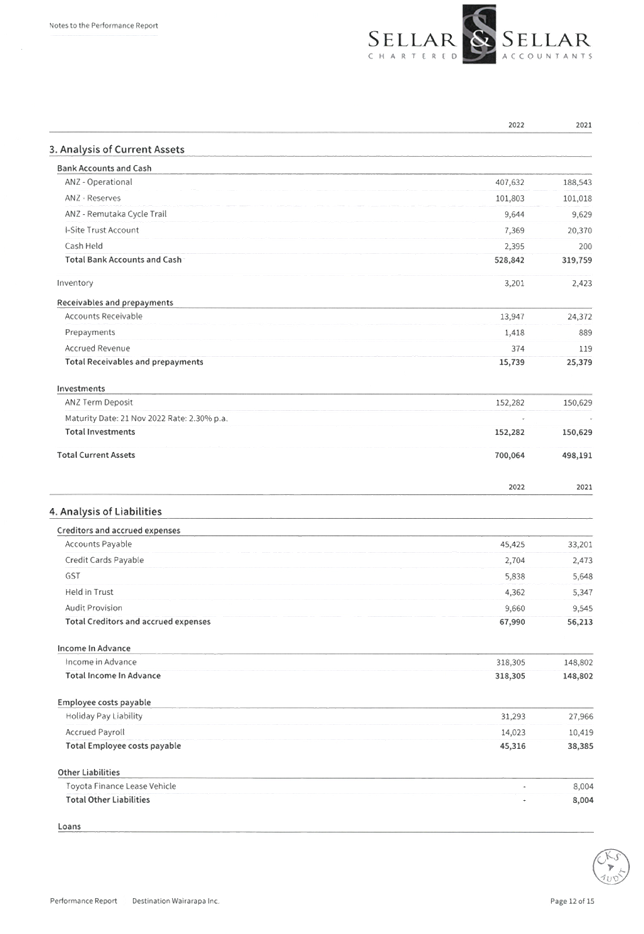
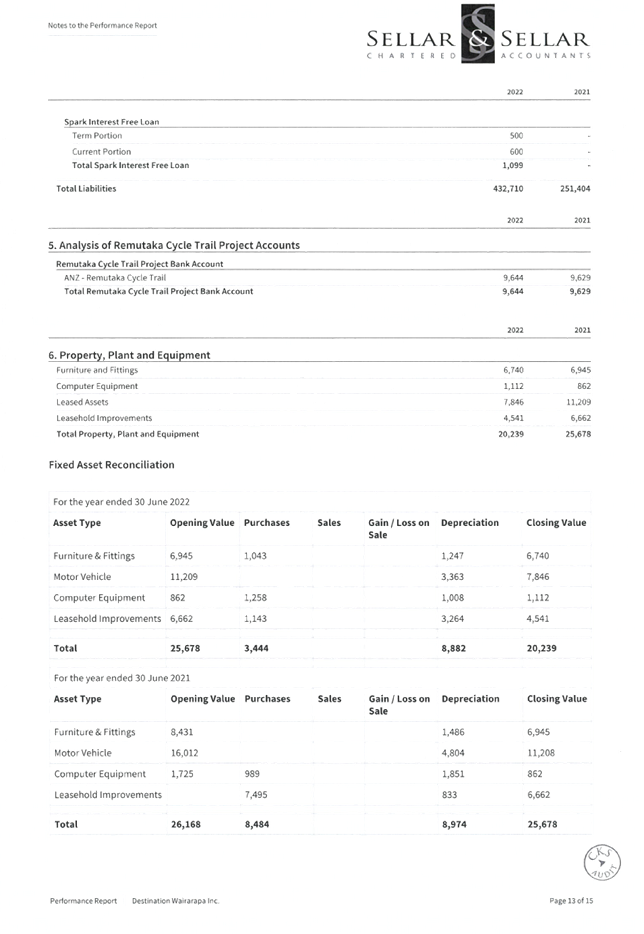
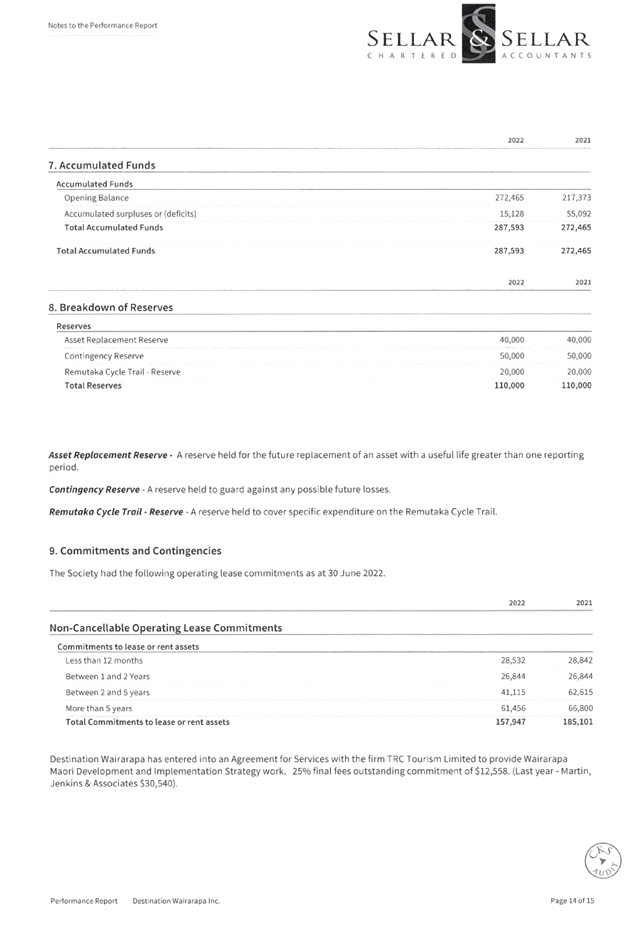
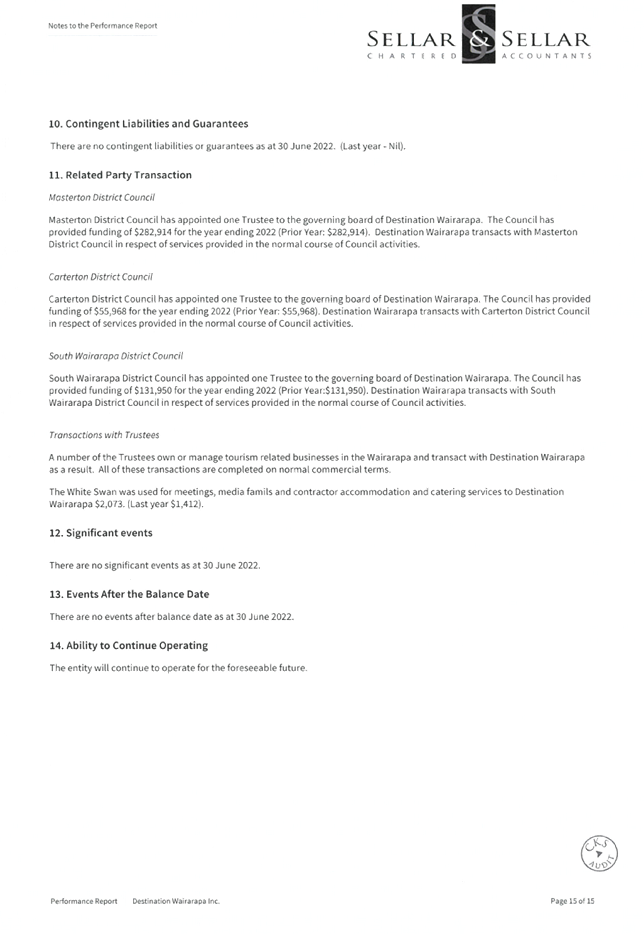
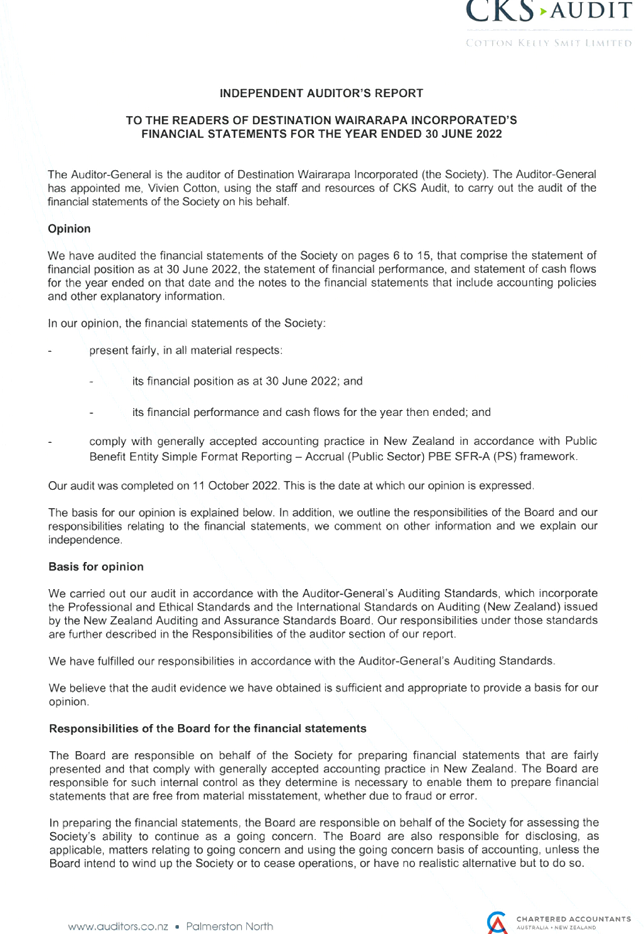
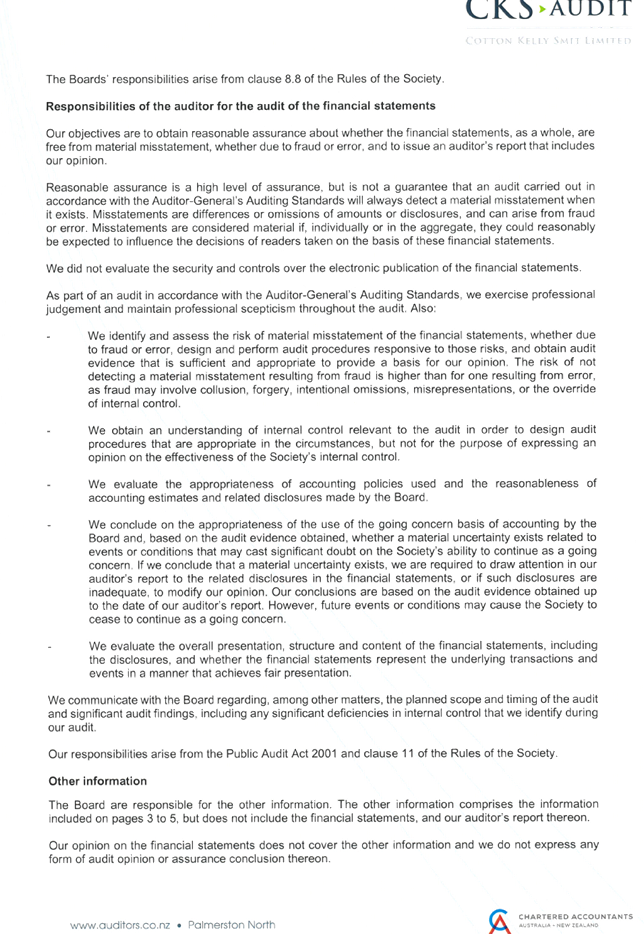
|
Ordinary
Council meeting Agenda
|
7
December 2022
|
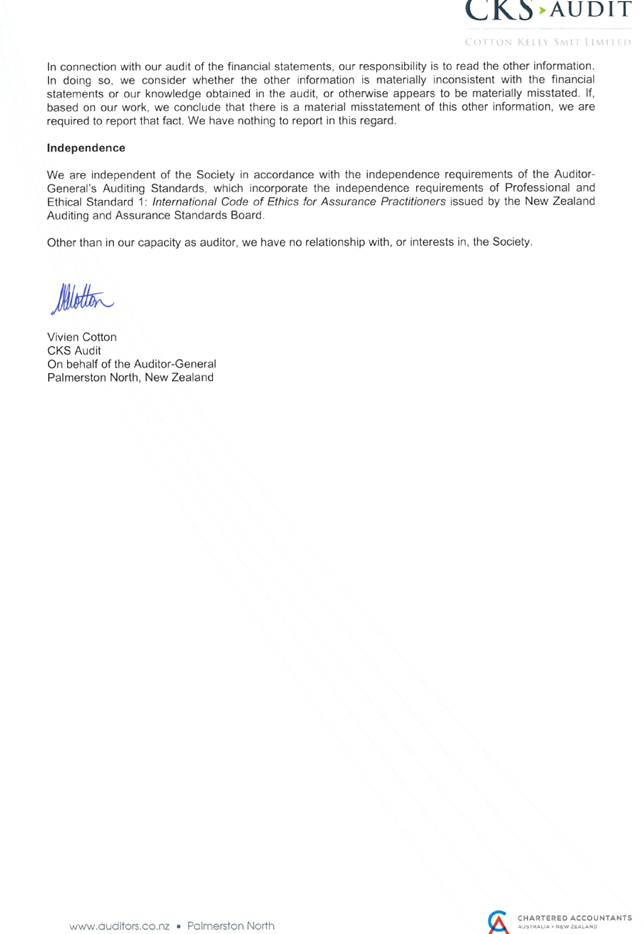
7.3 Three
Waters Reform Update
1. Purpose
To provide Council with an update on Central
Governments Three Waters reform.
2. Significance
The
matters for decision in this report are not considered to be of significance
under the Significance and Engagement Policy.
3. Background
The Government’s Three Waters
Reform proposal is a comprehensive change to the way fresh water, wastewater
and storm waters are managed for our communities.
The reforms shift the current 67
council-owned and operated three waters services into four new publicly owned
entities to manage the future delivery of these services from July 2024.
Below is a high-level timeline of events in respect of the reforms to date.
|
July 2021
|
Along with announcing the Three Waters Reform, the Government also
announced an initial funding package of $761 million to provide a post
COVID-19 stimulus to maintain and improve water three waters infrastructure,
support a three-year programme of reform of local government water service
delivery arrangements (reform programme), and support the establishment of
Taumata Arowai, the new Waters Services Regulator.
The initial stage and Request for Information (RFI) process was an
opt-in, non- binding approach. It did not require councils to commit to
future phases of the reform programme.
In July 2021 the Government mandated the reforms on all Councils.
|
|
September 2021
|
Council
submitted its feedback to Government on the
Three Waters Reform.
|
|
October 2021
|
The
Government announced they would be progressing the Three Waters Reform. You
can watch the announcement and read a summary of local Government feedback on
the proposal on the DIA website.
|
|
December 2021
|
Economic Regulation
Consultation took place calling for feedback from Councils on the
design of the economic regulation and consumer protection for the future
Three Waters system. This closed Monday 20th of December.
A joint submission by Wellington Region Councils was put to
Carterton Councillors and endorsed at the December 15th, 2021, meeting.
View CDC’s report submission on economic regulation for
three waters
Working Groups
Following feedback from Councils published in October, the
Government established three independent working groups to refine elements of
the Three Waters Reform programme,. The working groups were;
· Working Group on Representation,
Governance and accountability
· Planning Technical Working Group
· Rural Supplies Technical Working Group
Water Services Entities Bill
The Government announced the Three Waters Entities Bill will be
delayed in order to give the working group time to recommend changes to
governance and accountability. Draft legislation has been prepared and will
be made public, giving the working group until 28 February to report back and
recommend any changes. The Bill would be introduced to Parliament shortly
after this.
|
|
June 2022
|
On 2 June 2022, the Government announced legislation which will
enable the creation of the new Water Services Entities (WSEs). National
consultation opened on 10 June 2022.
As well as setting up the new WSEs so they can be ready by 1 July
2024, the Bill locked in council “ownership” of the WSEs on
behalf of the communities. Councils will have one share per 50,000 people in
their area, rounded up – so each council will have at least one
share. The share will hold no voting rights, carry no financial value,
receive no dividends but will allow Council to vote for or against future
privatisation of the WSE (requires 75% majority).
The legislation tries to balance community participation in the
running of the new water organisations with Council and Iwi oversight, while
giving WSEs the financial and operational independence they need to get on
with the job.
Read the Bill online at legislation.govt.nz.
|
July 2022
|
Three Waters Council Transition Support Package
On the 19 July 2022, the Associate Minister of Local Government
Kieran McAnulty announced a $44 million support package for councils to
support activities relating to three waters reform. See link Government provides Three Waters support for
councils | Beehive.govt.nz
This transition funding is in addition to the wider
Government backing for the Three Waters Reform package, which includes $2
billion Better Off funding for Councils to deliver community wellbeing
initiatives (of which CDC is allocated $6.8m), and $500 million for No Worse
Off funding – yet to be allocated to Councils.
This additional Three Waters Services support funding is
designed to cover the extra costs council will incur due to the mandatory
requirement to participate in the reforms.
Each council, regardless of their size, will receive a
minimum of $350,000 over 12 months.
View attachment 1 Three Waters Services Reforms
– Transition Support Package (tranche 1)
Submission on Waters
Services Entities Bill
The Chair of the
Government Finance and Expenditure Committee called for public submissions on
the Water Services Entities Bill.
CDC made a submission on
the 21 July 2022.
View CDC’s submission to the Finance and Expenditure Committee
|
|
September
2022
|
Better
Off Funding Package
The
Government has allocated $2b towards a Better Off funding package for local
Councils. This is being paid over two tranches, with the first tranche
open until 30 September 2022 and the second becoming available in July 2024,
when the Water Services Entities take over control of water assets and
services.
Funding
is split with 25% available in tranche 1 and 75% in tranche two.
Carterton
District Council was allocated a total of $6.8m in Better Off Funding, with
$1.7m becoming available in under tranche 1.
CDC
submitted an application for tranche 1 funding in September 2022.
The
Department of Internal Affairs has delegated responsibility for managing the
Better Off Funding to Crown Infrastructure Partners (who also managed all PGF
Grants). We expect to hear the status of our application in early
December.
|
|
November
2022
|
On 11 November the Finance and Expenditure Select Committee issued
its report on the Water Services Entities Bill (#1).
This first Bill establishes four publicly owned dedicated Water
Services Entities with a view that these entities will provide safe,
reliable, and efficient water services through improved investment and
management.
The Committee considered over 80,000 submissions on this
legislation. As a result of submissions, approximately 130 amendments have
been made to the Bill. A summary of the amendments in attachment 2 Select Committee Report
Summary.
View
the full committee report here NZ Parliament website.
Following
a late-night reading of the WSE Bill, an amendment was introduced, and
adopted by Government to entrench public ownership of water assets by a 60%
Parliamentary majority. Labour and Green MPs voted for the change to
the Government’s Water Services Entities bill though the Bill has not
yet been made law.
The
Government had previously sought cross-party consensus to entrench
public ownership in law asking all parties to join forces
to create a 75% majority threshold like that seen in electoral law. While the
National Party said it had no plans to sell off water assets, it did not
support entrenchment of Three Waters Reforms legislation.
|
4. DISCUSSION
A Moving Target
In June 2022 Cabinet considered on policy matters to ensure the new Water
Services Entities have the necessary legislative functions, duties, and powers
to be fully operational from their ‘go live’ date on 1 July
2024. The full Cabinet
Paper Policy proposals for three water service delivery legislative settings.
These decisions
included that, consistent with a recommendation from the Rural Supplies
Technical Working Group, users of council-owned mixed use rural water can
choose to directly own and operate their schemes, independent of a Water
Services Entity.
Following the Select
Committee recommendations it appears “Rural Water” has now been
included in the WSE legislation (Bill #1) moving to the new WSE’s on 1
July 2024. We are seeking feedback from DIA on what Rural Water
includes, however we do not have an answer to this question at this time.
We are hopeful this change just pertains to potable (drinking) water, and that
it does not include Rural Water Races – used for stock water.
The second WSE
Amendment Bill (Bill #2) builds on the previous WSE legislation and provides
the legislative framework for the WSE’s to operate. This includes
transferring or extending powers that Council have to the WSE under other
legislation such as Public Works Act, Taumata Arowai, Local Government Act,
Health etc. Some of the changes include:
• Rural
water and the transfer of rural drinking water supplies to WSE, along with
exceptions.
· Local
Government Authority (LGA) – repeal and transfer of all legislative
obligations, functions and duties on councils with respect to water to be
transferred to WSE unless there is a reason to update or change these.
Under the LGA this includes:
o transfer of functions from councils to WSE including water
services, trade waste, fire hydrants (Councils stay involved in decision making
regarding location of fire hydrants)
o WSE will have some Civil Defence functions
o WSE obligations will include a need to assess community
needs including from public health and environmental perspective and involve
TAs and regional councils in these
· Treaty
settlements: Treaty settlements to be enduring and transfer from councils to
WSE. This will include a stocktake of Treaty settlement legislation and
arrangements and engagement with Iwi:
· Bylaws: transitioning out of bylaws:
o Notes WSE will not have same bylaw making powers, and
relevant bylaws will be replaced by legislative instruments similar to other
utility providers
o Councils will no longer have powers to make bylaws on
matters where responsibility will transfer to WSE
o Councils to review and where necessary revoke bylaws on the
transition date
· Catchment areas: WSE will have powers to specify land as a
controlled drinking water area
· Offences and penalties: as there is a move away from
bylaws, Bill will enable a new infringement regime and penalty system modelled
on LGA and RMA. These are set out in Appendix B and include powers for
injunctions, entry and infringement
· Finance arrangements: WSE to be subject to bespoke finance
and prudential framework. Notes that WSE will have access to a Crown
liquidity facility similar to LGFA terms.
We anticipate the WSE
Bill 1 will pass into law prior to Christmas, and the WSE Amendment Bill (Bill
2) to be introduced into Parliament at the same time (i.e. before the House
rises for 2022).
A third WSE Bill (Bill
#3) is also anticipated to be introduced into Parliament prior to
Christmas. This Bill is being prepared by MBiE, not the DIA, and is
referred to as The Water Services Economic Efficiency and Consumer Protection
Bill, focusing on economic regulation.
Two
Engagement Models
The DIA National Transition Unit (NTU)
have created Local Transition Teams (LTT) as part of the transition phase of
Three Waters Reforms. Entity C LTT includes representation from the 22
councils along with Wellington Water attending. The LTT engagement model is as
follows:

In addition,
the NTU has agreed to create a Chief Executive forum to address strategic and
material issues with the reforms directly between stakeholders.
However,
after a significant amount of pressure from the CEOs, the NTU acknowledged
their LTT engagement model does not include any Mana Whenua
representation. The NTU appear to have been slow off the mark with Mana
Whenua engagement and this only now appears to be taking place.
The NTU engagement
with Mana Whenua is difficult to quantify, as this is a separate process not
including LTT / Council representatives. It appears the NTU is engaging
with post-settlement Iwi groups (PSGE’s) but it is not clear at what
level within these groups. Furthermore, it does not appear the NTU is
planning on engaging with hapū either now or at any time in the future
– preferring to limit their korero to just the PSGE’s.
The risk of
having two separate and disparate engagement models run by different parts of
the NTU discussing all aspects of the transition cannot be understated.
The potential for decisions and discussion in one group to impact the other
groups remain very high indeed.
We will
continue to push for alignment of these two engagement models to simplify the
transition process, improve understanding, expand the participation to all
stakeholders in transition issues, and reduce the risks to our communities with
this significant work programme.
5. NEXT
STEPS
Management
will continue to participate with the NTU and LTT on Three Waters Reforms
transition and keep Council informed of updates and changes.
We
anticipate the Water Services Amendment Bill (Bill #2) public consultation will
open prior to Christmas, however it is unlikely much in this Bill will be
controversial as it is mostly transferring existing powers to the
WSE’s.
The
third piece of legislation, The Water Services Economic Efficiency and
Consumer Protection Bill (Bill #3) will likely have more impact on our
community. Management will work with the other Wellington Region Councils
to formulate our response to this legislation when it opens for consultation.
6. CONSIDERATIONS
6.1 Climate change
Considerations have been noted in
the report, as appropriate.
6.2 Tāngata whenua
As
mentioned above, the Crown engagement with Mana Whenua on the Three Waters
Reforms programme has not progressed as rapidly as engagement with
Councils. This may lead to disparity of information between the
respective stakeholders.
Management
will continue to share information and our submissions with Hurunui-o-Rangi and
Ngāti Kahukuraāwhitia hapū as and when appropriate, noting
Masterton District Council usually shares their feedback with the two main
PSGE’s.
6.3 Financial
impact
Considerations
have been noted in the report above and include grant funding, transition
costs, the transfer of Three Waters assets at no cost to the WSE’s, the
transfers of Three Waters debt, and a potential for stranded overheads which is
yet to be determined.
6.4 Community
Engagement requirements
Three
Waters Reforms is a Government-mandated programme. Consistent with
previous Council decisions CDC community engagement on a Government programme
is unlikely to effect meaningful change for our ratepayers.
Management
will continue with updates to Council on the reforms, and with the impacts of
these reforms have on our organisation and community as they are able to be
quantified.
6.5 Risks
Management
consider the risk of the Three Waters Reforms not proceeding as increasing over
the past few months. This is obviously dependent on the national
election in late 2023. A pause, or complete stop to the Three Waters
programme will create a significant amount of disruption to the
organisation. Some staff who may have been looking forward to moving into
a WSE may decide to leave seeking new opportunities elsewhere.
If
the reforms proceed, the impact of removing Three Waters functions from Council
remains a risk. Specifically, the ongoing viability of a small rural
Council servicing less than 10,000 residents may come into question post the
implementation of WSE’s.
7. Recommendation
That the Council:
1. Receives
the report.
File
Number: 317724
Author: Geoff
Hamilton, Chief Executive
Attachments: 1. Three
Waters Services Reforms – Transition Support Package (tranche 1) ⇩
2. Select
Committee Report Summary ⇩
|
Ordinary
Council meeting Agenda
|
7
December 2022
|
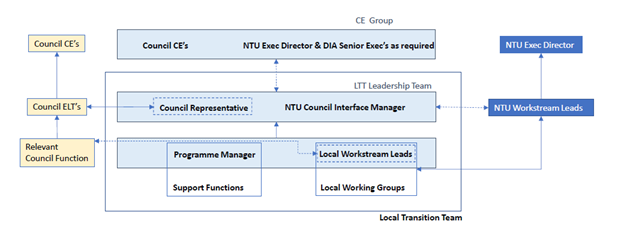
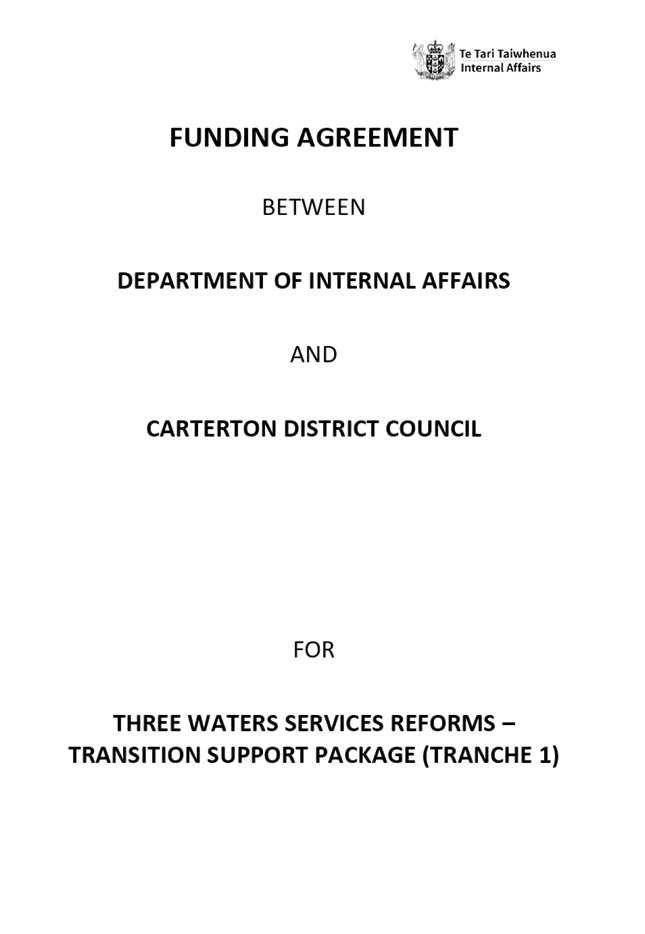


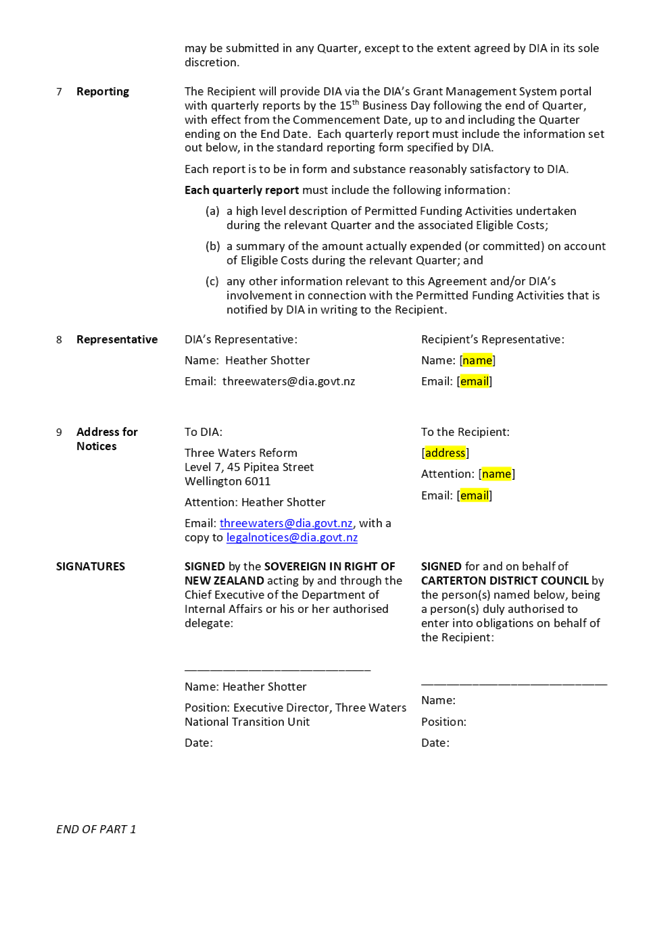
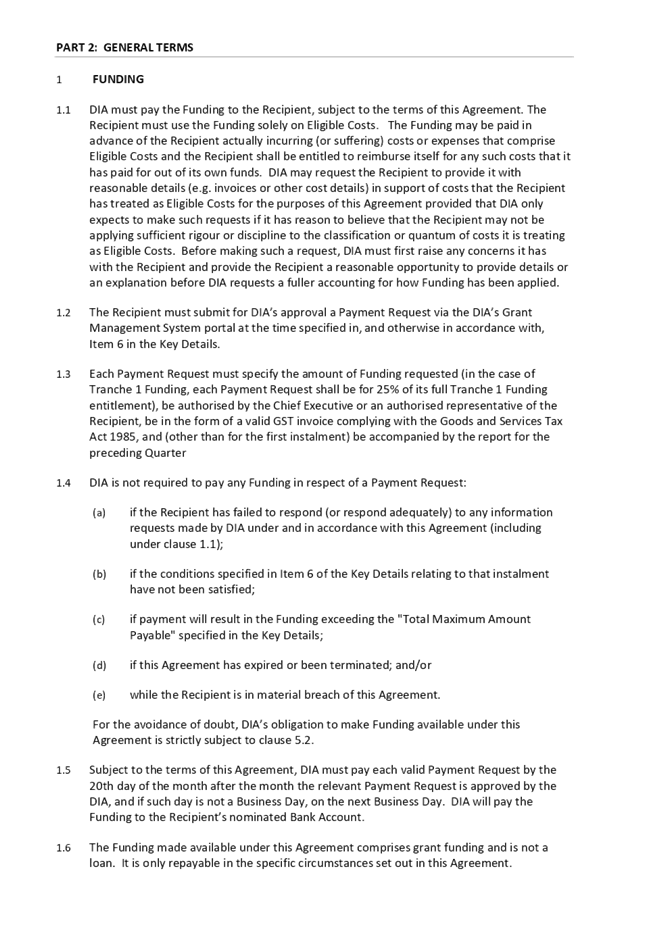
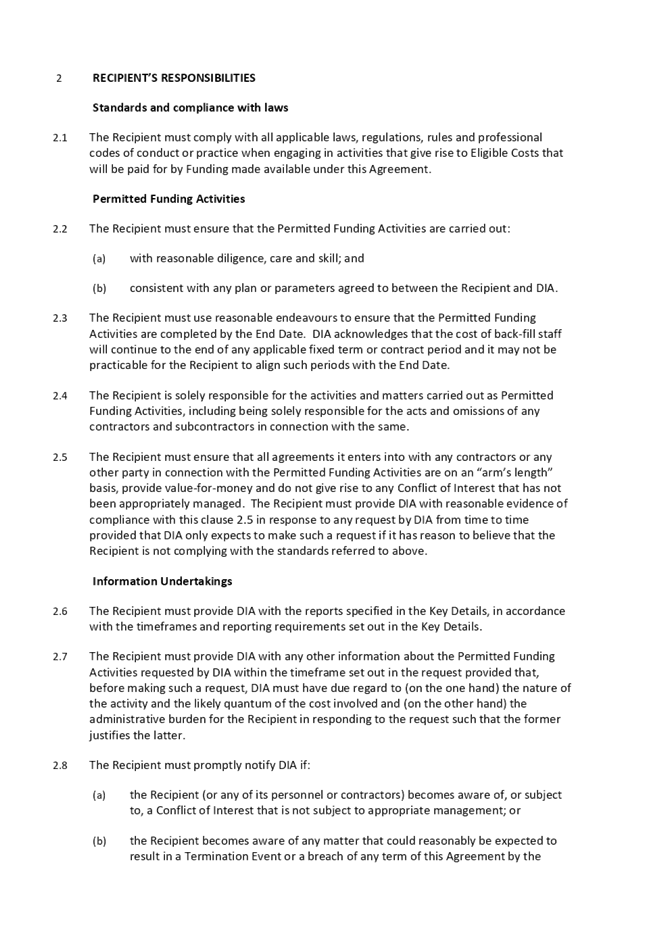
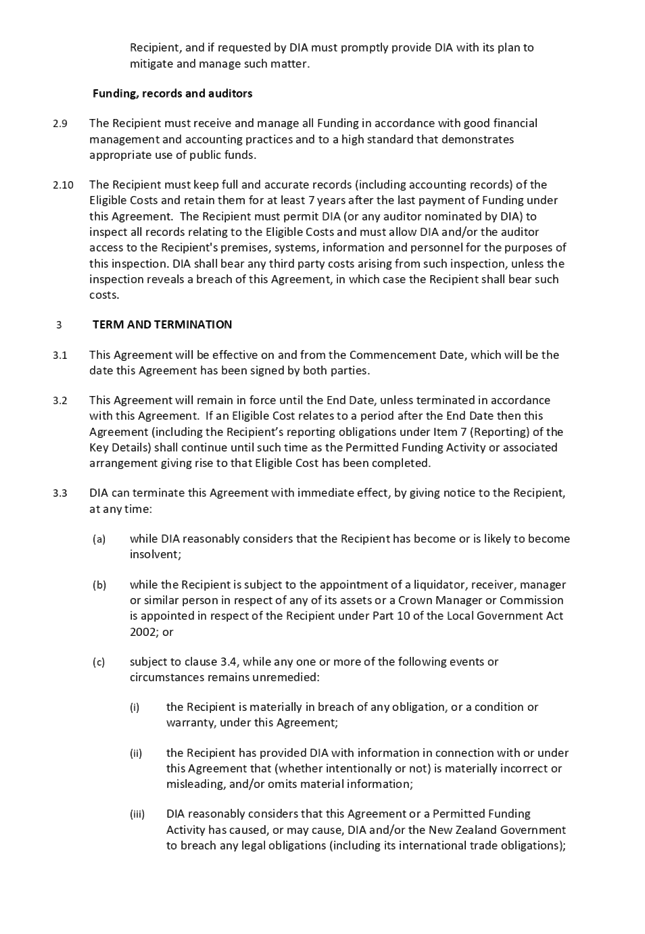
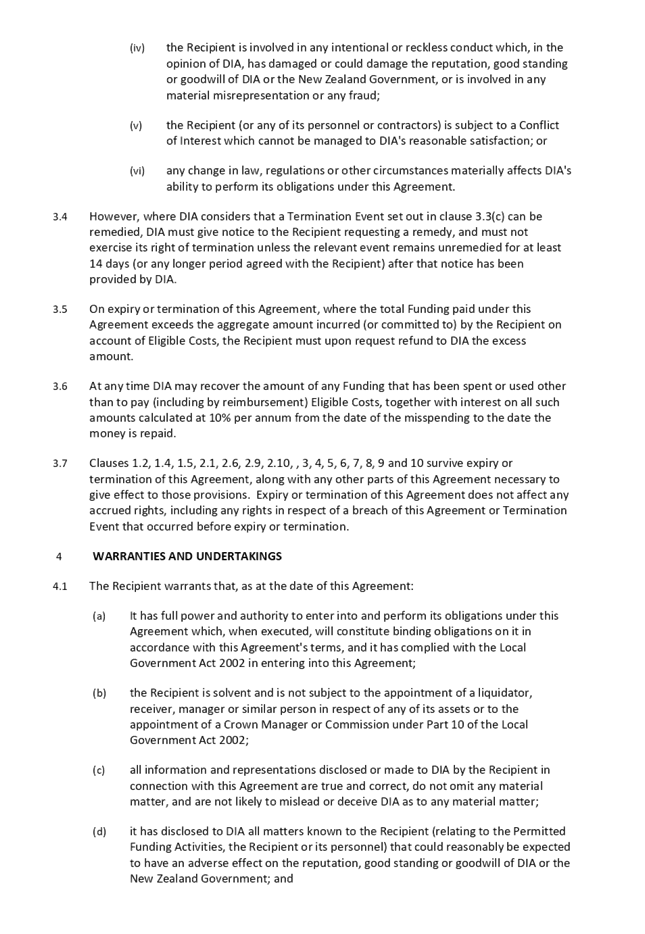
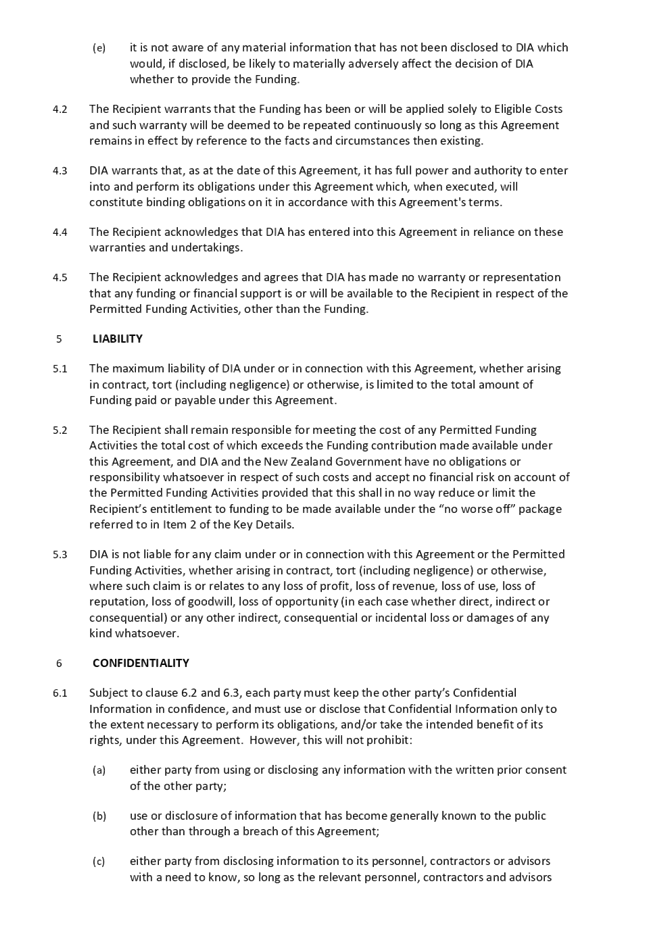
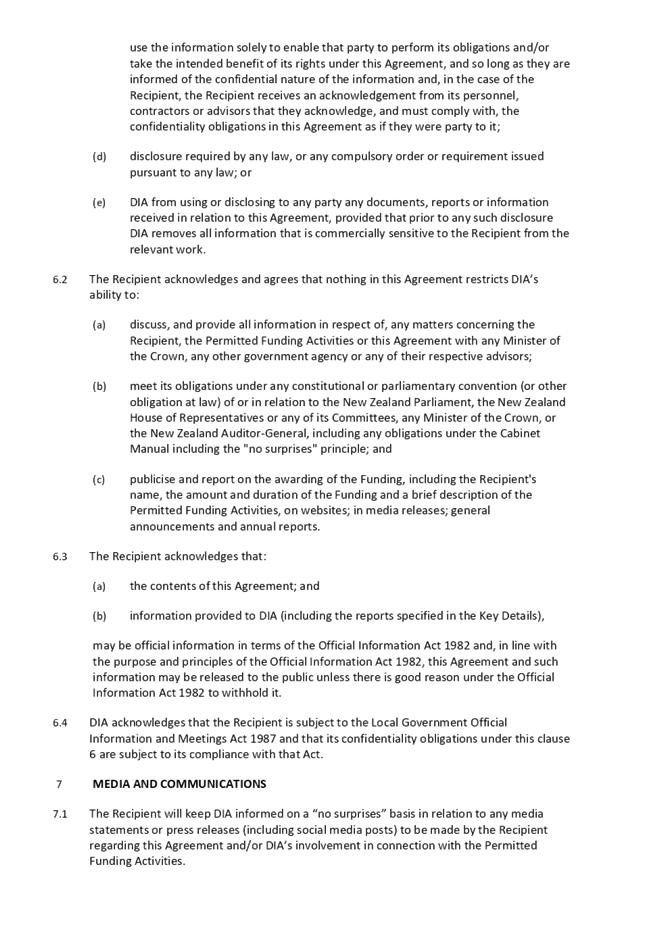
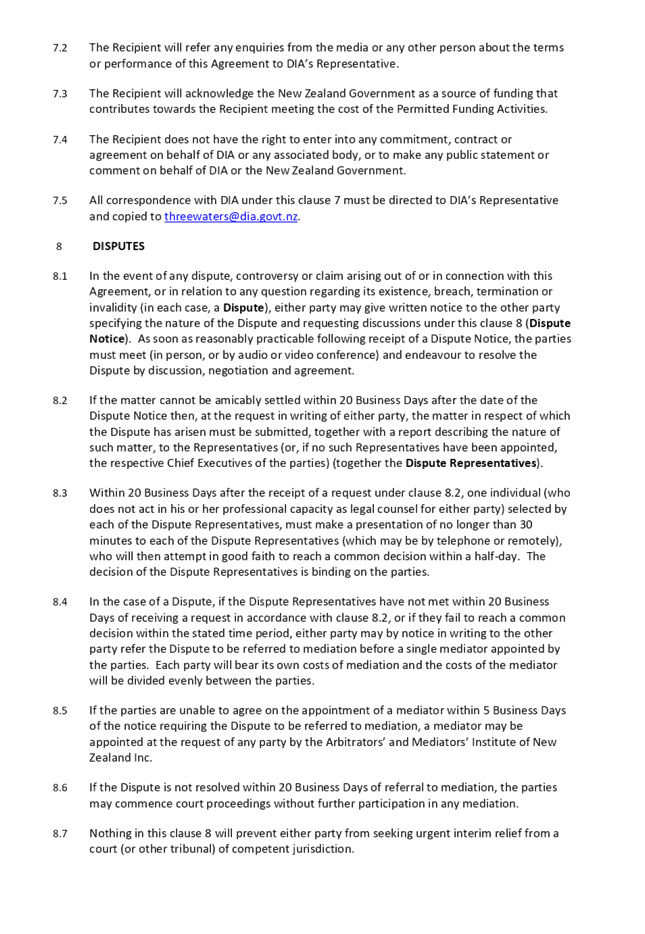
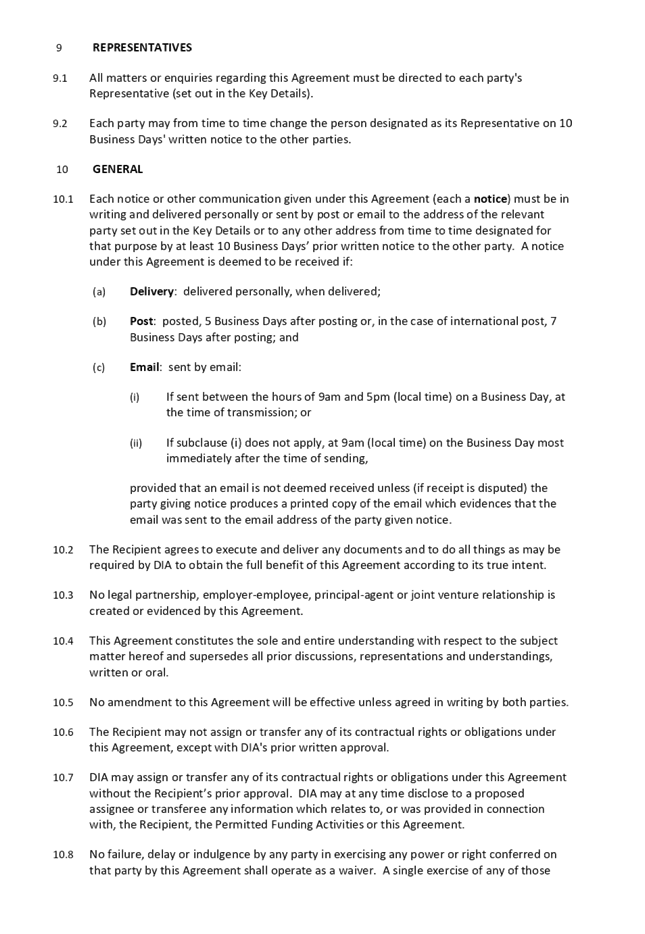

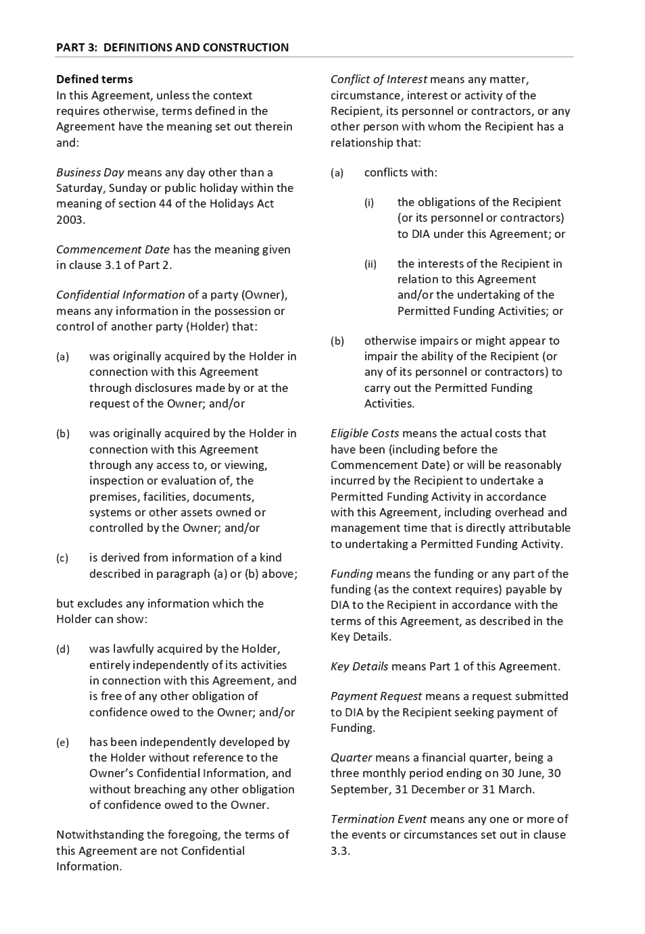

|
Ordinary
Council meeting Agenda
|
7
December 2022
|

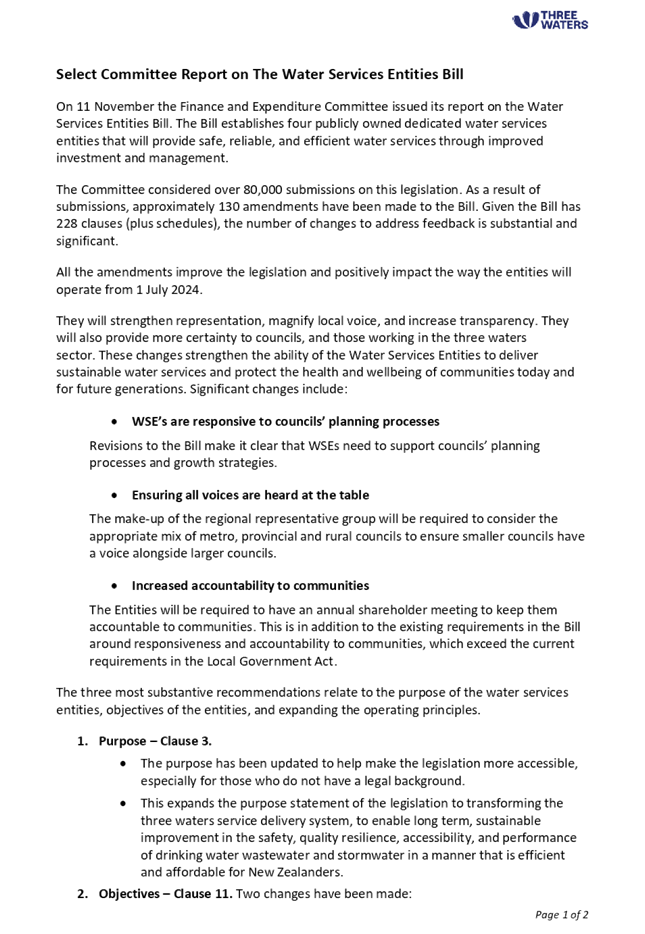
|
Ordinary
Council meeting Agenda
|
7
December 2022
|
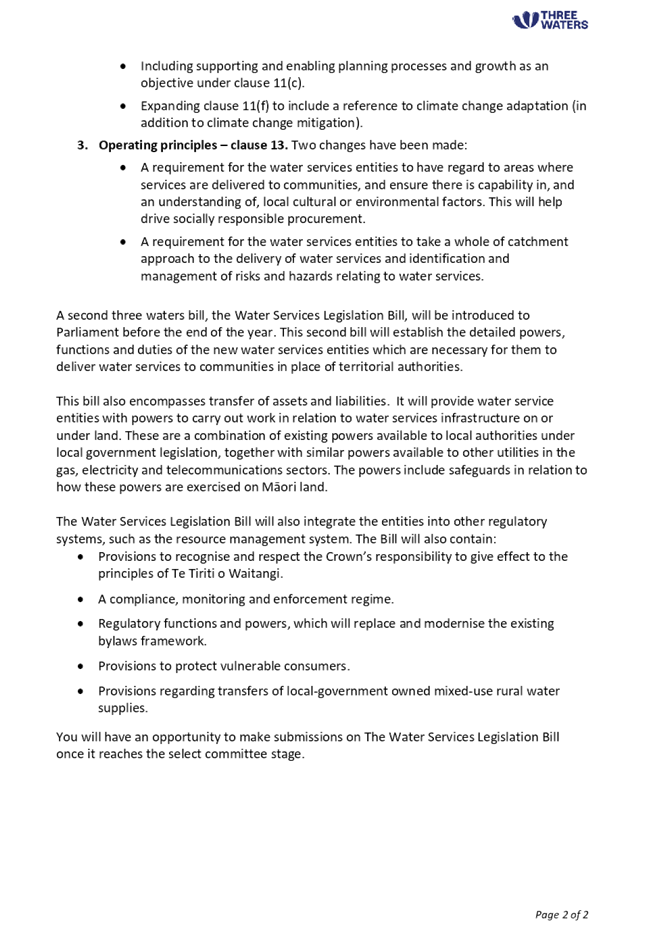
7.4 Draft
Interim Speed Managment Plan
1. Purpose
For the council to be
informed about the draft Interim Speed Management Plan (ISMP).
2. Significance
The
matters for decision in this report are not considered to be of significance
under the Significance and Engagement Policy.
3. Background
The
development of the ISMP aligns with the Government Statement Policy (GPS) on
Land Transport 2021 and the Land Transport Rule: Setting of Speed Limits.
One
of the strategic priorities in the GPS is Safety – Developing a transport
system where no one is killed or seriously injured. Furthermore, the Land
Transport Rule: Setting of Speed Limits gives effect to a new regulatory
framework for speed management and the requirements for safer speed limits
around schools.
Road
Controlling Authorities (RCAs) are required to work collaboratively with their
regional transport committee and Waka Kotahi to produce regional speed
management plans, set out speed management treatments in the region over a
10-year period. These plans will be developed every six years, and will be
updated every three years, to align with the land transport planning process.
Waka
Kotahi (as the regulator) is responsible for certifying regional speed
management plans.
RCAs
must ensure speed limits for roads outside at least 40% of the schools directly
accessed from roads under their control comply with the new speed limits by 30
June 2024 and all roads outside schools comply with the new speed limits by 31
December 2027.
4. Discussion
Tonkin
and Taylor have prepared the Draft ISMP on behalf of CDC and SWDC. We are
currently at step 2 of 8, seeking views from key stakeholders prior to second
draft. Please see the process below:

Image
– ISMP, page 38
Officers
are currently reviewing the detail within the ISMP to ensure completeness and
accuracy.
5. CONSIDERATIONS
5.1 Climate change
The
matters in this report do not directly relate to climate change migration or
adaption issues.
5.2 Tāngata whenua
Safety
around schools and Marae is a priority and therefore of interest to Māori.
5.3 Financial impact
The
work on development and implementation of the ISMP will be funded through the
LTP under Low-Cost Low Risk – Road to Zero.
5.4 Community Engagement
requirements
The
community has not been involved in the development of the ISMP, however public
consultation is planned at step 4 above, which Management anticipates to be
early 2023.
5.5 Risks
The
requirements of the Land Transport Rule are mandatory for RCA’s.
Council is therefore obliged to comply. This Interim Speed Management
Plan forms part of our ongoing compliance and management of local roads.
6. Recommendation
That the Council:
1. Receives
the report.
2. Adopts
the principles and priorities of the Interim Speed Management Plan.
3. Notes
Management propose to proceed with public consultation on the draft Interim
Speed Management Plan in early 2023.
File
Number: 319285
Author: Johannes
Ferreira, Infrastructure Services Manager
Attachments: 1. Draft
CDC and SWDC Interim Speed Management Plan (under separate cover) ⇨
|
Ordinary
Council meeting Agenda
|
7
December 2022
|
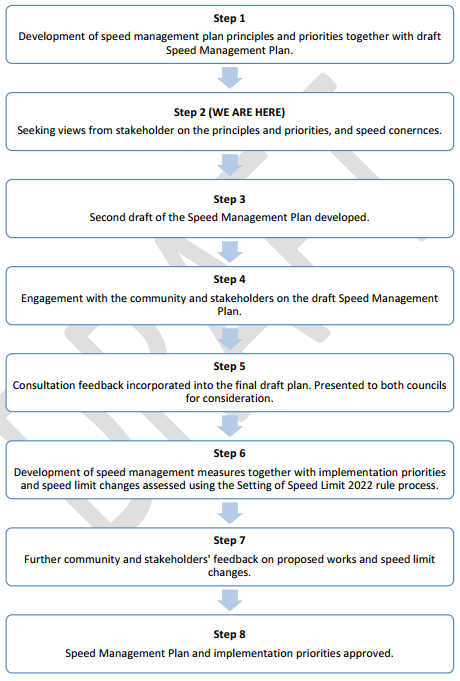
7.5 Submission:
Proposed Change 1 to the Regional Policy Statement (RPS) for the Wellington
Region
1. Purpose
The purpose of this
report is to provide the Council with the submission response to Greater
Wellington Regional Council’s (GWRC) proposed change 1 to the Regional
Policy statement (RPS) for the Wellington region.
2. Significance
The
matters for decision in this report are not considered to be of significance
under the Significance and Engagement Policy. Providing a submission to other
government entities is a business as usual activity for Council and is not
considered significant under the policy.
3. Background
The
Regional Policy Statement (RPS) sets out the framework and priorities for
resource management in the Wellington region. The Resource Management Act 1991
(the Act) requires all regional councils to produce an RPS for their region and
review it every 10 years.
The
main purpose of the Act is “sustainable management of natural and
physical resources”. In context, sustainable management means development
that meets the needs of the present without compromising the ability of future
generations to meet their needs.
4. Discussion
The
focus of the Proposed
RPS Change 1 is to implement and support the National
Policy Statement on Urban Development 2020 (NPS-UD) and start the
implementation of the National Policy Statement for Freshwater Management 2020
(NPS-FM).
Carterton
District Council made a submission on the on the proposed Change 1 to the
Regional Policy Statement for Wellington Region [See attachment 1; CDC
Submission for Proposed Change 1 Regional Policy Statement].
5. CONSIDERATIONS
5.1 Climate
change
Carterton
District Council supports a partnership approach with the community in
mitigating and adapting to climate change. Funding will need to be allocated
for this.
While
CDC supports the RPS providing clear goals for emission reduction, it is
concerned that there will be inequities in the way these targets are intended
to be met. As CDC is predominantly a rural environment, with the town
functioning as a rural service area, the transport emissions targets are
potentially unrealistic for Carterton and the wider Wairarapa.
Our
submission noted our support for the increase in permanent forest across the
region, but was concerned that the Wairarapa will be disproportionately
affected by an increase in carbon farming and that we did not want to see the
Wairarapa becoming a carbon sink to offset emissions that are created by other
Councils in the region.
5.2 Tāngata whenua
In
its submission Carterton District Council commented on Chapter 3.4 : Fresh
Water, supporting the inclusion of statements from Rangitāne o Wairarapa
and Kahungunu ki Wairarapa. However, it was suggested that there needs to be
improved linkages with other objectives or policies to better understand how to
give effect to the statements.
5.3 Financial impact
No
financial impacts identified for the purpose of receiving this report.
5.4 Community Engagement requirements
N/A
5.5 Risks
N/A
6. Recommendation
That the Council:
1. Receives
the report
2. Ratifies
the submission made by Management of the Proposed Change 1 to the Regional
policy Statement.
File
Number: 317331
Author: Solitaire
Robertson, Planning and Regulatory Services Manager
Attachments: 1. CDC
Submission for Proposed Change 1 Regional Policy Statement ⇩
|
Ordinary
Council meeting Agenda
|
7
December 2022
|
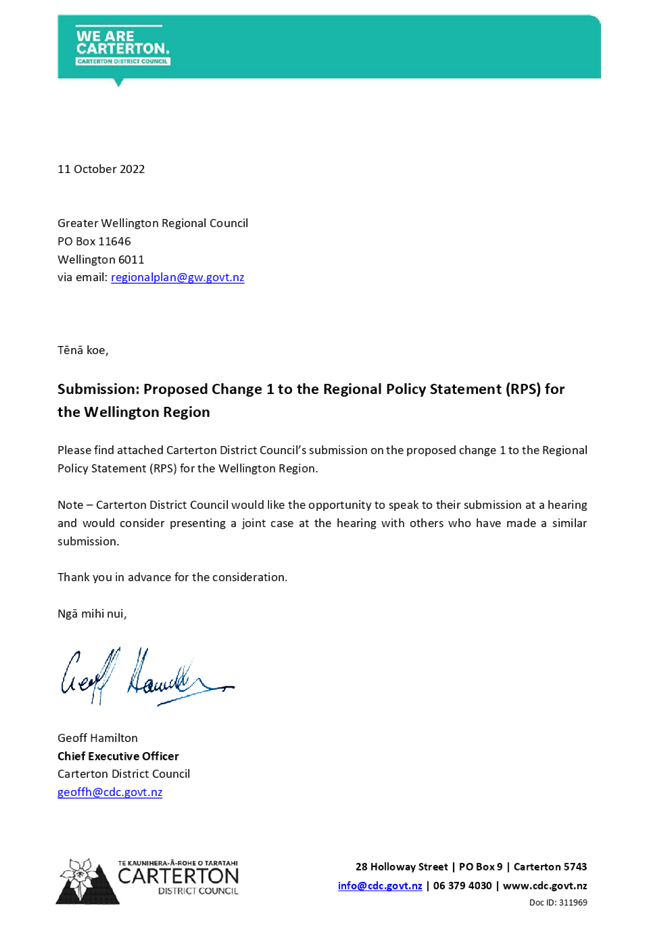
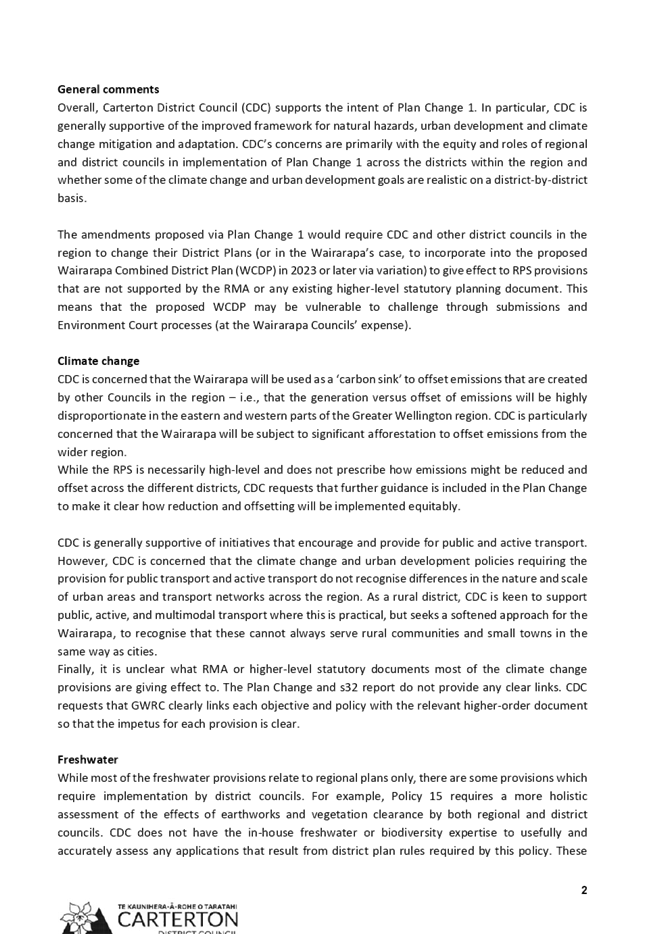

|
Ordinary
Council meeting Agenda
|
7
December 2022
|

7.6 New
Road Name
1. Purpose
For the Council to
give consideration to three suggested proposals for new road names.
2. Significance
The
matters for decision in this report are not considered to be of significance
under the Significance and Engagement Policy.
3. Background
On 29
November 2022 Council officers received suggestions from a developer to name
roads to be vested in Council as part of their development.
Corsair
Development Limited undertook a 71 lot residential subdivision located at Kent
Street. Due to the number of lots being created it was proposed to vest
the road to Council. As such, the road is required to be formally
named. Approval of new road/street names is delegated to Policy
and Projects Committee or full Council. This delegation enables efficient decision-making
within legislative timeframes. The exception to this is if the recommended
road/street name is likely to be controversial. A copy of the subdivision is
shown below.
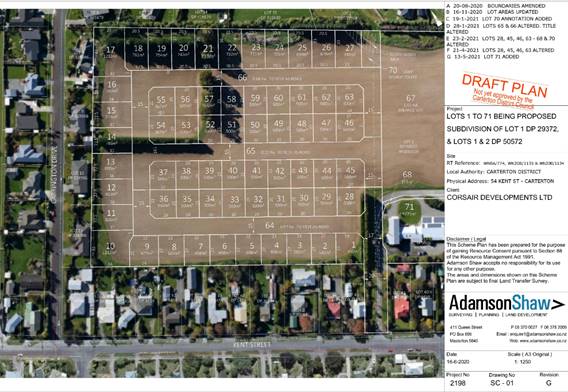
4. Discussion
Under the Local
Government Act 1974 (s.319A), Carterton District Council is responsible for
naming roads and streets in the district. Council reviewed its road
naming policy on 9 September 2020 and determined
the following:
Preference is given to
road/street names that, in relation to the site concerned, meet one of the
defined criteria. The criteria, in order of preference, are:
· recognition of
Māori cultural significance;
· recognition of
cultural significance other than Māori; reflection of the landscape or
topographical features;
· recognition of
historical events that have a significant impact on the community; or
· honouring local
residents who have made significant contributions to the Carterton district
(alive or deceased).
Road/street names are
also required to be unique and not duplicated in the Carterton district (in
spelling or sound).
Where new roads need
to be named as a result of a new subdivision or development, the developer
shall be given the opportunity of suggesting up to three options, in order of
preference.
5. Options
The
three proposed names provided to Council officers are as follows:
The first proposed
road name is Peaks Avenue. As noted above, Council adopted a criteria that was
based on an order of preference. The name for Road 1 fits with Council’s
second criteria being ‘recognition of cultural significance other than
Māori; reflection of the landscape or topographical features’. In an
email to Council officers the developer noted the following:
“First road
going into the development off Kent Street I would like to name “Peaks
Avenue”, reason being it clearly identifies the development name of
“Peaks Estate”, while also defining the view of the Tararua peaks
you see from all the development. Also, Peaks Avenue will become the new
official address of our export business NZDimensionz and so will be easily
identified and spelt by our many international customers. “
The second proposed
road name is the larger road within the development, being the first street to
the left off proposed Peaks Avenue, and will go right around to stage 3 and
connect back up to Peaks Avenue. The developer would like to name this
Kākāriki Crescent. The rationale for this name from the developer is
set out below:
“Kākāriki
are our rarest parakeet with around 360 birds estimated left in the wild. They
are our unofficial national bird and are being bred in captivity and placed
back into the wild to increase the numbers. There are apparently
Kākāriki in the Tararuas. My father was the inaugural member of the
establishment committee and chairman of the National Wildlife Trust Board for
18 years and had a very keen interest in all NZ native birds.
Kākāriki can also mean “green”, which is the colour of
the Tararuas most of the time”.
The proposed name for
this second road in the development and the rationale behind it fits within
Council’s road naming policy by using the Māori name for both our
native parrot and its associated colour. Te Ara- The Encyclopedia of New
Zealand notedthe following about the kakariki.
The
kākāriki’s name means a small (riki) parrot (kākā).
Māori noted that it ate a large meal in the morning before doing anything.
People who ate a lot before working were compared to kākāriki[1].
For the third road in
this development, being the smaller of the three roads, the developer would
like to have as a tribute to his late father and be called Old Nicks Lane. The
reasoning is attached below.
“The 3rd road
that will be stage 2 I would like it called “Old Nic’s Lane”.
This is in honour of my Father for all the service he gave to both his country
and district. I don’t believe there would be many on your list of
“preferred” road names that would have achieve all that he did in
his life. Nic was his nickname in WWll where he did four tours of active duty
as a fighter pilot in the pacific region. Although Dad was somewhat
hesitant to putting one’s name on public spaces, I believe however that
he would agree with his nickname, and it will certainly agree with all his 8
children and 15 grandchildren. Also, the land that is now being developed
has housed two major businesses both started by my father and has kept many
hundreds employed over 60 years, so would therefore like his name connected to
the land”.
The developer has
noted that the name is not on our preferred schedule of road names, but this
does not preclude Council from accepting this name given the background
provided by the developer and his commitment to the Carterton District as a businessman
for over 60 years.
6. NEXT
STEPS
Should
the Committee resolve to adopt the names as proposed by the developer then
officers will notify the District Land Registrar and Chief Surveyor, in
accordance with Section 319A Local Government Act 1974.
7. CONSIDERATIONS
7.1 Climate change
N/A
7.2 Tāngata whenua
Council Policy sets
out the requirement for consultation with Mana Whenua if a road/street is
located in or near an area of significance to tāngata whenua. If a
developer proposes names for a road/street located in or near an area of
significance to tāngata whenua, they are required to consult with local
iwi prior to submitting name options to CDC.
The area being
developed has not been identified as an area of significance to tāngata
whenua. If a Māori name is proposed for any road/street in the
district, local iwi will be consulted to ensure the name is correct and
appropriate. In accordance with Council’s policy the developer has not
consulted on this, however Council would welcome feedback from our Marae
representative on Council.
7.3 Financial impact
The full costs of the
signs and their erection are to be paid for by the developer.
7.4 Community Engagement
requirements
The
policy notes that if a developer proposes names for a road/street,
evidence of consultation with affected property owners is required. No
property owners are considered affected as it was known at the time of purchase
that the roads would be required to be formally named.
If a road/street is
proposed to be named after a person, the family of that person will be
consulted (where possible). This is not relevant to this proposal as
discussed in section 5 of this report.
7.5 Risks
N/A
8. Recommendation
That the Committee:
1. Receives
the report.
2. Resolves
and adopts the proposed public road names for the subdivision by Corsair Development Limited off Kent Street to be
known as Peaks Avenue, Kākāriki Cresent and Old Nic’s Lane.
3. Instructs
officers to notify the District Land Registrar and Chief Surveyor, in accordance
with Section 319A Local Government Act 1974.
File
Number: 318997
Author: Solitaire
Robertson, Planning and Regulatory Services Manager
Attachments: 1. Scheme
Plan with proposed names ⇩
2. Road
Naming Policy ⇩
|
Ordinary
Council meeting Agenda
|
7
December 2022
|
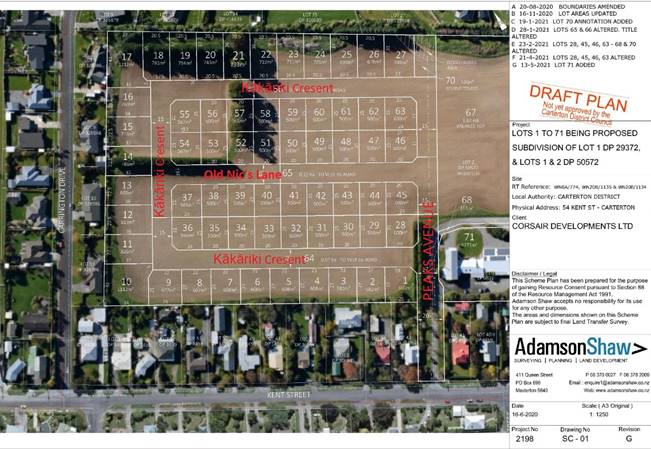
|
Ordinary
Council meeting Agenda
|
7
December 2022
|
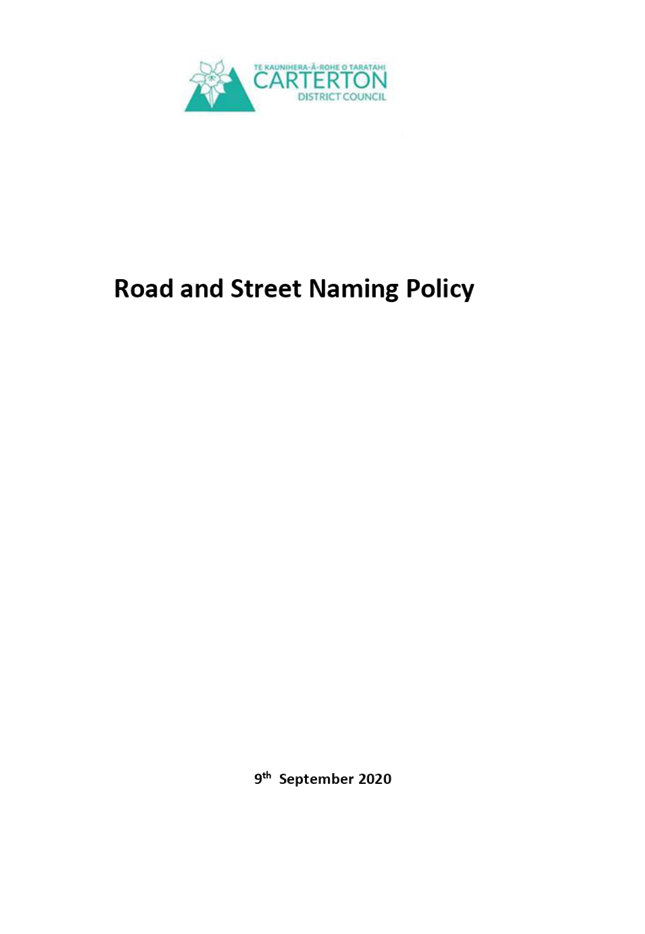

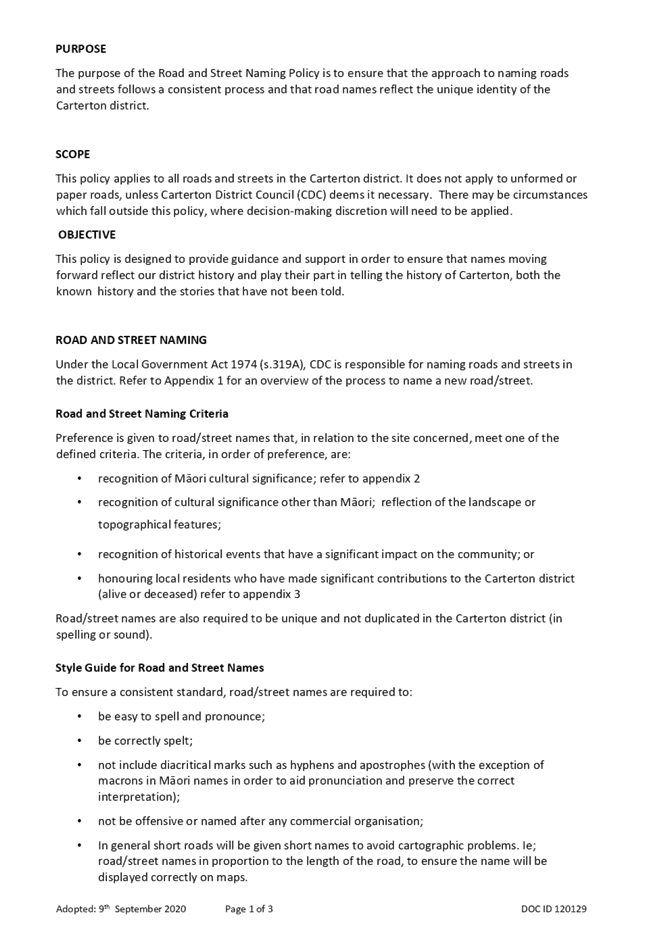
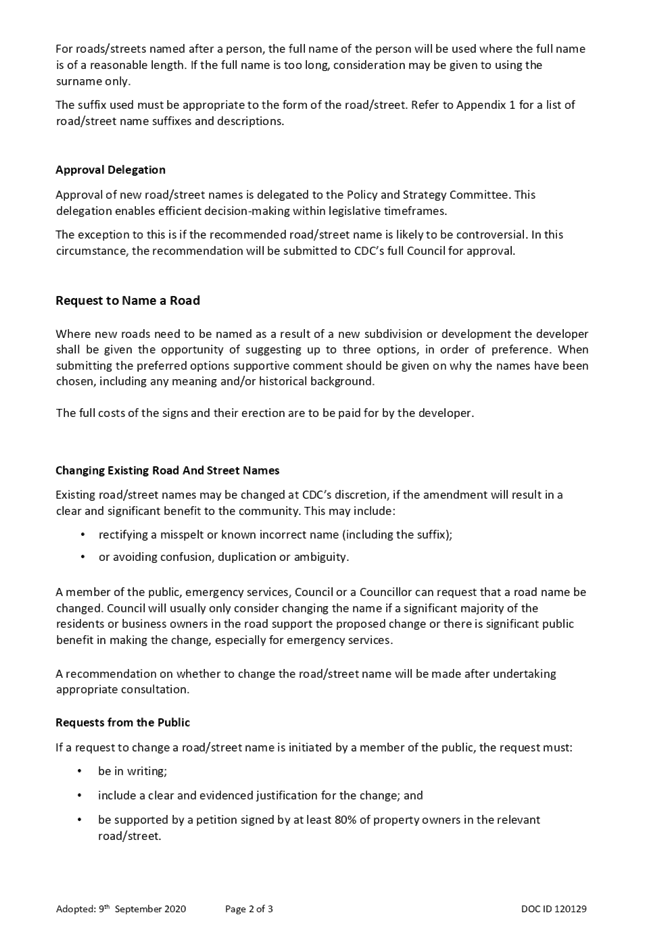
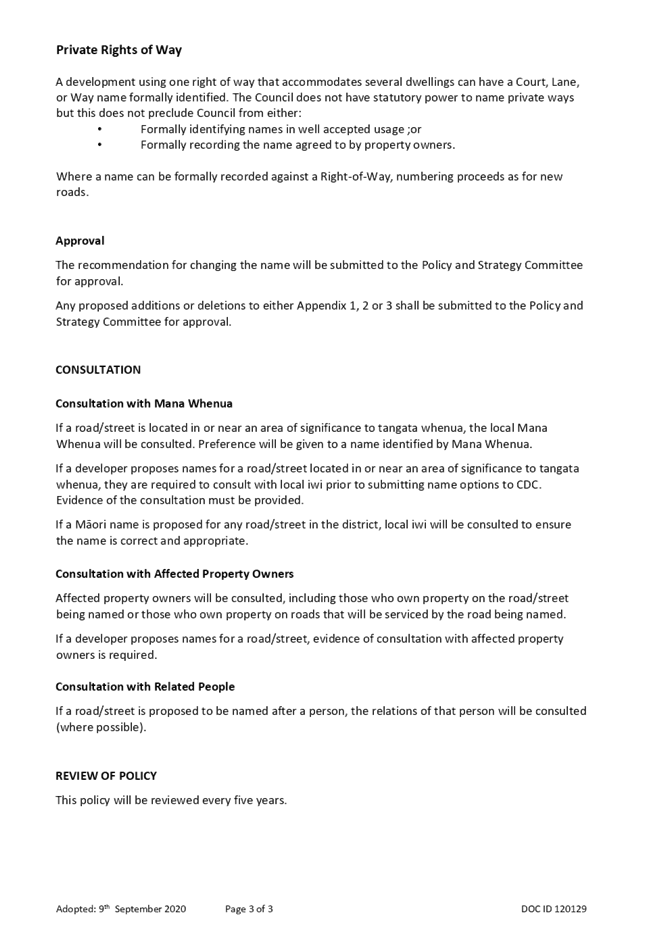

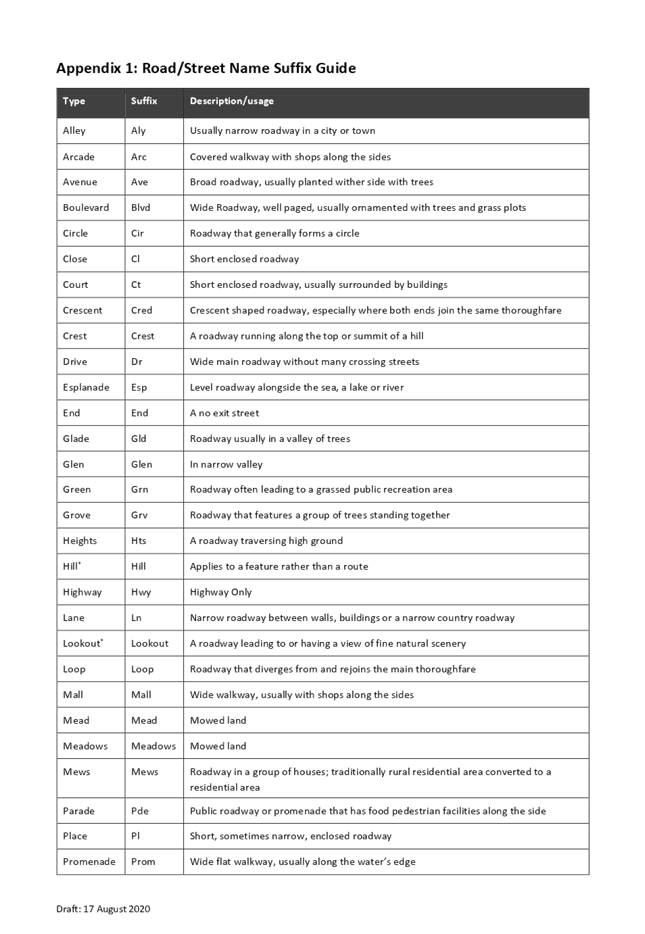
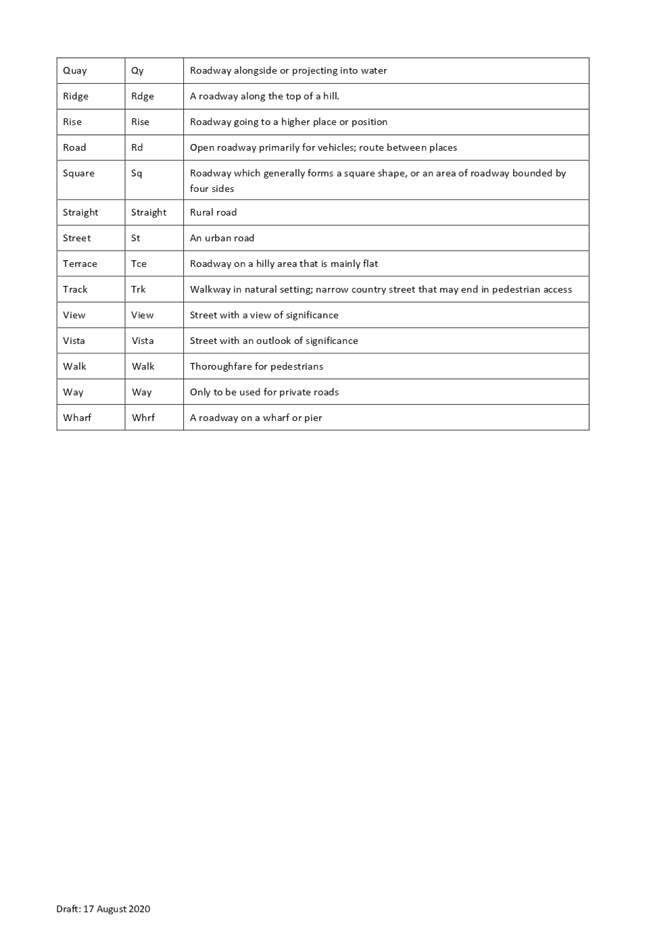

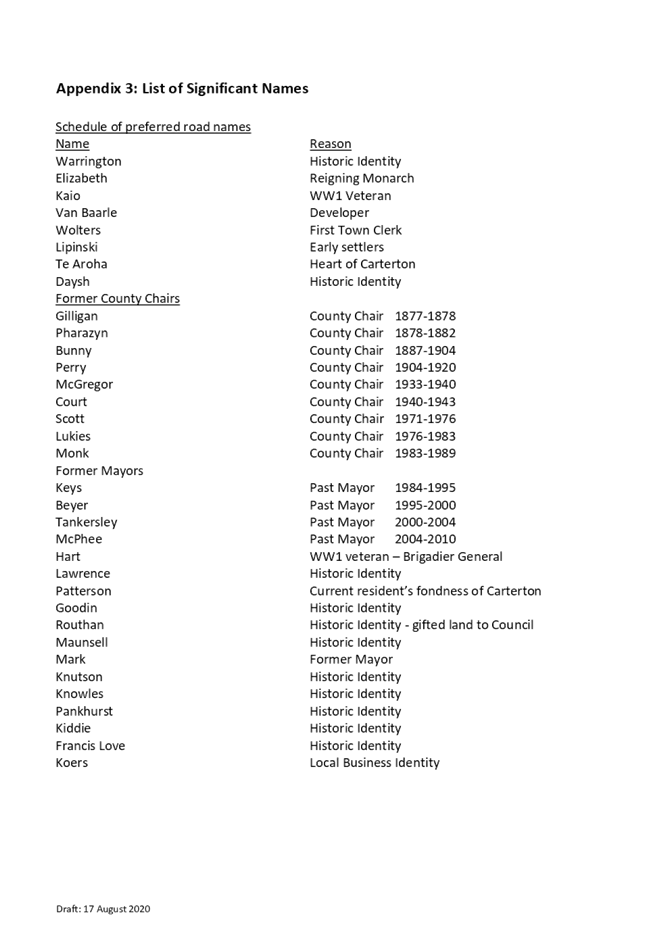
|
Ordinary
Council meeting Agenda
|
7
December 2022
|

7.7 Report
on the administration of Carterton District Council's practices in relation to
the control of dogs for the year 1 July 2021 to 30 June 2022.
1. Purpose
For the council to
receive the report outlining the dog control activities and practices related
to the Carterton District Council Dog Control for the year ending 30 June 2022.
2. Significance
The
matters for decision in this report are not considered to be of significance
under the Significance and Engagement Policy.
3. Background
As a territorial authority, the Carterton District Council
is required to manage and enforce the Dog Control Act 1996 (the Act).
Under Section 10A of the Act Council must, in respect of each financial year,
provide an Annual Report that sets out activities that have been undertaken in
relation to our dog control and practices.
Section
10A(2) sets out the information required to be included in the annual report,
including:
(a) the number of registered dogs in the
territorial authority district:
(b) the number of probationary owners and
disqualified owners in the territorial authority district:
(c) the number of dogs in the territorial
authority district classified as dangerous under section 31 and the relevant
provision under which the classification is made:
(d) the number of dogs in the territorial
authority district classified as menacing under section 33A or section 33C and
the relevant provision under which the classification is made:
(e) the number of infringement notices issued
by the territorial authority:
(f) the number of dog related complaints
received by the territorial authority in the previous year and the nature of
those complaints:
(g) the number of prosecutions taken by the
territorial authority under this Act.
4. Discussion
One
of the key areas of work that Animal Control officers provide relate to the
control of dogs in public places, which are enforceable under Part 4: Carterton
District Council Control of Dogs Bylaw Amendment 2007.
There
are no specific dog exercise areas defined as there are enough open spaces and
parks around the district for appropriate exercise. However, a rural public
park at Sparks Park where dogs can be exercised off the leash, has become
popular with dog owners and poo disposal bags and a dog poo bin have been
placed there.
An
urban public park at Bird Park had been established with the same facilities as
the rural public park. There are dog prohibited areas which are well
signposted. Dogs in specified public places and the CBD must be on a leash at
all times. Carterton District Council provides Doggy Doo Dumpster bins
near dog exercise areas and in urban streets. Council Officers monitor
these areas to ensure compliance.
Fees
and charges are reviewed annually and set by Council resolution.
Council’s funding policy for animal control is that 80% of the total
costs are met by dog registration fees and 20% from rates.
Council
provides dog owners with information regarding education programmes and
obedience courses and offers dog owners a discount on registration fees for
neutered/spayed dogs.
Council
promotes the local Dog Obedience and Kennel Club and a local Dog Obedience
Trainer.
5. 2021-2022
REPORt
Offences
and Penalties
With
regard to offences and penalties, Council’s policy is to approach each
incident on a case-by-case basis and to use infringement notices for minor
offences. Where an attack has occurred, Council’s policy is to
adhere to the provisions of the Dog Control Act 1996 as closely as possible.
At
the end of 2017 Carterton District Council Dog Control initiated a programme of
seizing dogs that had been unregistered for more than 2 years. Letters
were first sent to the dog owners advising them of Council’s intention.
Carterton District Council has continued to take this approach for the
2021/2022 financial year.
Council
has adopted the ‘Assessment Matrix’ for potential prosecution
decisions.
Under
the Carterton District Council Control of Dogs Bylaw Amendment 2007, owners
with more than two dogs within an urban area must obtain a permit through an
application to Council. The Council Dog Control Officer inspects the property
for suitability for housing and controlling dogs, interviews the dog owner, and
considers any previous history. Submissions in writing are sought by affected
neighbours.
The
statistics to be reported on as per the Animal Control Act 1996 are outlined
below.
|
Measure
|
Result
|
Number of registered dogs
|
2834
|
|
Number of probationary owners
|
0
|
|
Number of disqualified owners
|
4
|
|
Number of dogs classified as
dangerous under Section 31
|
2
|
|
§ s.31 1(a) due to
owner conviction
|
0
|
|
§ s.31 1(b) due to
sworn evidence
|
1
|
|
§ s.31 1(c) due to
owner admittance
|
1
|
|
Number of dogs classified as
menacing under Section 33A
|
11
|
|
§ s.33A 1(b)(i)
observed or reported behaviour
|
10
|
|
§ s.33A 1(b)(ii)
characteristics associated with breed
|
1
|
|
Number of dogs classified as
menacing under Section 33C
|
12
|
|
Number of infringement notices
issued for – failing to register a dog.
|
29
|
|
Number of infringement notices
issued for – failure to implant microchip transponder
|
0
|
|
Number of infringement notices
issued for – failure to keep dog under control
|
2
|
|
Number of infringement notices
issued for – failure to keep dog controlled or confined
|
4
|
|
Number of infringement notices
issued for – failure to comply with bylaw
|
0
|
|
Number of infringement notices
issued for – failure to comply with effects of classification
|
3
|
|
Number of Dog Related Complaints
|
230
|
|
Dog Bites On People
|
1
|
|
Dog Bites On Animals/Stock
|
11
|
|
Dog
Rushing
|
16
|
|
Dogs
Barking
|
48
|
|
Dogs Wandering
|
90
|
|
Dog Welfare
|
1
|
|
Dogs Lost
|
29
|
|
Dogs Found
|
34
|
|
Dogs Impounded
|
47
|
|
Dogs Rehomed/Adopted
|
0
|
|
Dogs Surrendered to other
organisation’s for re-homing
|
2
|
|
Dogs Illegally Removed from Pound
|
0
|
|
Dogs Destroyed
|
3
|
|
Dogs Returned To Owner
|
42
|
|
Number of prosecutions
|
0
|
6. NEXT
STEPS
The Act requires that the Council gives public notice of
the report and makes the report publicly available. This will be done
once the Council had adopted the report.
7. CONSIDERATIONS
7.1 Climate change
Producing
this report is a legislative requirement and the Dog Control Act does not
include any climate change provisions.
7.2 Tāngata whenua
Not applicable.
7.3 Financial impact
There
is no financial impact as a result of this report, as Animal Control as a whole
is funded 80% fees and charges with 20% being funded by rates as the public
good portion. This public good component covers matters often in relation
to animal welfare, or the euthanising of dogs where no owners can be
identified, and the dog is not suitable for rehoming, or on the recommendation
of a vet.
7.4 Community Engagement
requirements
Not
applicable for the purpose of this report.
7.5 Risks
No
risks have been identified. It is noted that Council will consult on and adopt
a separate dog control policy that stands alone in 2023. This is to
ensure that the dog policy and dog control bylaw are individualised reports to
guide decision making.
8. Recommendation
That the Council:
1. Receives
the report.
2. Adopts
the report on Council’s administration of Dog Control practices as set
out in section 5 for the period 1 July 2021 to 30 June 2022 under section 10A
Dog Control Act 1996.
File
Number: 318928
Author: Solitaire
Robertson, Planning and Regulatory Services Manager
Attachments: Nil
|
Ordinary
Council meeting Agenda
|
7
December 2022
|

7.8 Chief
Executive Report
1. Purpose
For the Council to be
informed on planned Council operational activities, major projects, and other
matters of importance and interest.
2. Significance
The
matters for decision in this report are not considered to be of significance
under the Significance and Engagement Policy.
3. Community
services
Community
Development
Community
Grants - Rural Travel Fund and RSA Grants
Promotional material has been prepared and
advertising is booked for December in the Crier (as there is no Crier in
January) and in the February Midweek. The CDC website will be
updated with new forms in December when the grants round is opened.
Residents’
information event and Picnic in the Park
Planning is going well for this event which will be
held on 10 March 2023. Expressions of interest forms will be distributed prior
to Christmas to local organisations inviting them to attend. The focus is
on providing information about social services, sports clubs, and general
support for residents both new and existing
Older persons
Work is underway to
extend the membership of the group that has oversight of the work of the
Positive Ageing Strategy. The Implementation Group was originally made up
of representatives from the three Councils but will now also include
representatives from other organisations that work with older people.
The Positive Ageing
Strategy Co-ordinator has been invited to join the steering group for the Nuku
Ora Senior Games. The Wairarapa inaugural Senior Games was planned for
last year but was cancelled due to Covid – 19. The
Games is a non-competitive event that provides older adults with the
opportunity to participate in a wide variety of fun, light-exercise
sports and activities in safe environment, and learn more about the activities
which are regularly available in the community.
The regional
membership application to the World Health Organisation Global Network for
Age-friendly Cities and Communities will be submitted. The Mayor of each
District has signed a support letter that will accompany the application.
A collaboration
between the organisations that support older people with digital support has
been brought together by the Positive Ageing Strategy Co-ordinator. Work
to promote the flyer outlining the range of all the digital support services
available in the Wairarapa is planned for December.
Wairarapa Rangatahi
(Youth) Strategy
The Strategy Project
Team has completed an assessment of our engagement feedback provided by
rangatahi (youth 12–24-years-old). We received over 3000 suggestions
relating to the aspirations and needs of rangatahi to make the Wairarapa a
region where young people thrive. The Project Team developed a framework to
assess the feedback which has resulted in eight priority areas for rangatahi.
These will be tested further with the Wairarapa Rangatahi Focus Group (the
Focus Group) on 7 December.
The three Councils
recruited the Focus Group through our 27 engagement sessions. The Focus Group
(25 rangatahi) has representation from across the three districts, [10
rangatahi in the group are based in the Masterton district]. The Focus Group
also includes rangatahi with a diverse range of backgrounds including LGBTQIA+,
Māori and Pasifika communities.
The Project Team has
also completed a review of the 2016 Strategy and has identified that the
objectives and goals will all need to be updated based on the rangatahi engagement
results. The aim of the revised strategy will be to provide a more
rangatahi-centric voice within the document.
The Project Team will
report back to the Wairarapa Policy Working Group in early 2023 to share in
more detail the feedback results, assessment of the 2016 Strategy, outcomes of
the workshop and next steps.
Walking and Cycling
Lunchtime walks at
Carrington Park are continuing. Promotional preparation is underway for weekly
bike rides starting in January leading up to February Aotearoa Bike month
challenge.
Wairarapa Walking
Festival
Another successful festival was held 11 – 20 November with a total of 40
walks offered to the community. Ten of the walks were held throughout the
Carterton District. This year’s theme was from the mountains to the
sea. The variety of walks offered meant that walks were accessible to
all. The walks were held on different times/days of week, with skill levels
from beginner to advanced, and from being ticketed to free.
Eleven of the walks
sold out which could be attributed to the thorough promotional campaign which
included: NZ Walking and Lifestyle magazine, regional promotion through
Destination Wairarapa, newspaper advertising in Palmerston North and
Wellington, Midweek and WTA. There was also a significant social media campaign
on Facebook and websites.
Unfortunately, three
walks had to be cancelled due to bad weather.
The inaugural walk at
Henley Lake with regional Mayors was well attended and included Masterton Mayor
Gary Caffell, Mayor Ron Mark, Deputy Mayor Dale Williams, MP Keiran McAnulty,
Iwi representatives and Henley Board members.
Zero Waste
This month has
provided the opportunity to develop knowledge and understanding of waste
management and minimisation services to our newly elected members with a presentation
at the joint services meeting at the Carterton Event Centre.
Work is being
undertaken with a supplier who has developed a proposal that we are currently
reviewing. The goal is to support the rollout of event waste management
requirements in line with the solid waste management bylaw.
We are in the final
stages of negotiating a contract to deliver the Zero Waste in School’s
programme. This contract will be held by the Environmental Education for
Resources Sustainability Trust who designed the programme. This is a beneficial
progression of the delivery of this programme and brings a consistent approach
to how the programme is delivered across Aotearoa.
After speaking at the
Wai Waste AGM, formative discussion is underway regarding diversifying their
operations. They are exploring composting, collection, and potentially
construction and demolition waste. This has the potential to provide
income opportunities, meaning less reliance on funding.
Time has been spent at
the transfer station and discussions with the General Manager of Operations of
Smart Environmental. The purpose of these meetings was to discuss building
collaborative opportunities between the territorial authorities (TA’s),
Smart Environmental and the community. Discussions have been encouraging with
some positive steps forward. Discussion points have included:
· Co-Sponsorship of
Bins/Hoods and collection from Smart Environmental and council of
not-for-profit community events as part of their PR strategy (it will provide a
significant reduction in the cost for waste management at these events).
· Providing a soft
plastic collection point at the Carterton transfer station.
· Small battery
recycling 12-month trials at all transfer stations funded through the waste
levy. Collection buckets will be onsite mid-December.
· Presentation from
Smart Environmental about organic collection and the container return scheme.
Valuable information around the procurement process was obtained and strategic
direction during the transition phase. If local TA’s can secure licensing
of the container return scheme it could mean the recycling collection service
could become rates neutral.
The Wairarapa Waste
Minimisation Plan development is gearing up with key dates and timelines
provided from Beca, with a busy meeting schedule of co-design workshops from
December through to March including behaviour change education focus areas. The
draft waste assessment report has now been provided with some significant gaps
in data from CDC.
Climate
change
Electric
Vehicle chargers
Meridian has advised
that EV chargers should be operational by Christmas. The chargers will be using
the Zero EV charging app and drivers will be required to use the app to start a
charging session. With the app drivers will be able to:
· Find chargers near
them
· Save frequent
chargers for easy navigation
· Start and monitor
their charge
· Pay for their
charging session
· Track their
charging stats and history.
Our chargers will be
part of the largest destination charging network in Aotearoa with over 500
chargers.
Wairarapa
Library Service
The Wairarapa Library Service operates as a shared service
across four sites in Carterton and South Wairarapa District Councils.
A thank you morning tea was held for Featherston Knitters
and the OWLS of Featherston and was attended by approximately 50 people. They
were thanked for supplying board books and knitting to put into the library
baby packs which are distributed by Plunket to all new-borns in the South
Wairarapa and Carterton districts each year. This year 160 baby packs have been
given out so far.
Continuing on the theme of ‘Libraries for
life’, November has seen 35 school class visits - a direct result of
engagement with all schools and promotion of the teacher/educator borrower
card. A new monthly pilot called Reading Aloud started in Greytown in
conjunction with the Greytown Little Theatre. The monthly event features
performers reading extracts from their chosen books.
The Wairarapa Walking Festival saw the opening of a
Storywalk in Considine Park, Martinborough. The walk was a collaboration between
Wairarapa Library Service (WLS), Friends of Martinborough Library and the
Martinborough Menzshed. The initiative celebrates local authors, and plans are
already underway for the next development.
In terms of technology, the WLS app continues to be
showcased as library staff work towards encouraging people to self-issue items,
thus freeing up staff time from simple transactions. The two libraries
went live with the ability for the public to print wirelessly from their own
devices.
Covid and the current round influenza and other illnesses
has been continuing to make everyday operations challenging. The additional
pressure of library staff time being used to take rates payments (a SWDC
function only which has just finished) further reduced service capacity over
this period.
Coming up in December / January
With school holidays approaching, libraries are preparing
ways to keep young people engaged with reading. Stringbean Puppets are booked
for workshops in all sites and Australian author and performer Deano Yipadee is
booked or two events in January.
Events
Centre
Events Centre Activities
Since the last report
the Event Centre has remained busy with more dance recitals, The Tina Turner
Tribute, The Sports Education Trust Hall of Fame dinner, the Fern & Thistle
Pipe Band, a number of Wai Word events and local school productions, along with
a range of private events and weddings. The Team also helped with ticketing for
the Wairarapa Walking Festival.
After a slow winter
season, ticket sales have really picked up in the last month, with several
shows in late November and early December likely to sell out. Still coming up
we have comedian Guy Williams (a show likely to sell out after only four weeks
on sale), Limelight Theatre, Dancing Queen: A Tribute to ABBA, A Celtic
Christmas, and Monkey Wrench – a Foo Fighters Tribute.
We are well into
programming for 2023, and already there are only a few Saturdays still free in
the entire year. We are delighted to see the return of large companies like
the New Zealand Symphony Orchestra and the Royal New Zealand Ballet next year,
as well as welcoming new companies to our venue like Te Moana Arts and Footnote
Dance. The impact of Covid is certainly affecting the theatre and arts
community, with Capital E National Theatre for Children recently cancelling
their planned North Island tour in 2023 and other companies pulling back to
major centres only. However, we have some exciting plans in the mix, and
2023 promises to be a year of varied and diverse events for all.
In staff news, Joe
Samuel has resigned after four years in the events centre team. Joe has
been an asset to our team, and we wish him well for his new adventures in
Christchurch. We have also hired a new Marketing Coordinator, Ashleigh
Macleod, who will be starting with us in January. While we are short-staffed,
Katrina King will be giving us some additional capacity to assist in running
the info centre. We were also very pleased to welcome back Simon Rayner
in the last month after his period of leave.
Sales and Marketing
Facebook &
Instagram – Reporting period 15 October – 22 November 2022
· Reach: The number
of people who saw any content from our Carterton Events Centre Pages is up 115%
on Facebook and up 114.3% on Instagram since our last report. These are
big increases on our results for the period prior which is very pleasing.
· Page and profile
visits: The number of times our page was visited (i.e. searched) has decreased
-43.5% on Facebook and increased 16.3% on Instagram.
· New likes and follows:
We’ve increased our page followers on Facebook by 18 (down -70% on the
last period) and 31 on Instagram (up 34.8% on the last period).
These statistics are
reflective of the fact that in the last month we’ve been putting more
focus into Instagram in order to increase our audience. It’s very
encouraging to see engagement lifting along with our follower count.
Mailchimp
Our Email newsletter is
always a great way to connect directly with our audience. In the past 30
days our audience has grown by 26 Subscribers. Across the newsletters sent in
the past month we achieved an average open rate of 43% which is well above the
average according to Mailchimp’s data.
Facilities
and maintenance
· Work on the
auditorium’s air conditioning system has been completed.
· Replacement of
end-of-life fluorescents at the main office has been completed.
· The clock tower
lights have arrived. Programming offsite has begun and installation work will
be underway as soon as programming completed.
· Auditorium winch
system upgrade – the winches are currently in Wellington. We are having
to co-ordinate free days in auditorium along with contractor availability to
allow the install.
A major flooding
incident took place at 29 Holloway Street (premises opposite the CDC offices
that are owned by Council) during recent heavy weather. A temporary repair to
an internal drain has been installed which was followed by a further small
flood, and subsequent repair. The Parks & Reserves team stepped up to
help out the Salvation Army move furniture and storage shelving around to
assist with drying the carpets and building. Both Wai Art and the
Salvation Army are able to operate normally from the site again.
We are working with
our insurance assessors and obtaining advice on the next steps for the
building. This will include building and remedial works assessments along
with quotes for re-roofing and groundworks/external drainage. We
anticipate bringing the assessments and options for the building to Ordinary
Council early in the New Year.
Parks
and Reserves
Reserves
The street bed gardens
have had their seasonal change over with summer annuals. Geranium,
petunias, impatiens, begonia and salvia make up the bulk of the displays.
Memorial Square has been planted with impatiens with the intention of retaining
a colourful display for Anzac Day 2023.
The spring flush has
increased the pressure on our mowing team with the 2 front mounted mowers
operating full time.
The weed spraying
programme is ongoing in order to maintain levels of service. Bio herbicide
spraying and steaming are the main methods currently used. Spring weather
conditions have affected our ability to address all concerns so we are behind
in our spraying programme.
New hanging baskets
have been purchased to replace the older styles, and we are in the process of
refreshing the hanging basket display. The size of the baskets has been
slightly reduced to enable safer handing for all involved. Some irrigation
repairs and maintenance will be undertaken during this operation.
All the CBD municipal
lawns have been sprayed with Versatill selective broadleaf herbicide to
eliminate turf weeds and to help maintain the grass sward.
The Xmas festive
lights are ready to be put up in town – they should be operational by
December.
Work continues at
Ngātawhai Reserve with the fencing expected to be completed in January,
after a wet winter put development operations on hold until the ground became
firmer.
CDC has received
funding from Ministry of Business, Innovation and Employment to develop a
Freedom Camping Bylaw. We will work with external providers and seek
feedback from other Councils to help draft the initial proposal, which will
come to Council (initially Projects and Policy) for review before public
consultation. The Bylaw will need to be adopted by Ordinary Council in
accordance with the Local Government Act.
Nursery
The Manuka growing
trials continue with advanced seedlings being moved into the larger tunnel
house.
The Keep Carterton
Beautiful Group (KCBG) were involved with planting the baskets. The baskets are
held in the nursery for a couple of weeks in order to settle in before being
put up on the shop verandas.
Parks
The power box
distribution board at Carrington Park has been upgraded with an additional
32amp outlet to accommodate future events.
The witches hat fall
zone has been upgraded with the soft pour rubber safety surface. In December
soft pour surfacing will be upgraded at the south end of the park beneath the
octopus.
At Sparks Park we have
planted several fuchsia plants. Work continues on the toilet
installation. Harder ground conditions will enable us to move the structure
from where it currently sits to its new site.
Swimming Pool
The pool fence has
been painted by KCGB, power has been installed to the kiosk, pool operations
have been completed with the pool opening on Saturday 26 November.
Molly’s Slide
has been installed and the opening took place on Friday 25 November. The
background to the slide is that in 2021 Molly O’Dwyer wrote a letter to
Councillors considering the Long-Term Plan, requesting that the slide be
upgraded. Molly collected signatures to support her idea and presented her
ideas to Council. Molly was successful through this process and received
the seed funding towards the project. She then led a team to run
fundraisers, apply for funding and brought the community along with her on the
journey. Molly’s confidence and initiative has seen the successful
installation of her vision. Molly’s slide has been made possible
thanks to generous grants from Ka Pai Carterton, CDC, Trust House and many
community donations.

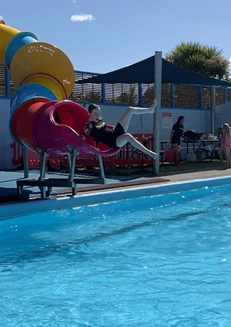
Cemetery
A new berm is being
constructed on the Pet section to increase future capacity.
A new burial berm is
being constructed in the new lawn area to accommodate future burials.
4. Regulatory
and Planning
Resource Management Reform
On 10 February 2021 the Government confirmed its intent to
repeal and replace the RMA, and set out a work programme for the initial stages
of the review. The Reform package broadly accepts the recommendations of the
Resource Management Review Panel in its June 2020 report on “new
directions for resource management in New Zealand”.
It is likely that transition provisions will be developed
to ensure that the planning standards, other national direction and the RMA as
a whole remain in effect until their replacements are developed. This is likely
to take several additional years (beyond 2022).
The government has advised that in the interim, Councils
should continue with business as usual, and any plan review work should place a
particular emphasis on reviewing the performance of their plans and
establishing implementation practices that could be carried over into a future
system.
The Government plans to repeal the Resource Management Act
and enact three new pieces of legislation this parliamentary term. The new laws
are the:
· Spatial Planning Act (SPA) which requires the
development of long-term regional spatial strategies to help coordinate and
integrate decisions made under relevant legislation
· Natural and Built Environment Act (NBA), the
main replacement for the RMA, to protect and restore the environment while
better enabling development
· Climate Adaptation Act (CAA) to address complex
issues associated with managed retreat, and funding and financing climate
adaptation.
The Natural and Built Environment Bill (NBE Bill) and
Spatial Planning Bill (SP Bill) were introduced to Parliament in November
2022.
The Climate Change Adaptation Bill is likely to follow in
2023.
National and Built Environments Act (NBA)
The NBA will be the primary piece of legislation to replace
the Resource Management Act (RMA). Like the RMA, the NBA will be an integrated
statute for land use and environmental protection. The National and Built
Environments (NBE) Bill also set out how the environment is to be protected and
enhanced. It will specify positive outcomes to be promoted for the natural and
built environments. This is a shift from the RMA which focuses on managing
adverse effects rather than achieving positive outcomes. These limits, targets
and outcomes will be provided by the National Planning Framework, a key
component of the NBE Bill, that consolidates what is known as ’national
direction’ in the existing resource management system (i.e. existing
National Policy Statements, National Environmental Standards, etc.)
The new NBE Bill requires anyone exercising powers,
functions or duties under the Act to give effect to the principles of Te Tiriti
o Waitangi and recognise Te Ao Māori. Under the current legislation,
decision-makers are only required to 'take into account' those principles.
Te Oranga o Te Taiao is an integral concept in the new NBE Bill. It is an
intergenerational ethic that emphasises the importance of the health and
wellbeing of te taiao (the environment) for current and future generations.
The new NBE Bill consolidates planning documents into a
single Natural and Built Environment Plan (NBE Plan) for each region. NBE plans
will have similar functions to those performed by regional policy statements,
and district and regional plans under the current system, in regulating land use
and natural resource use in each region through rules and policies.
Spatial Planning Act
The Spatial Planning Act (SPA) will provide a more
strategic and coordinated approach to long-term regional planning. It will
require spatial planning at the regional level through the development of
regional spatial strategies (RSSs).
Regional spatial strategies will see central government,
local government and Māori working together, in consultation with the
community, to identify how their region will grow, adapt and change over the
next thirty-plus years. They will focus on significant issues and opportunities
facing the region.
Regional spatial strategies will set out a vision and
objectives to guide a region’s development accompanied by a set of
priority actions to turn the vision into a reality. They will identify areas
that:
· are suitable for development
· may require protection, improvement and
restoration
· require infrastructure
· are particularly vulnerable to the effects of
climate change and natural hazards.
The NBE Bill requires Regional Planning Committees to be
established in each region, comprising members from local government,
Māori, and central government (though central government members only
participate in relation to RSS).
Regional Planning Committees will be established as
committees of all councils in the region. They will be stewards of RSS and NBE
plans under the new system. A Regional Planning Committee will prepare RSS and
NBE plans covering every local authority in the region, with local authorities
retaining responsibility for implementing and administering NBE plans.
Under the current resource management system, district
plans are required to be reviewed every 10 years. With the current timeline,
the new Wairarapa Combined District Plan would serve most of its statutory term
before being replaced with an NBE plan. In addition, the updated data,
analysis, and new provisions prepared for the Wairarapa Combined District Plan
will help inform the new NBE plan.

Building services
The building department had IANZ (International
Accreditation New Zealand) on site from 31 October to 3 November to determine
compliance with the requirements of the Building (Accreditation of Building
Consent Authorities) Regulations 2006.
The assessment identified that the Building Consent
Authority (BCA) had well established systems that were working well for the
BCA. Files were easily locatable during the assessment which pointed to a
well-structured system. BCA management exhibited a strong commitment towards
implementing their systems and procedures to the best of their ability. The
assessment identified 5 General Non-Compliances (GNC’s), 2 of which were
resolved onsite prior to IANZ leaving. As a result of this assessment our next
assessment will not be until 2024.
The
BCA’s risk, both to the Territorial Authority, as a BCA and also as an
organisation accredited by IANZ was assessed. The BCA was considered to pose a Low
Risk. The Risk Decision table is displayed below for reference.
|
High risk
|
A non-functioning BCA - depending on extent and type of risk and agreed
management method.
E.g. there is a pattern of failure to follow a
policy, procedure or system (PPS) by a single or multiple employees, and/or
that the PPS had not been consistently and effectively implemented.
|
Some form of monitoring within 6 months
|
|
Medium risk
|
The BCA is not currently compliant and is unlikely
to demonstrate substantial compliance at the next assessment, or there was a
failure to implement PPS over two or more assessment cycles.
|
1 year
|
|
Low risk
|
“Normal” risk (the BCA is likely to remain substantially compliant
over the next two years).
|
2 years
|
|
Extra Low risk
|
The BCA is almost fully compliant and likely to
remain that way.
|
Reduced monitoring at next 2 yearly
assessment
|
The main reasons for considering this risk category were:
· Good
systems were in place with implementation at an acceptable level.
· Low
number of GNCs raised.
· Sn
experienced and committed management team.
The team is to be congratulated on this result as it
demonstrates to management, elected members and our ratepayers that the
department is functioning well and that our decision-making and processes are
well documented and compliant with the legislative requirements.
Wairarapa Combined District Plan Review
The
draft District Plan was released for public feedback on the 25 October 2022 and
is open until 6 December 2022. Council officers provided the public with
the opportunity to provide feedback at community drop-in sessions in all five
towns, and both days of the Wairarapa A & P Show. There has been a
presentation on the draft plan to a combined planners forum and the first
Combined Council forum for the new triennium.
The
District Plan sets out rules for land use and subdivision in Wairarapa. It must
provide for growth balanced against our desired environmental outcomes. The
draft District Plan has been prepared to give the community an additional
opportunity to provide feedback before the proposed plan is released for formal
consultation in 2023.
The
topics included in the plan are listed below
· Rural
Subdivision
With the anticipated population growth, it is important to protect
land for primary production.
Two zones are proposed to ensure that primary production activities
remain prioritised, while allowing for rural living on smaller lots in
appropriate locations.
Land used for primary production is protected as a priority.
Minimum lot sizes have been increased where primary production
occurs to reflect subdivision that would be anticipated.
Lot sizes for rural living have been decreased to reflect the
low-density residential living that is demanded of lifestyle blocks.
· Urban
Growth and Housing
Providing for urban growth areas.
Enabling higher residential densities in central urban areas.
Revising development standards to achieve a balance between growth
and residential amenity.
Requiring rainwater collection tanks (5,000L min) for any new
dwelling in the residential zones.
· Heritage
sites for protection
Key differences between the Operative Plan and the Draft District
Plan include:
o Demolition
of any heritage building or item is a discretionary activity (requires resource
consent).
o Different
rules apply to scheduled buildings and items versus scheduled precincts to make
the rules easier to follow.
o Some
items are proposed to be removed from the existing heritage schedule.
· Natural
Hazards
Changes to the data and modelling available for various types of
natural hazards has been assessed, and new provisions have been proposed where
appropriate.
New and updated fault lines/traces along with previously mapped
faults have been identified.
Rules have been developed to apply to newly identified potentially
liquefaction-prone land.
Flood hazard mapping is being developed by GWRC and will be
incorporated into the Proposed Plan.
New rules are proposed for areas subject to flooding which restrict
the use of land within these areas.
Restrictions on the use and subdivision of land within 50m of the
coastline continue to apply.
· Tāngata
Whenua
The draft District Plan aims to enable land use and development of
Māori land to support the economic, social and cultural wellbeing of
Māori. The Draft District Plan recognises Te Ao Māori by:
o Enabling
tangata whenua to exercise kaitiakitanga to carry out customary activities
o Providing
for papakāinga and marae
o Protecting
important cultural and historic heritage sites identified by tangata whenua.
· Climate
Change and Resilience
The draft District Plan will enable Wairarapa to adapt to better
protect itself against climate change effects. Changes include:
o Updated
flood hazard mapping being prepared by GWRC will incorporate expected climate
change effects
o New
rules protecting the foreshore and coastline from sea level rise
o Requiring
rainwater collection tanks for any new dwelling in the residential zones
o Allowing
for more renewable electricity generation.
· Energy
The Draft District Plan provides more clarity for the management of
energy as well as technology- specific provisions for renewable energy
generation including wind and solar generation. It allows for development of
small and community scale generation where effects can be appropriately
managed.
· Town
Centres/Neighbourhood Shop/Commercial Areas
The Existing Commercial Zone will be replaced by Neighbourhood
Centre, Mixed Use and Town Centre Zones.
The new Town Centre Zones will function as the commercial and
community hubs for their surrounding residential and rural communities.
The new Neighbourhood Centre Zone provides for small-scale
convenience-based business and retail activities that serve day to day needs of
the local neighbourhood.
The Mixed Use Zone provides for a mixture of commercial, light
industrial, residential, recreational and community activities.
· Industrial
Areas
The General Industrial Zone provides for a range of industrial
activities. Industrial activities contained within this zone are an important
resource for Wairarapa’s social and economic wellbeing.
· Open
Spaces/Reserves
The Draft District Plan introduces three new Open Space and
Recreation Zones to distinguish between parks and reserves and the range of
recreational activities they offer.
The Natural Open Space Zone applies to areas with environmental
values and low level development e.g. forest parks.
The Open Space Zone applies to areas used for recreational
activities including parks, playgrounds, community facilities.
The Sport and Active Recreation Zone provides for a range of sport
and recreation activities e.g. sportsgrounds.
· Papa
kāinga and Māori purpose Zone
Papa kāinga refers to development of community-oriented housing
where Māori can actively maintain and enhance their culture and
traditions, supporting their economic, social, and cultural wellbeing. A new
Māori Purpose Zone will enable iwi and hapū to live on, use, and
develop ancestral land. Papa kāinga will be enabled across residential and
rural zones.
· Quarries
Aggregate remains in high demand nationally. Due to its low value
and high bulk transport costs, the preference is to source locally where
possible. The Draft District Plan continues to allow for farm quarries as
permitted activities in rural areas. All other quarrying activities will
require resource consent ensuring appropriate measures are in place to manage
any noise, traffic, dusts and visual impacts.
· Natural Environment (Indigenous Biodiversity, Natural Features and
Landscapes, Natural Character and Public Access.
The Draft District Plan seeks to recognise and protect Natural
Environment Values of significance in Wairarapa, provided through the
Indigenous Biodiversity; Natural Features and Landscapes; Natural Character;
and Public Access Chapters. The Draft District Plan uses overlays to provide
protection in certain areas where particular values restrict some activities.
The overlays are:
Significant Natural Areas: areas of very
low-level of development to protect significant indigenous biodiversity values.
Outstanding Natural Features and Landscapes: areas of low-level development to protect the natural landscapes
and natural features of significance to Wairarapa.
Significant Waterbodies: developments
within the margins of significant waterbodies are carefully managed to ensure
significant values of the identified waterbodies are not degraded.
· Coastal
Areas
A new specific Coastal Environment Chapter contains rules to protect
the special values and characteristics of Wairarapa’s coastal areas and coastline.
The following overlays manage these particular values and characteristics:
Coastal Environment: the full extent of land containing coastal
values and characteristics.
Very High and High Natural Character: areas requiring low-level
development to enable the protection of natural character.
Outstanding Natural Character: areas requiring low-level development
to protect the natural character.
Foreshore Protection Area: areas vulnerable to coastal erosion and
development to be avoided.
· Hazardous
Substances and Contaminated Land
The Hazardous Substances Chapter contains provisions to manage
storage and use of hazardous substances.
The Contaminated Land Chapter contains objectives and policies to
guide decisions involving contaminated soil. Rules are covered by the National
Environmental Standards.
· Network
Utilities/Infrastructure
The Draft District Plan includes:
o Policies
and rules to require undergrounding of new network utilities in all areas where
practical and reasonable.
o Policies
and rules to encourage undergrounding of existing network utilities in urban
areas.
o New
provisions seeking the protection of the National Grid from development.
o Giving
effect to national direction instruments, clarifying the relationship between
the District Plan and other infrastructure regulations.
· Transport
Wairarapa’s transport infrastructure is made up of roads,
state highways, pedestrian and cycle networks, the rail network, and Hood
Aerodrome. The Draft District Plan includes a Transport Chapter containing
rules to manage effects of transport on the environment of land use and
development on the transport network. The Draft District Plan supports a
multi-modal transport system including pedestrians, cyclists, public transport,
freight vehicles and private passenger vehicles. Updated standards align with
best practice.
· Noise
The Draft District Plan Noise Chapter includes:
o Noise
limits for construction activities
o Rules
to manage noise effects on dwellings while protecting the operation of State
Highways, Hood Aerodrome and satellite commercial helicopter bases.
o Noise
insulation requirements for residential living in commercial and industrial
areas.
o Noise
limits for temporary events.
· Light
The Draft District Plan Light Chapter includes:
o Application
of the Dark Sky Plan Change rules to Masterton (existing rules apply to
Carterton and South Wairarapa).
o Requirements
for artificial lighting to be of a warm colour including light shield. Changes
allow for lights to be installed in public places, reducing unnecessary light
pollution.
· Signs
Signs are important for promoting businesses, community facilities,
other activities and for wayfinding and safety. Location and design of signs
need to be managed. The draft District looks to strengthen some rules around
certain signage.
5. Infrastructure
services
Water Operations
Aerator Trial
We are now trialling a new aerator on pond 1. The aerator
is working well and should have a positive effect to odours
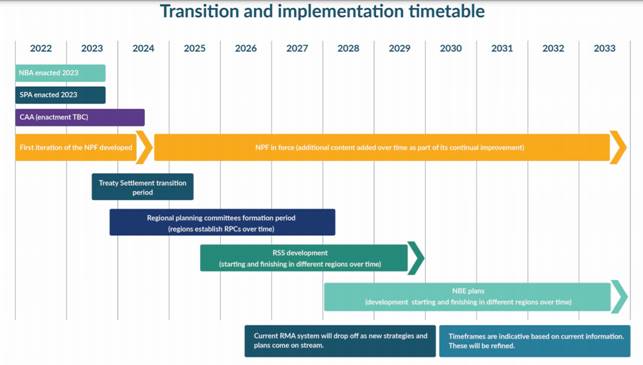
WWTP Odours
The ponds rely on a fine balance of biochemistry to stop
bad odours from travelling most of the time in the waste stabilisation ponds.
There are two distinct layers within ponds, anaerobic (no oxygen) on the bottom
layer and aerobic on the top layer. The lower layer is made of solids
accumulated over time in the bottom of each pond where they are slowly consumed
by microbes. These microbes produce bad odours which are consumed as they pass
through the aerobic layer.
However, if that balance is removed by weather changes or
chemicals or high loads in the network, it will impact the ponds upsetting the
aerobic layer and allowing the bad odours to get to the surface.
Pond 1 is the most likely to be affected because it
receives the overflows when the inlet works get overwhelmed and the lower
anaerobic layer is the greatest.
The team is currently investigating treatment options of
sludge (bottom layer) in the ponds.
Roading
Emergency works
The
roading team is making good progress with repairs of the weather damage earlier
this year. We have completed the 1st dropout and are now on the 2nd
already using roughly 280 ton of lime rock boulders to date. We are also in the
process of replacing 9 culverts on Arawhata Hill (Te Wharau Road). While
replacing the culverts we are increasing capacity and improving the alignment
to ensure better stormwater management.
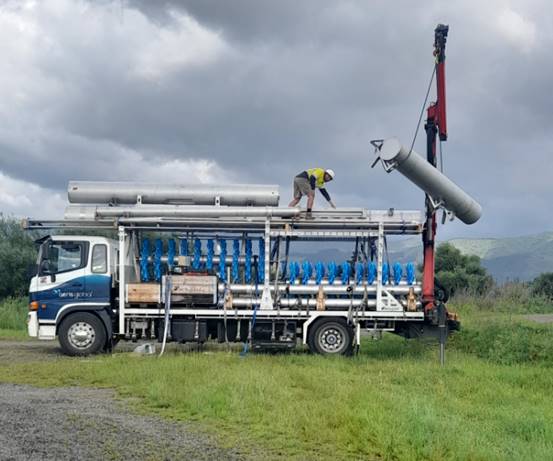
Image – Dropout repair using Lime Rock boulders,
geotextiles, sub-soil drainage and traditional benching.
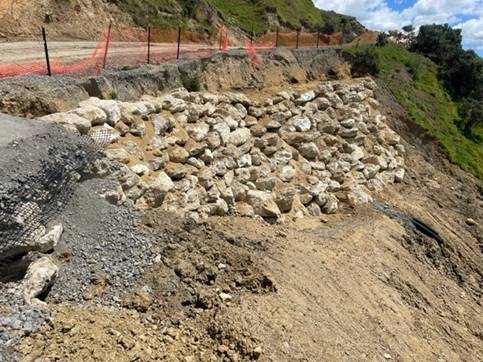
Image – new culverts with improved alignment
Improving
Resilience
The team has
been working with GWRC to develop a planting plan for Te Wharau Road in order
to improve resilience to the network. We are planning to plant at least 850
Poplar tree poles in Autumn 2023.
The
establishment of these trees brings significant benefits in terms of slope
stability and ground water uptake. Improving resilience will have a significant
positive impact on future maintenance cost and environmental impacts.
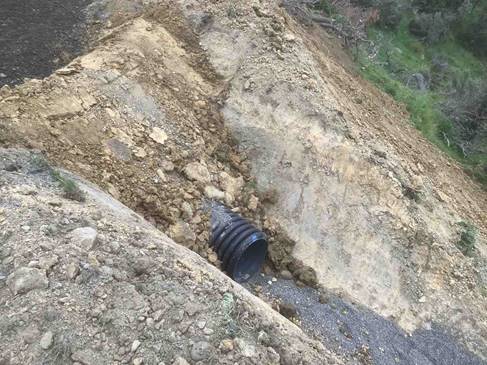
Image – Te Wharau Road planting plan
This resilience work aligns with a recent Wairarapa Road
Vulnerability study completed by WSP on behalf of Wairarapa Engineering
Lifelines Association (WELA). The study identified Te Wharau Road as one of
CDC’s most vulnerable roads.
Waka Kotahi Interim State Highway Speed Management Plan
2023 - 2024 - Consultation
Waka Kotahi’s Interim Speed Management Plan (ISMP) is
currently out for consultation and closes on the 12 December 2022.
We intend to make a submission on the proposed ISMP. From our review of the
proposed ISMP we have identified one aspect that directly affects CDC.
The Waka Kotahi proposed plan has failed to identify South
End School as a high-risk area, which we would expect to have a variable speed
limit. We will bring this omission to the attention of Waka Kotahi through the
submission process.
Roading Data Quality improvements
Even though continuous improvement of data quality is
business as usual, the team made a great effort during the last 12 months and
reaped the rewards. Our score has improved from 77 last year to 94 this year.
CDC is currently 2nd highest score in the Wellington region with
Wellington City Council (with their dedicated RAMM team) taking home the top
honours.

Summer students
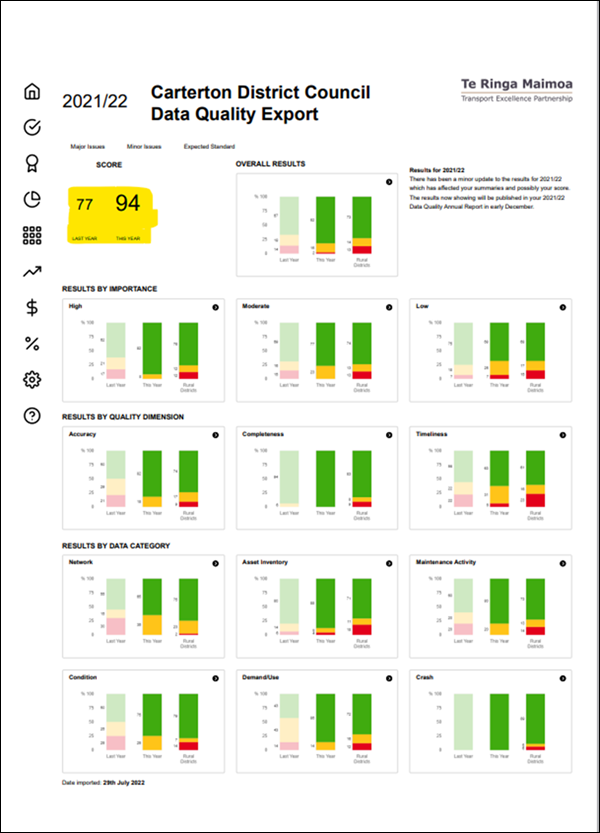
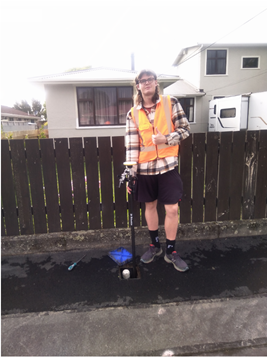
Henry Nelson and Michael Chapman have recently started with
Carterton District Council as summer students in the infrastructure team.
They have been working on a variety of physical and analytical tasks ranging
from vacuuming the swimming pools, help fixing water tobies, asset and data
management and analysing is our ageing wastewater network.
Through the summer, we expect them to understand what it is
like to work for CDC and also gain some corporate skills such as coming into
work on time, doing timesheets, health and safety risk assessments before going
in the field which they can then carry forward into their future professional
lives.
One of the major pieces of work of they are helping with,
is reviewing our wastewater CCTV information and condition assessment reports
to create a visual representation of areas with poorly graded wastewater pipes.
This work will inform the infrastructure team to when developing the forward
works program.
Below is a snapshot of areas where CCTV videos have shown
active infiltration. Their work through this summer will highlight more areas
as they review data. During this process the students learnt how to rate
a pipe’s condition in accordance with Water NZ’s pipe inspection
manual. There was some maths involved in rating these pipes which bust
their myth about not needing maths outside school.
Note that the red lines indicate normal Wastewater
infrastructure, with yellow indicating a poor condition.
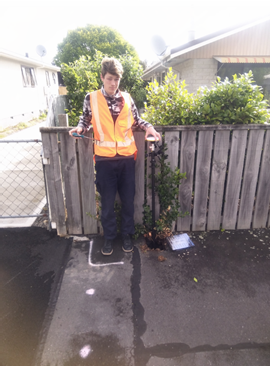
Image – Summer student condition assessment
Wellington Region Waste Management and Minimisation plan
2023-2029
We are currently working with the Wellington regional
councils to review the current Wellington Region Waste Management and
Minimisation Plan. Porirua City Council is taking the lead with the assistance
of Becca as professional service.
Attached is the Porirua City Council Officer’s report
for their Council meeting on 15 December 2022 where they are seeking a
recommendation to development of a new Wellington Region Waste Management and
Minimisation Plan (2023-2029) – Attachment 1.
6. Corporate
Services
Finance
The finance team is beginning work on the 2023/24 Annual
Plan with budget holders. This includes reviewing the year 3 projects and
operational costs in the 10-Year Plan, as well as fees and charges. Several
workshops are planned with elected members over the next few months to work
through the annual plan process, with the first workshops already held.
The final audit of the 2021/22 draft Annual Report is
currently underway. The draft, unaudited annual report was presented to, and
endorsed by, the Audit and Risk Committee at the extraordinary meeting on 29
September.
As previously discussed with Council, as required under the
Local Government Act 2022 the annual report would usually be adopted by the end
of October. However, this year (as with last year) the government has extended
the statutory deadline to the end of December due to a national shortage in
auditors. Once Audit NZ has completed the audit, the annual report will be
adopted by Council. Timing of the adoption is uncertain at this stage, though a
placeholder for an additional council meeting on 21 December has been pencilled
in as a possible adoption date if we have audit clearance by then.
Communications and
engagement
Campaigns
· ‘Water ya
doing?!’- our water restrictions campaign and kicking off a competition
with water conservation related prizes.
· Promoting the
Draft Wairarapa Combined District Plan engagement, the Wairarapa Walking
Festival, launch of Molly’s slide, and promoting the Christmas Parade.
· Publication of the
Residents Guide 2022-25 (released Wednesday 30 November).
Media
requests (excluding LGOIMAs)
|
Date received
|
Media outlet
|
Topic
|
Date Responded
|
|
24/10/2022
|
LDR
|
Code of conduct
|
24/10/2022
|
|
2/11/2022
|
WTA
|
Alcohol reforms, number of on & off
licences
|
2/11/2022
|
|
2/11/2022
|
LDR/WTA
|
Lowering of the voting age
|
2/11/2022
|
|
4/11/2022
|
WTA
|
Guy Fawkes
|
4/11/2022
|
|
4/11/2022
|
WTA
|
Rutland Road speed change
|
4/11/2022
|
|
8/11/2022
|
WTA
|
Leaking pipes/water restrictions
|
9/11/2022
|
|
11/11/2022
|
LDR/WTA
|
Walking Festival
|
11/11/2022
|
|
16/11/2022
|
WTA
|
RMA reform
|
16/11/2022
|
|
23/11/2022
|
WTA
|
Christmas parade
|
23/11/2022
|
|
23/11/2022
|
WTA
|
LGOIMA bill questions
|
24/11/2022
|
|
23/11/2022
|
WTA
|
Wastewater ponds
|
23/11/2022
|
|
24/11/2022
|
WTA
|
Molly's slide
|
24/11/2022
|
7. People
and Wellbeing
Our People
The main focus for the
reporting period, has been responding to the combined impacts of adverse
weather across the district, COVID-19 and seasonal illnesses, and staff
vacancies.
Extreme winter weather
conditions have continued into spring, keeping our operational and customer service
teams under pressure. Service demands have not only been to address road
and water network impacts but also to our own infrastructure, particularly
severe inundation at the Waste Water Treatment Plant and Dog Pound facilities.
We have experienced another
COVID-19 wave during October and November, fortunately however, the occurrences
have usually only been 2-3 cases at any one time, meaning teams have continued
to function well. We continue with our safety protocols and risk
mitigations to manage COVID-19 impacts including staff regularly RAT testing,
working from home if symptomatic or close contacts, maintaining distancing
where possible, and ensuring good hygiene habits.
A number of teams have
been busy covering staff vacancies. 4 roles have recently been filled
with 2 currently being advertised.
Health & Safety
(H&S)
For this period,
incidents were reported as follows:
· 0 near miss
reports
· 4 incidents
causing damage
· 1 incident
resulting in minor injury
The
lack of ‘near miss’ reporting, combined with reports of damage, is
of concern. The H&S Committee, Leaders Roopu, and Executive
Management Team are aware of the issue, and are communicating the importance to
staff, and encouraging reporting.
Staff
Wellbeing
Staff wellbeing
remains one of our ‘Top 5 Risks’ with ongoing pressures and
uncertainty driven by a number of factors including COVID-19 impacts, staff
vacancies, adverse weather, and local government reforms.
Our managers and team
leaders are acutely aware of these pressures on their teams, and are actively
checking in with staff, encouraging periods of leave, and rearranging
priorities where possible. We also have 5 fixed term staff supporting our
Operations Teams over this busy time.
8. MAJOR
PROJECT UPDATES
Frederick Street Water Treatment Plant upgrade
Treatment
programming is 95% complete with minor works left on the VSDs. If the weather
is optimal we should see the end of the original project within the next few
weeks.
Water Storage Tanks
The tank construction
is now 90% complete with a few panels still outstanding.
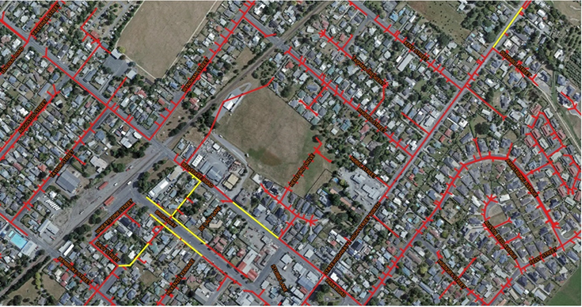
WWTP
The Waste water
treament ponds are progressing well. Due to the weather sensitivity of of the
leak detection, the team has gone away and are planning to be back around 12
December. All newly detected faults have been repaired on the go.
The intake pipes have now been
connected to the main line.
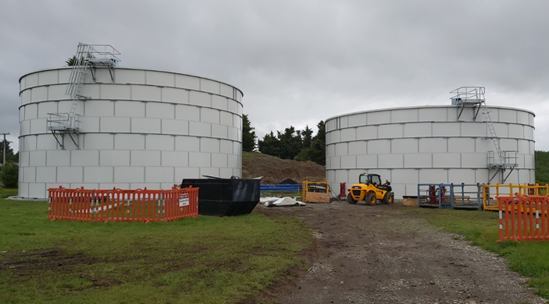
Image – intake pipe
The outfall pump station has now been connected to the
reservoir outlet pipes and the outfall pipeline. These works where only
scheduled to be delivered next year, but due to contractor availability we have
made great progress.
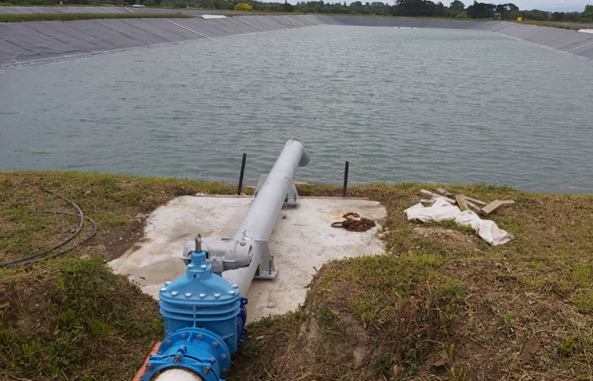






The WWTP Project is scheduled to reach practical completion
at the end of the fiscal year i.e. 30 June 2023. We anticipate
at this time we will better understand the cost for completing the Phase 2
works, remedial repairs and additional claims against the main contractor CHB
Earthworks. We will progress our claim against the contractor in earnest once
this information is to hand.
Additionally, management has reviewed the costs to date and
the forecast to bring the project to practical completion. We anticipate
total project costs as shown below:
|
Project
stage
|
Cost (life to date)
|
Forecast remaining spend
|
Total forecast spend
|
Total Project Budget
|
|
Stages One and Two
|
7,654,348
|
0
|
7,654,348
|
|
|
Stage Three
|
5,144,065
|
1,106,772
|
6,250,837
|
|
|
Remedial, contingencies, legal, other
|
300,993
|
746,271
|
1,047,264
|
|
|
Total
|
$13,099,406
|
$1,853,043
|
$14,952,449
|
$14,612,447
|
The
table above shows a potential forecast overrun of $340k. However, within the
total forecast budget there are several items which may not eventuate, as well
as the likelihood of recovering significant costs from CHB. This includes
the following:
· Potential extension of time costs (related to mudfish delay) of
$428k factored into the forecast, which Council may be required to pay.
· Legal fees of $220k in the Forecast remaining spend which may not be
required.
· Approximately $320k in costs related to remedial work on the liner
which we expect to be able to recover. Will also pursue additional cost
recoveries (e.g. legal costs).
· Retentions of $125k which we expect to keep, reducing the amount to
be paid.
Management
will continue to provide updates to Council as the project is completed and we
gain more certainty around these elements.
9. other
initiatives
Vesting part former
State Highway 2 in Carterton District Council
NZ Transport Agency
(Waka Kotahi) is vesting part of the former State Highway 2 road at Ahikouka,
south of Carterton as shown below:
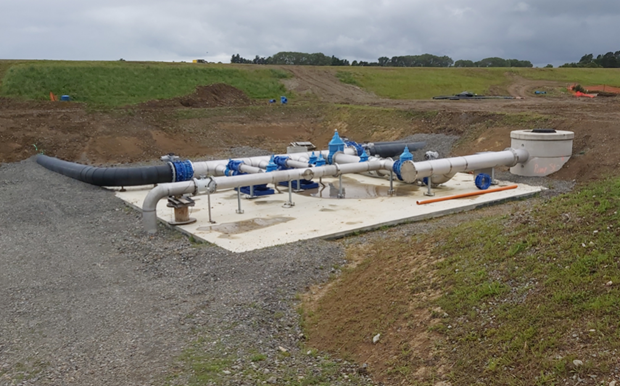
In the early 1960s the
Waka Kotahi predecessor, the National Roads Board, undertook State Highway 2
deviation works in and round Matarawa Road (formerly Swamp Road), Carterton.
Following completion
of the revised alignment, the former State Highway Road remained as a legal
road for the purposes of providing access to the adjoining properties that were
not allocated crossing places onto the new State Highway 2 alignment.
Section 1 includes two
main parts. The northern most part is legal access for the rear property,
which is hapū owned land. The second part dissects the hapū
land. Management will investigate returning these sections of land to
hapū where this is possible, along with section 6, which is whenua
surrounding the urupā.
Two parts of the old
State Highway (#2 and #5 above) are required to be set apart for stream
diversion. These two sections, potentially along with sections 3 & 4
may be transferred to Greater Wellington Regional Council once the Road
Stopping process has been completed by Council.
Management anticipates
the Road Stopping process may take up to two years, once the land is vested in
Council.
10. Considerations
10.1 Climate change
Considerations have been noted in the report, as appropriate.
10.2 Tāngata
whenua
Considerations
have been noted in the report, as appropriate.
10.3 Financial impact
Considerations have been noted in
the report, as appropriate.
10.4 Community Engagement requirements
Considerations have been noted in
the report, as appropriate.
10.5 Risks
Considerations have been noted in
the report, as appropriate.
11. Recommendation
That the Council:
1. Receives
the report.
File
Number: 319298
Author: Geoff
Hamilton, Chief Executive
Attachments: 1. Waste
Management and Minimisation Plan Review Council Report ⇩
|
Ordinary
Council meeting Agenda
|
7
December 2022
|
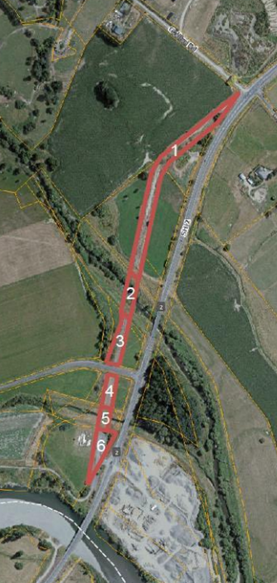
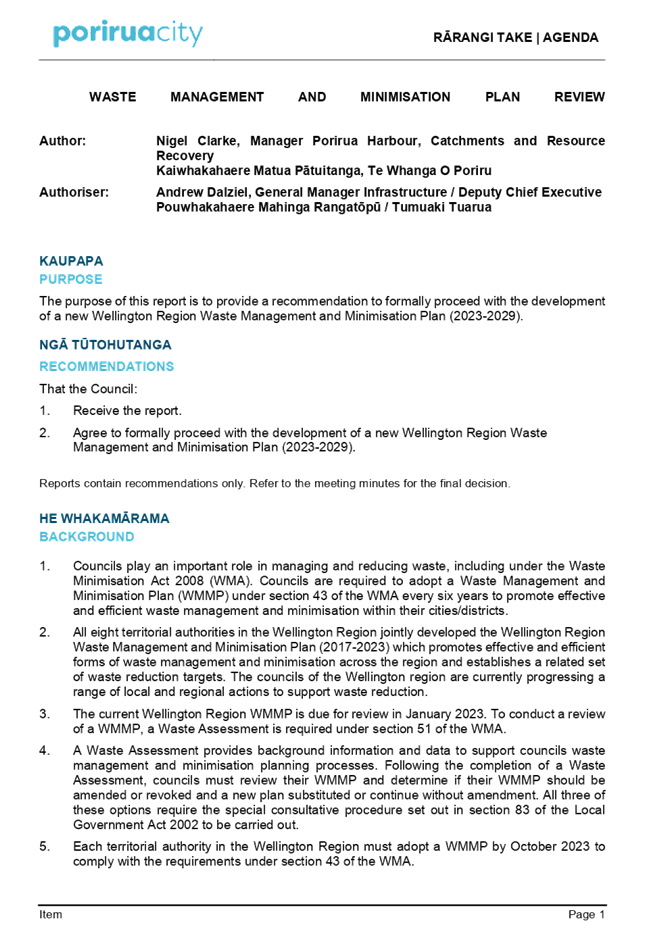
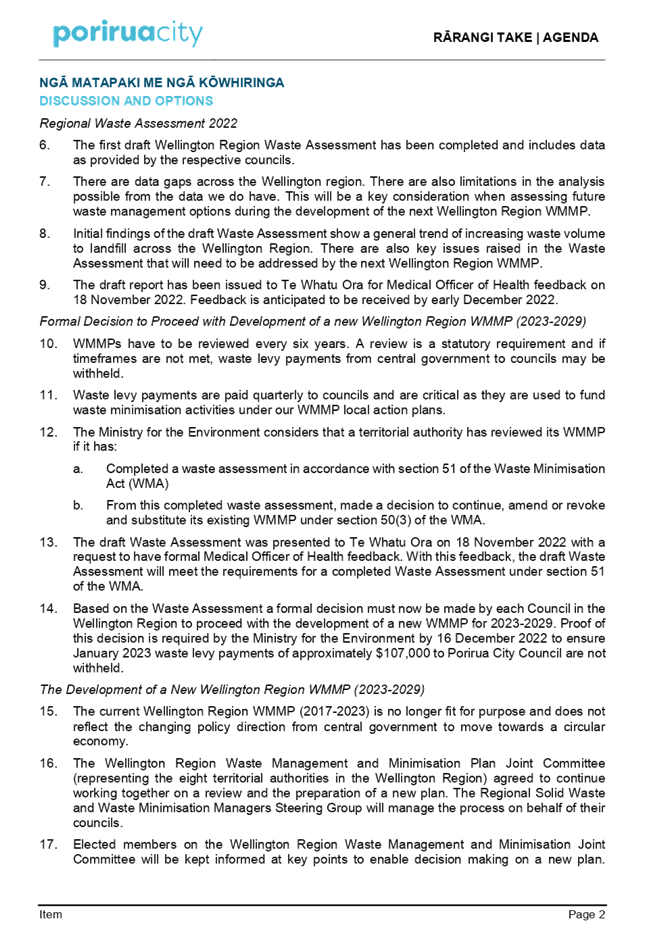
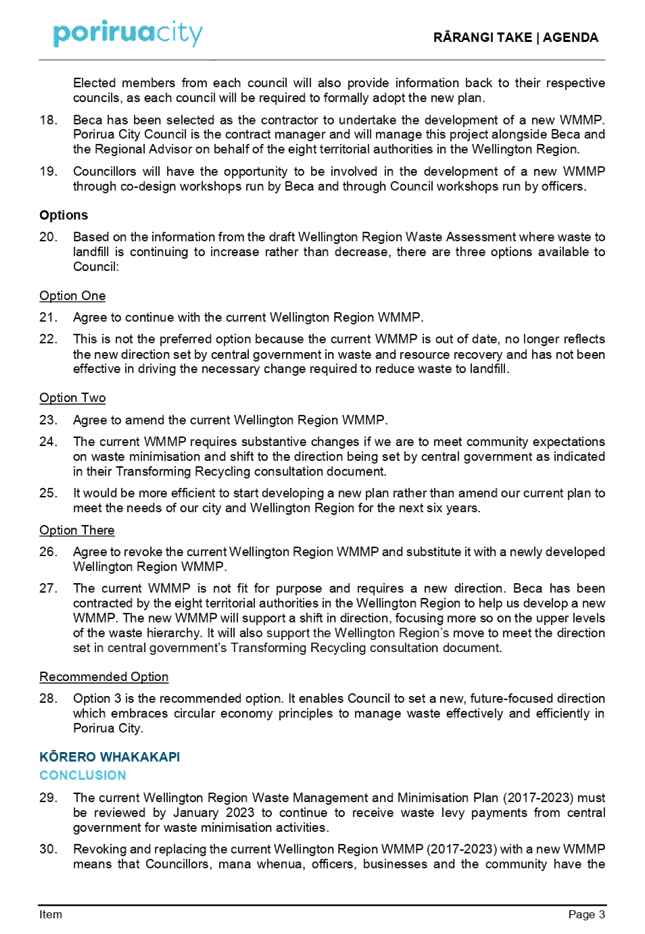

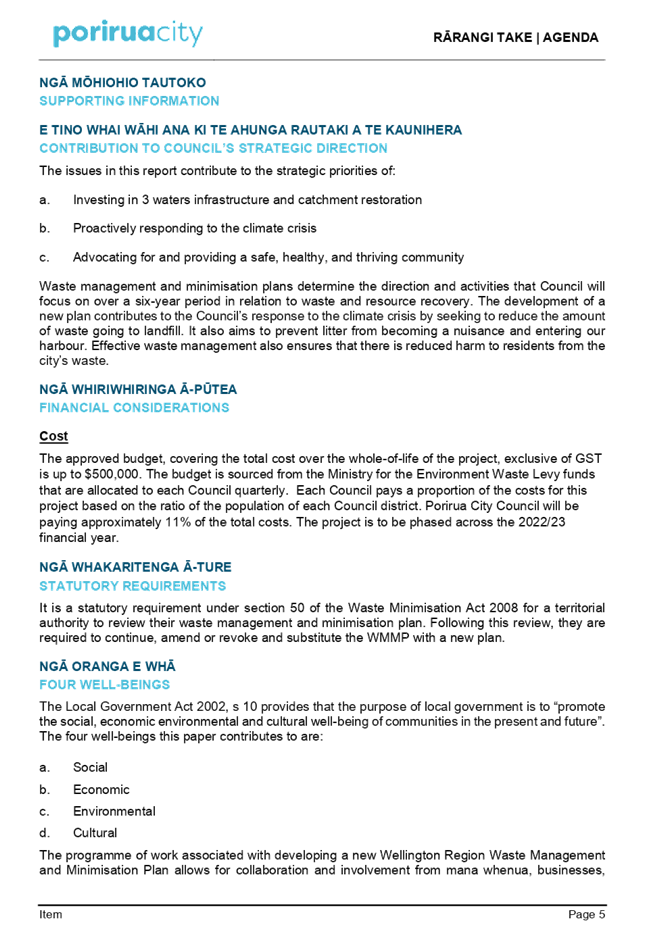
|
Ordinary
Council meeting Agenda
|
7
December 2022
|
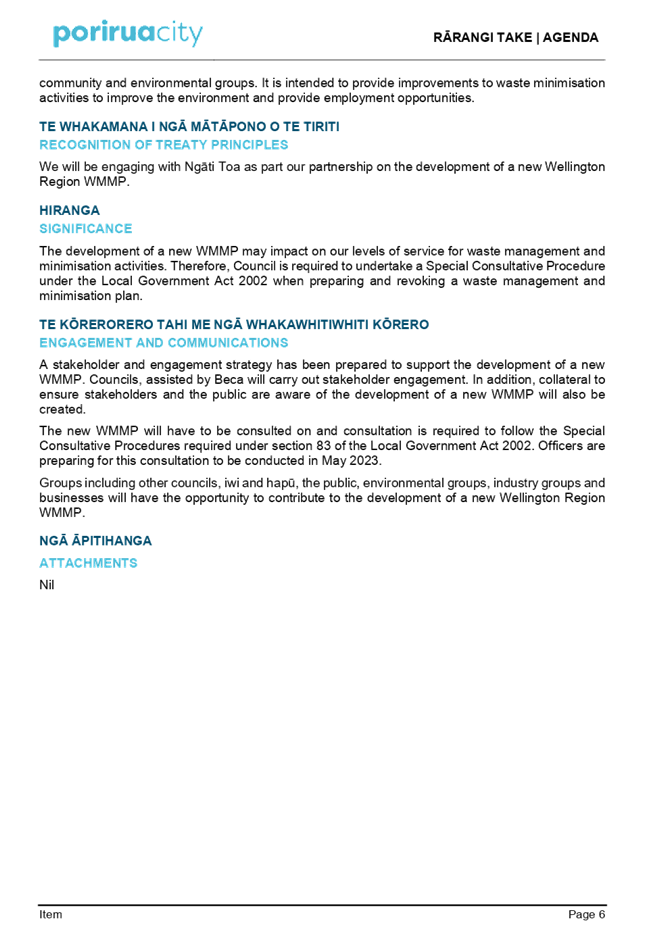
7.9 Meeting
Schedule for January to December 2023
1. Purpose
For the council to approve the
schedule of Council and Committee meetings for the period January 2023 to December 2023.
2. Significance
The matters for decision in this report are not
considered to be of significance under the Significance and Engagement Policy.
3. Background
The Council decides its meeting schedule ahead of
the next calendar year. Meeting dates are then published, which is a
requirement of the Local Government Official Information and Meetings
Act. Meeting dates are displayed on the Council’s website.
4. proposed
dates for the council and committee meetings
The Council has opted to have Committee and Council
meetings primarily on a Wednesday.
In line with the previous recommendation made by
Council for July to be free of meetings, there are no meetings planned for July
2023.
The local shared
meetings have had input from democratic services in Masterton District Council
and South Wairarapa District Council Democratic Services staff and have been
agreed.
The agreed LGNZ Zone 4 meetings have been included
in the calendar, as well as the GWRC meetings (Regional Transport Committee,
Wellington Regional Leadership Committee and the Civil Defence Emergency
meetings).
The proposed meeting schedule for 2023 is outlined
in Attachment 1.
Key:
(for those meetings with abbreviations in the
schedule)
· Gov
Gp = Governance group meeting
· A&R
= Audit and Risk Committee meeting
· P&P
= Policy and Projects Committee
· WRLC
= Wellington Regional Leadership Committee
· CDEM
= Civil Defence Emergency Meeting
· RTC
= Regional Transport Committee
· WREMO
= Wellington Region Emergency Management Office (training)
4.1 Council
The Ordinary Council meetings will be held on an approximately
six-weekly schedule starting at 1.00pm except for the March meeting which will
start at 4.00pm to allow the Youth Council to attend after school.
4.2 Policy
and Projects Committee
The Policy and Projects Committee will continue to meet
approximately eight-weekly on a Wednesday, starting at 9am.
5. 3 Audit and Risk Committee
The Audit and Risk Committee traditionally meets quarterly.
The dates proposed are timed to allow the Committee to consider annual planning
and reporting matters.
It is proposed the Audit and Risk Committee meetings continue to
start at 9.30am.
5.4 Water Race Committee
The Water Race Committee continues to meet quarterly. It is
proposed that meetings continue to start at 9.30am.
5.5 Investment Committee
This is a new Committee formed by Council with the first meeting to
be held in 2023. It is proposed these meetings are held on the same day as the
Audit and Risk Committee meeting, beginning at 1pm.
5. Other
meetings
The Council has
several other regular meetings, including advisory groups, the Wairarapa
Combined Councils, and others. These will be included in the year’s
calendar of meetings, but the dates for those meetings are not required to be
formally adopted so do not appear in this report.
6. Notifying
meetings
Following adoption of
the annual schedule of meetings, the schedule will be available on the
Carterton District Council website and also at the CDC reception and library.
In addition, as per the Local Government Official Information and Meetings Act
1987, on approximately the 20th of the month the meetings for the following
month are advertised in the Wairarapa Times Age.
7. CONSIDERATIONS
7.1 Climate
change
There
are no climate change considerations.
7.2 Tāngata whenua
Iwi
representatives will be invited to the Committee and Council meetings. There
are no specific tāngata
whenua considerations in relation to the decision in this paper.
7.3 Financial
impact
There
are no financial impacts.
7.4 Community
Engagement requirements
Meeting
dates will be advertised as required by legislation. There are no further
community engagement requirements related to this decision.
7.5 Risks
No
other risks identified.
8. Recommendation
That the Council:
1. Receives
the report.
2. Adopts
the schedule of meetings for January to December 2023 as outlined in Attachment
1.
3. Notes that
meeting dates and/or times may be changed by agreement with the Chair and the
Chief Executive and will be advertised as required by the Act.
File
Number: 141490
Author: Kelly
Vatselias, Corporate Services Manager
Attachments: 1. Proposed
Meeting Schedule 2023 ⇩
|
Ordinary
Council meeting Agenda
|
7
December 2022
|

|
Ordinary
Council meeting Agenda
|
7
December 2022
|
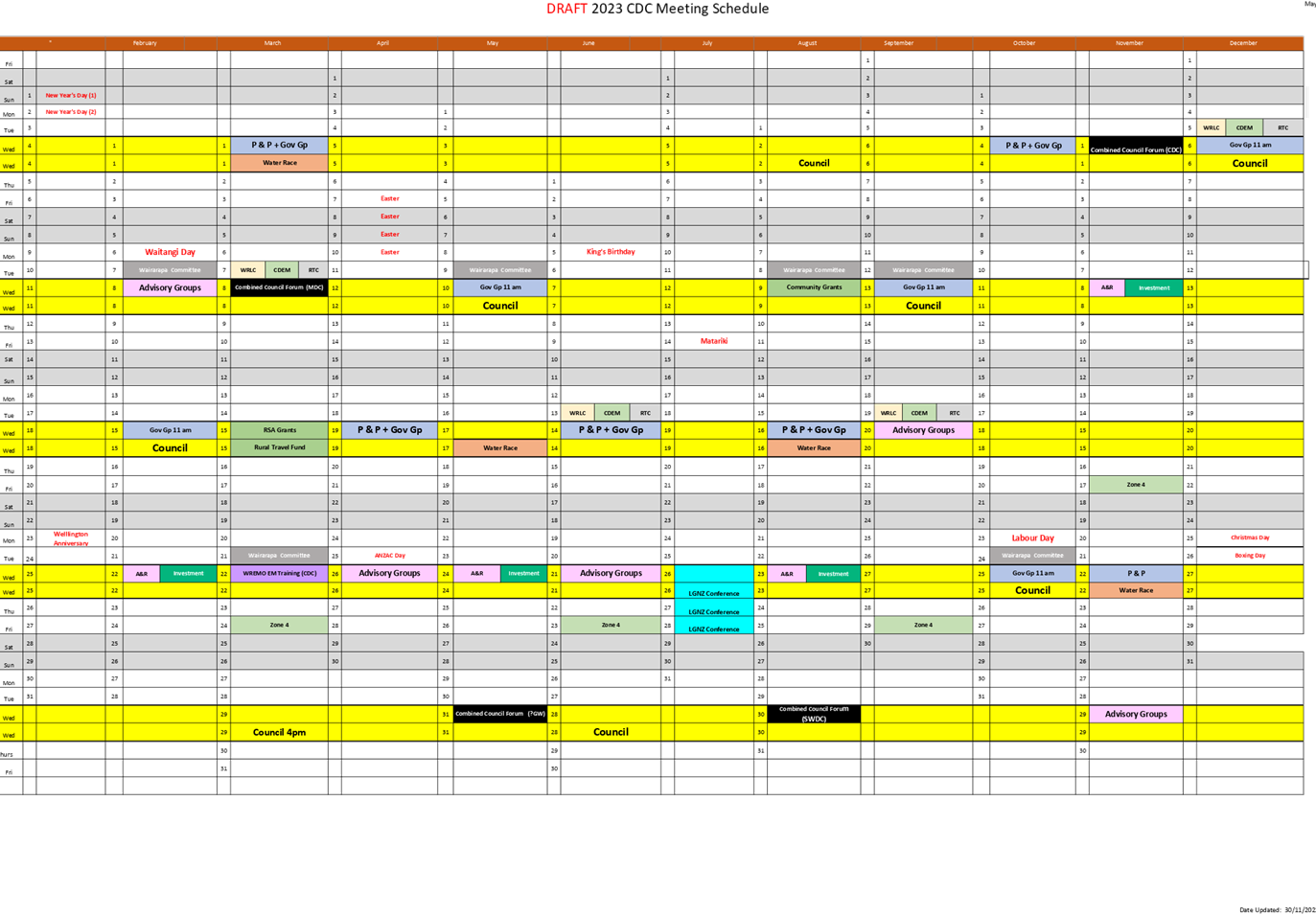
7.10 Reporting
on non-financial performance - Quarter 1 2022
1. Purpose
For the Council to
consider the results of non-financial performance (also called service
performance) of Council.
2. Significance
The
matters for decision in this report are not considered to be of significance
under the Significance and Engagement Policy.
3. Background
4. Significance
The
matters for decision in this report are not considered to be of significance
under the Significance and Engagement Policy.
5. Background
The
Council has financial and non-financial measures in the Ten-Year Plan, against
which it must report at least annually. This is done in the Annual
Report.
Reporting
progress throughout the year enables issues to be identified and addressed in a
timely manner, rather than waiting until the year end results are known.
In this way the Council is more likely to meet its performance targets, or
address any issues which may be identified.
6. Discussion
The
attached schedule sets out the service performance achieved over the period
from July to September 2022, the first quarter of the 2022/23 financial
year.
Overall,
this shows continuing processes and performance at the levels shown in 2021/22,
with some improvements shown. For example, improvements to potable water
reticulation have reduced water losses within the system to 22% currently, from
38% in 2020/21.
There
is room for continued improvement in response to service requests within 24
hours, though this quarter has shown an improvement to 2022 results with 83% of
requests acknowledged within 24 hours, compared to 56% for 2022.
Gaps
in data for water treatment plants have meant non-compliance with drinking
water standards. Work is being completed to address this issue.
Average
water consumption per resident per day of 398.1 litres is within the target of
≤400 litres, however it is very close to the limit. The water
restrictions campaign is about to begin, and residents will be encouraged to
conserve water over the summer months, with restrictions in place as required.
7. CONSIDERATIONS
7.1 Climate change
Non-financial
reporting may indicate the implications of climate change in the context of
specific Council activities. There are no climate change considerations in
regard to the decisions in this report.
7.2 Tāngata whenua
Aspects
of non-financial reporting are likely to be of specific interest to tāngata whenua. There are no specific
considerations in regard to the decisions in this report.
7.3 Financial impact
Reporting
on non-financial performance reflects past or current activity inherently
covered by existing financial planning. If financial implications arise
as consequence to non-financial reporting, these will be addressed separately.
7.4 Community Engagement
requirements
No
community engagement requirements.
7.5 Risks
Any
risks arising from non-financial performance reporting will be identified and
addressed.
8. Recommendation
That the Council:
1. Receives
the report.
File
Number: 317992
Author: Kelly
Vatselias, Corporate Services Manager
Attachments: 1. Non-financial
performance measure quarterly results - September 2022 ⇩
|
Ordinary
Council meeting Agenda
|
7
December 2022
|

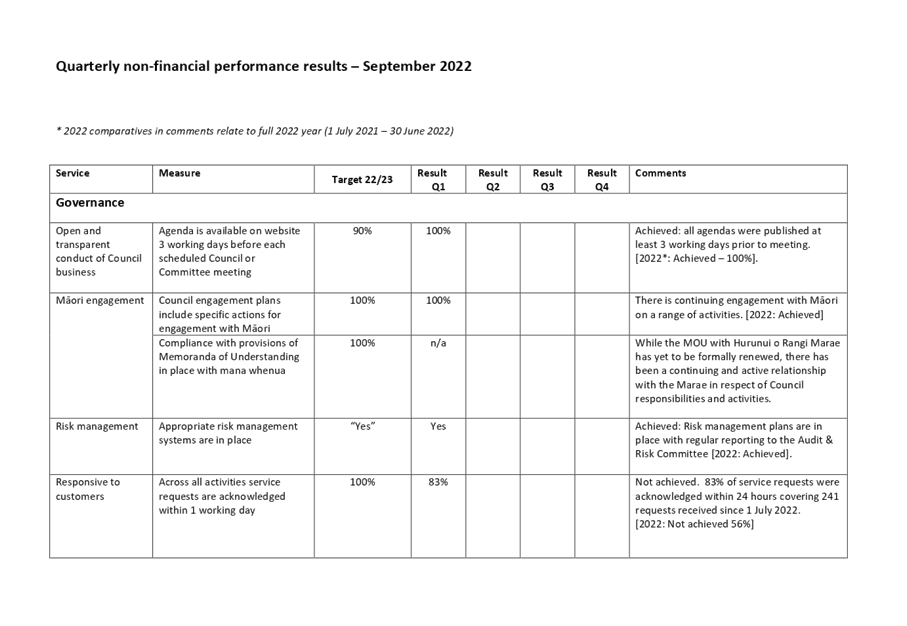
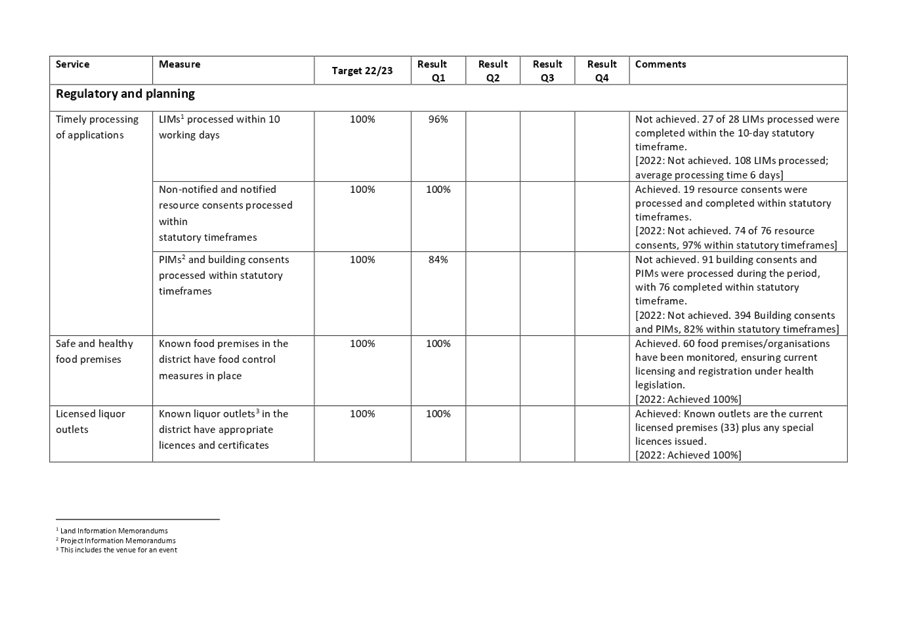
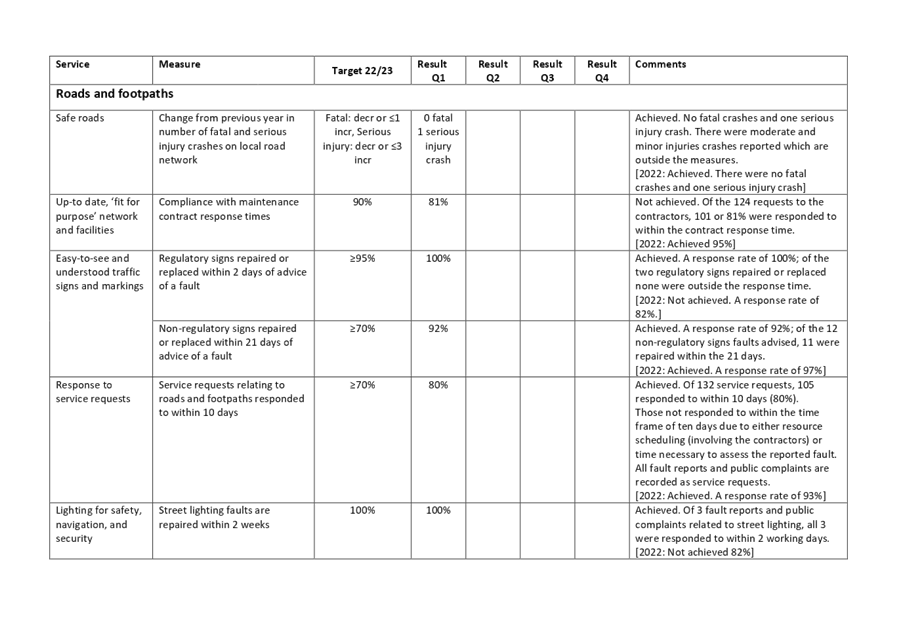
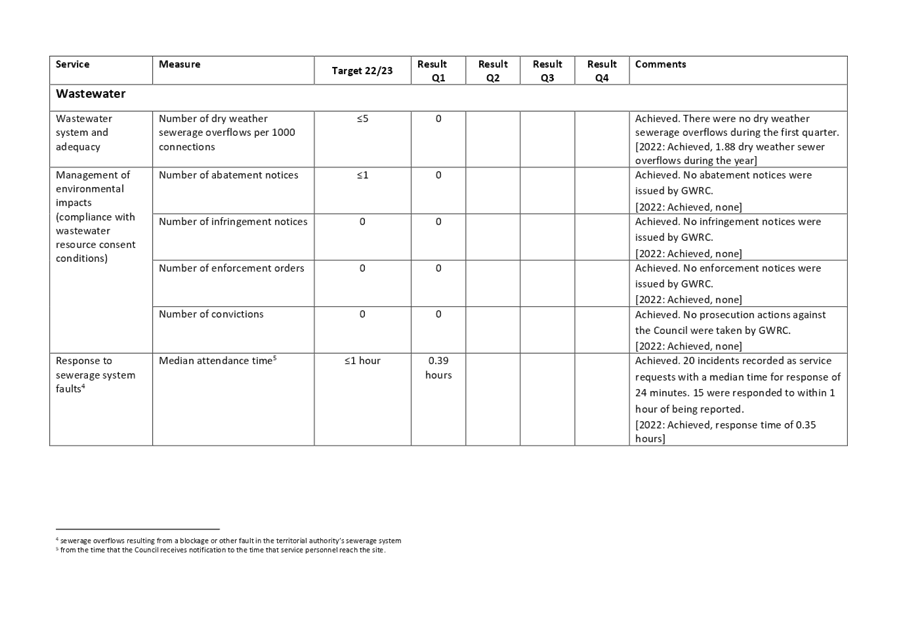
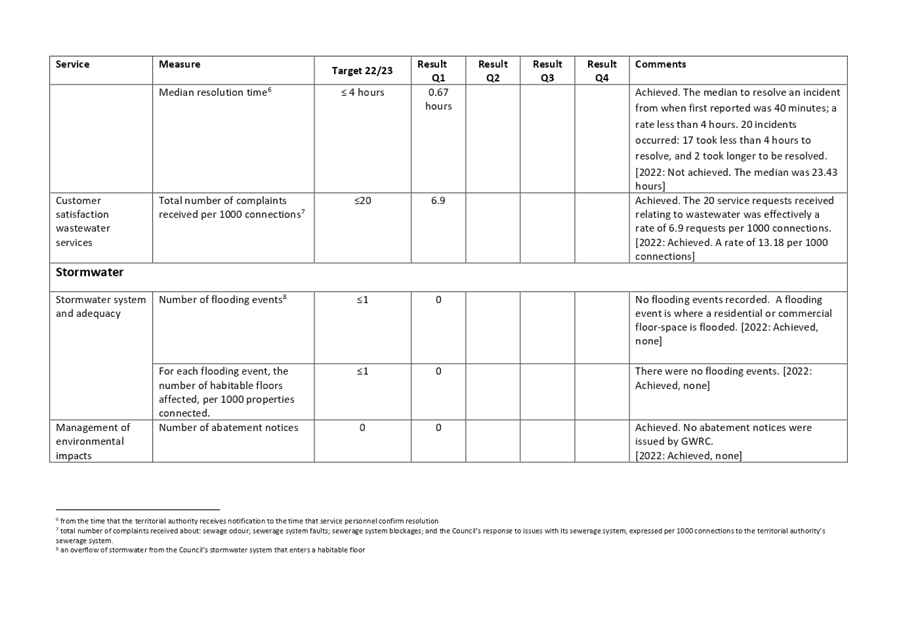
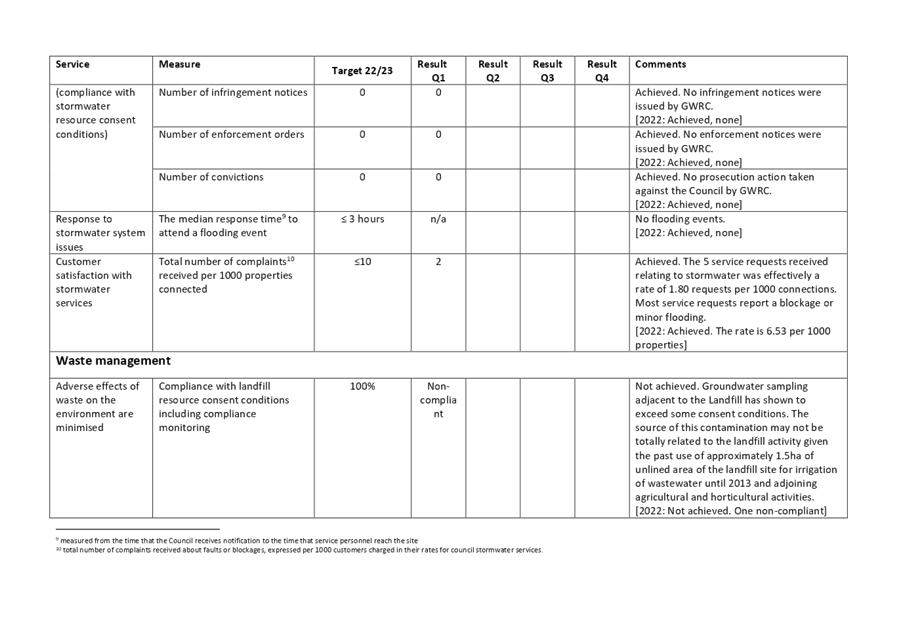
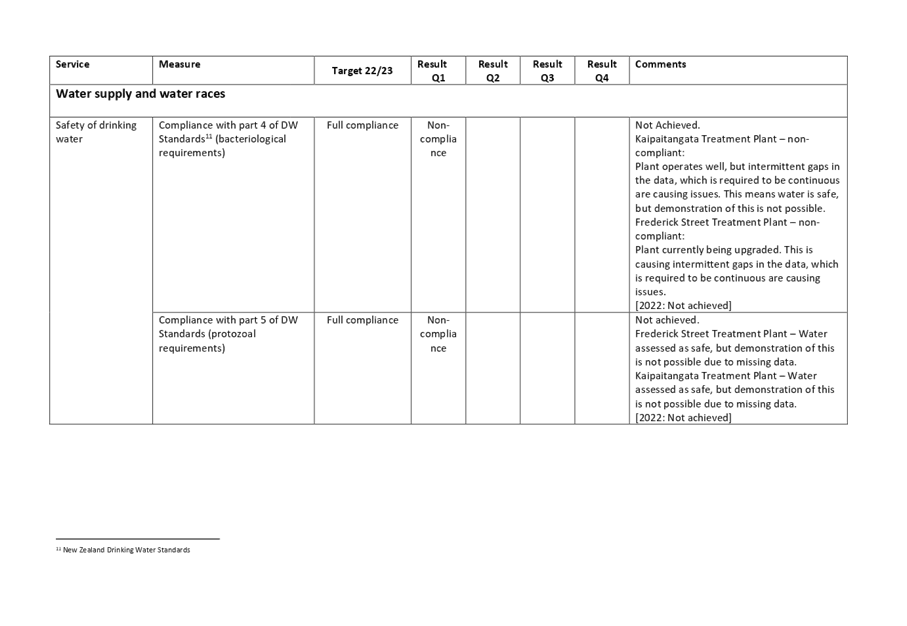

|
Ordinary
Council meeting Agenda
|
7
December 2022
|

7.11 Financial
report for the 3 months ended 30 September 2022
1. Purpose
To present the
financial results to Council for the financial year to 30 September 2022.
2. Significance
The
matters for decision in this report are not considered to be of significance
under the Significance and Engagement Policy.
3. Background
Quarterly
reports are provided to the Council at its Ordinary meetings that coincide with
the end of the financial period and reflect the output of internal management
reporting.
4. FINANCIAL
STATEMENTS
Financial
statements for the year to 30 September 2022 are in Attachment 1.
They
include:
· Statement of financial performance
· Statement of financial position
These
statements include variances from budgets as approved in the Annual Plan and as
amended by Council or by the Chief Executive under delegated authority.
Most
budgets have been phased across months within the year by dividing by 12. The
most significant exceptions are wages, which are based on payrolls per month,
and rates which is based on rates instalment dates
Overall, the council has
recorded an operating surplus of $1.1m for the quarter ended 30 September 2022.
As illustrated below, Council is tracking
close to expectation in expenditure and in
income.
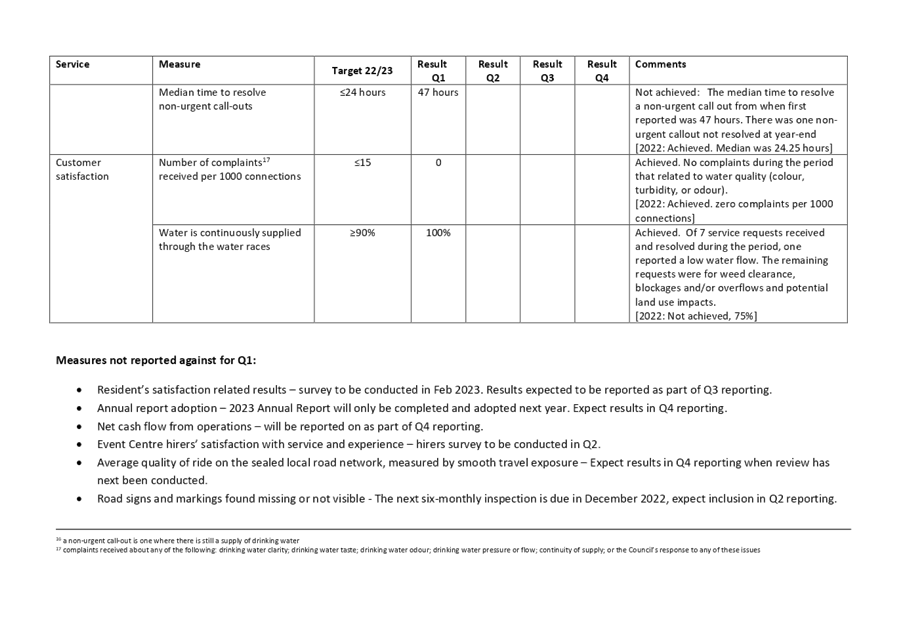
The table below sets out the detail of the expenditure and
revenue for the period.

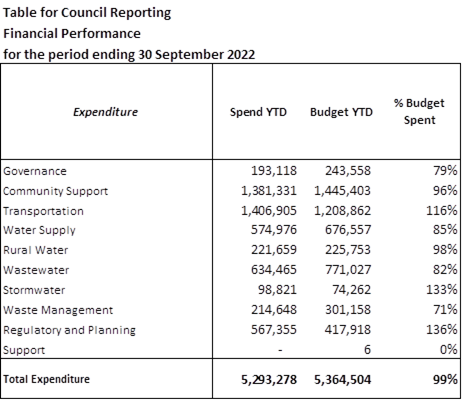
5. SIGNIFICANT
ACTIVITY VARIANCES
As the table above indicates, we are generally pleased
with financial performance to date. Expenditure
is slightly below budget and revenue is slightly above budget.
Overall, our view based on the data to 30 September 2022,
is that operationally we will meet budget.
5.1 OPERATING INCOME
Generally, revenue is slightly ahead of budget,
some things of note:
· Grants
and subsidies are behind budget this is due to expected grant funding budgets
not being put in the period income is likely to be received, as this is unknown
at the time of writing this report.
· Development contributions are well ahead of budget
due to increased development. It
should be noted the revenue received from contributions is held in special
reserves and used for capex.
· Recoveries
income is ahead of budget these are costs recovered from MDC and SWDC
for the Combined District Plan and other projects the costs for these are
included in councils’ expenditure.
5.2 OPERATING EXPENDTURE
· Transportation
expenditure is ahead of budget due to Emergency works expenditure not being
budgeted we will receive some income to cover this expenditure.
· Three
Waters activity is generally on budget, stormwater maintenance is slightly over
budget this is due to more culvert cleaning and clearing up due to the weather
events.
· Resource
management and planning expenditure is ahead of budget. This activity reflects
the ongoing review of the Combined District Plan where CDC is leading the
review process, and some of this is offset by recoveries received by MDC and
SWDC, which is also ahead of budget as noted above.
· The other expenditure variances
are generally related
to seasonal workflows, and budget phasing.
5.3 CAPITAL
EXPENDITURE
Capital expenditure during the three months to 30 September was $1.5
million.
The Annual plan budget for Capital
expenditure was $9.1m, plus carried forward budget of $5.6m, as part of our
year-end reconciliation this was reduced to $4.4m. Therefore, the capital
budget for the 2022/23 year is $13.5m.
The following table identifies the key
areas of this spend over the year and the amount spent to 30 September 2022.
Some planned areas reflect funding accumulated over the past few years, or is
activity scheduled over recent years or to be done over the next few years.
Other activity reflects seasonal scheduling and progress on contracts.
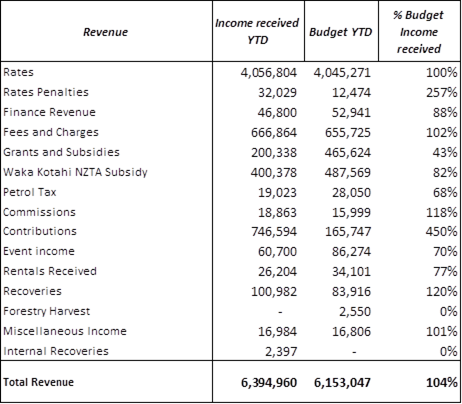
While
it appears our capex programme is significantly underspent in the first
quarter, there are some particular projects which have not yet started, or
spend is low, for various reasons, including:
· Other roads $347k – represents $295k carry forward of budget
for the Five Town Trail and $52k for Under veranda lighting move to LED budget
carry forward from previous year which are still to be completed.
· Animal pound $338k – on hold as a potential service agreement
with MDC and/or SWDC is negotiated.
· Relocation of ops yard $1,186k – on hold while project is
rescoped.
· District Plan review $531k – review being undertaken, but
timing of spend is based on when work is required.
Based
on the above, we do not expect to achieve the full capex programme in 2022/23
as some of these projects may not proceed/will be delayed. We are however
ensuring critical projects are taking place, including the renewals programme.
Further information on the capex programme and forecast for the year will be
provided in the December quarter financial report.
5.4 BALANCE SHEET AND CASH FLOWS
As at
30 September 2022, the council has borrowed $14,700,000 from the Local
Government Funding Agency reflected in 6 debenture bonds amounting to
$12,000,000 and short-term borrowing (less than 12 months) of $2,700,000. We
will accumulate cash over the life of these bonds or short-term debt to repay
these as they fall due.
6. Operating
budget approvals
There are some specific areas of
risk/additional work for council staff where management recommend Council
approve unbudgeted expenditure to address this:
6.1 IT
resource
A
Baseline Information Security Assessment has been carried out at CDC as
reported to the Audit and Risk Committee’s November meeting. The
assessment reviewed the hardware, processes, and documentation required for the
information security and protection at the Council. The detailed report was
presented to the Committee in the public excluded section of the meeting, due
to security considerations around some of the information contained in the
report.
Work
has started on implementing recommendations made in the auditor’s report.
One of the more significant risks identified is the key person risk Council has
with only one staff member in the IT team. The report states:
It
is our opinion that the Council is highly dependent upon specific IT personnel
knowledge and the availability of the Information Systems Manager. We believe
that the level of risk associated with the Council having a one person
Information Systems team to be extreme. The loss of this person, either through
incapacitation or resignation, would have a profound impact on the
Council’s ability to maintain its availability of information and
information systems at an acceptable operational state.
It
is our strong recommendation that the Council increase the number of staff members
within the Information Systems team in order to reduce this critical key
personnel risk level.
We
commend the Information Systems Manager for achieving the level of operational
and cybersecurity management observed during this assessment given the very
limited resource that is available.
In
addition to addressing this key person risk, bringing in an additional IT team
member would enable Council to address other recommendations made in the report
due to the additional resource available.
This
was discussed at the Audit and Risk Committee meeting, with the Committee
recommending Council consider adding an additional IT role to Council. The
timing was also discussed, with the Committee agreeing that it would be prudent
for Council to consider approving additional budget in the current year, rather
than waiting until the next annual plan. This would enable identified risks to
be addressed sooner.
The
additional budget required for this role would be approximately $80k a year.
This is based on comparison with similar roles in local government (strategic
pay). The role would primarily be funded by rates, though management propose
that in the current year, and 2023/24, 20% of the role is funded using 3 waters
transition funding. This is due to the level of involvement the IT team have in
3 waters transition activities and the availability of funding through
DIA. In the current year, 2022/23, we would anticipate the role in place
for 5 months (after a recruitment process). This would mean a total cost of $33k
in the current year, with $7k to be funded using 3 waters transition funding,
and the remaining $26k to be funded via reserves. In the 2023/24 year the role
would be incorporated into the Annual Plan, with a total cost of $80k and $16k
would be funded using 3 waters transition funding, and $64k funded via rates.
In subsequent years, this the role would be fully funded via rates.
6.2 3
Waters transition support
The
level of work required by staff on the 3 waters transition is increasing, with
some significant pieces of work anticipated. While staff have to date managed
to handle 3 waters transition work internally, with the increase in work
expected, this will put pressure on staff being able to deliver their
day-to-day work, as well as these additional requirements.
DIA
have made funding available to Councils in order to assist with the additional
workload generated by the 3 waters transition, such as responding to
information requests. CDC have been allocated up to $350k annually for the next
two years.
Management
proposes establishing two new fixed-term roles dedicated to 3 waters transition
work. One role would be admin-related, with the other role engineering-related.
This would allow current staff to continue to deliver BAU work and enable us to
also deliver the work related to 3 waters transition.
The
two roles are expected to cost approximately $200k per annum in operating
costs, and these would be funded entirely by the funds received from DIA,
meaning no impact on rates.
In
the current year we would anticipate after a recruitment process the roles
would be in place for around 5 months of the year, resulting in a cost of $83k
which is fully funded using the 3 waters transition funding. These roles would
then be incorporated into the 2023/24 Annual Plan, with the total cost of $200k
fully funded using the 3 waters transition funding.
7. Treasury
policy breach
The
Treasury Update Report presented at the August Audit and Risk Committee meeting
highlighted that Council does not currently comply with the debt funding
profile set out in the Treasury Management Policy.
As
per the policy limits should be within the following ranges:
|
Period
|
Minimum
|
Maximum
|
|
0 to 3 years
|
15%
|
60%
|
|
3 to 7 years
|
25%
|
85%
|
|
7 years plus
|
0%
|
60%
|
As at
30 June 2022 the Council’s actual profile was:
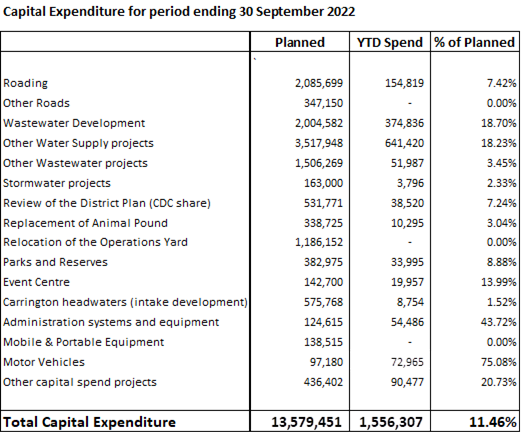
As
noted in the Treasury report, we are in breach with 64% of our total debt set
to mature within the next three years.
A
funding maturity profile that is outside the above limits, but self corrects
within 90 days is not in breach of this Policy. However, maintaining a maturity
profile beyond 90 days requires specific approval from Council.
This
breach is driven by the decision to limit 3 Waters related debt to no longer
than 2024 where possible.
Given
the breach is a result of the structuring of our 3 waters debt, it is the view
of officers that the breach is acceptable, and Council remains in breach of
this parameter.
The
Audit and Risk Committee recommended that Council approve the continued breach
of the that the breach in the debt funding maturity profile relating to the
structuring of 3 Waters debt.
8. CONSIDERATIONS
8.1 Climate change
No
specific climate change considerations.
8.2 Tāngata whenua
No
specific Tāngata whenua considerations.
8.3 Financial impact
This
paper reports financial results for the year-to-date 30 September 2022.
The
financial implications related to the proposed new roles are outlined above.
8.4 Community Engagement
requirements
No specific
community engagement requirements.
8.5 Risks
No
risks identified.
9. Recommendation
That the Council:
1. Receives
the report.
2. Approves
unbudgeted operating expenditure of $33,000 in the current year for an
additional IT resource.
3. Approves
unbudgeted operating expenditure of $83,000 in the current year for two
additional 3 waters transition roles.
4. Approves
the breach in the debt funding maturity profile relating to the structuring
of 3 Waters debt.
File
Number: 317663
Author: Kyra
Low, Finance Team Leader
Attachments: 1. Financial
Report ⇩
|
Ordinary
Council meeting Agenda
|
7
December 2022
|
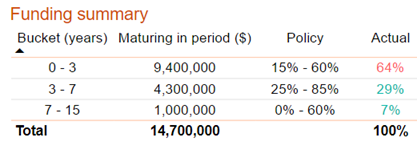
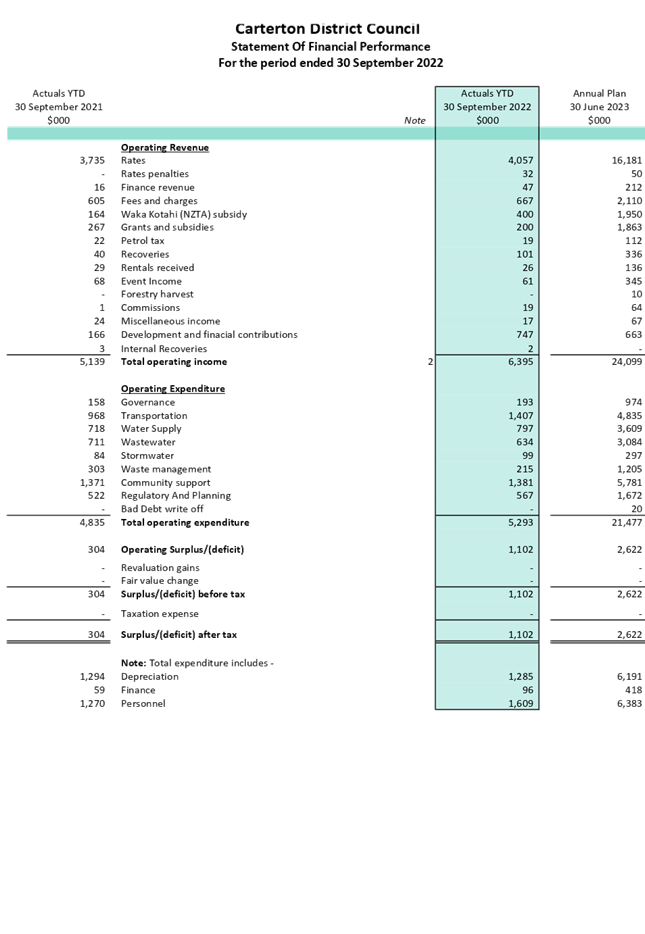
|
Ordinary
Council meeting Agenda
|
7
December 2022
|

7.12 Wellington
Region Triennial Agreement 2022-2025
1. Purpose
For the Council to
consider a draft Triennial Agreement for the Wellington Region 2022-2025.
2. Significance
The matters for decision in this report are not considered to be of
significance under the Significance and Engagement Policy.
3. Background
Section 15 of the Local Government Act requires all local
authorities within a region to enter into an agreement every triennium
providing:
(a) protocols
for communication and co-ordination among the local authorities;
(b) a
statement of the process by which the local authorities will deal with
proposals for new regional council activities; and
(c)
processes and protocols through which all local authorities can participate in
identifying, delivering, and funding facilities and services of significance to
more than one district.
In essence, the Triennial Agreement is a set of protocols to assist
region-wide cooperation for the duration of the triennium.
The Triennial Agreement is required to be agreed by 1 March after
each local authority election. If the agreement has not been signed by
that date, there are no consequences for Councils.
The role of administering authority for the Agreement is shared
across the nine councils in the Wellington region. The role is passed from one
local authority to the next at the start of each triennium and includes
providing secretarial services and acting as the contact for media and other
communications. Carterton District Council will service this agreement for the
2022-2025 triennium.
4. Discussion
The
draft Triennial Agreement 2022-2025 is in Attachment 1.
The
2022-2025 draft Agreement builds on the 2019-2022 Agreement. The changes
are:
• Modernising
the language of the Agreement
• Adding the
Wellington Region Climate Change Working Group and the Wellington Regional
Leadership Committee to the list of regional and sub-regional forums in clause
5.1(b)
• Removing the old Wellington Regional Strategy Committee which was
disestablished on 27 May 2021. Its duties and responsibilities have been taken
over by the Wellington Regional Leadership Committee.
5. NEXT
STEPS
Once
all Councils have considered the draft, Mayors will sign the Agreement, unless
one or more of the councils request a change. If any of the
region’s Councils request a change to the draft Agreement these changes
will be presented to the other Councils for consideration.
6. CONSIDERATIONS
6.1 Climate change
The draft Agreement
identifies climate change as an area the region will work on together.
6.2 Tāngata whenua
Tāngata
whenua are not party to the agreement under the Act. There are no
implications for tāngata whenua.
6.3 Financial impact
There
are no financial impacts on the Council from the Agreement.
6.4 Community Engagement
requirements
There
would be little value engaging the community on the Agreement.
6.5 Risks
There are no
identifiable risks associated with the draft Agreement.
7. Recommendation
That the Council:
1. Receives
the report.
2. Agrees
to the draft Triennial Agreement 2022-2025 in Attachment 1.
3. Delegates
to the Mayor the authority to make any minor amendments required as a result of
minor changes requested by other local authorities in the region as part of the
adoption process.
4. Authorises the Mayor to sign the Agreement on behalf of the
Council.
File
Number: 318722
Author: Geoff
Hamilton, Chief Executive
Attachments: 1. Draft
Wellington Regional Triennial Agreement 2022 - 2025 as at 30 November 2022 ⇩
|
Ordinary
Council meeting Agenda
|
7
December 2022
|

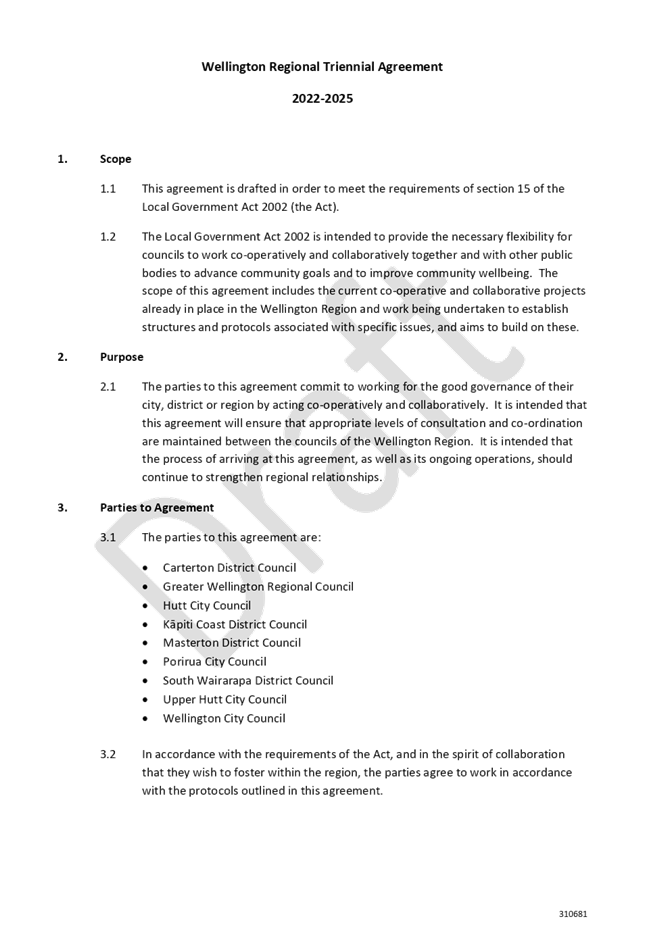
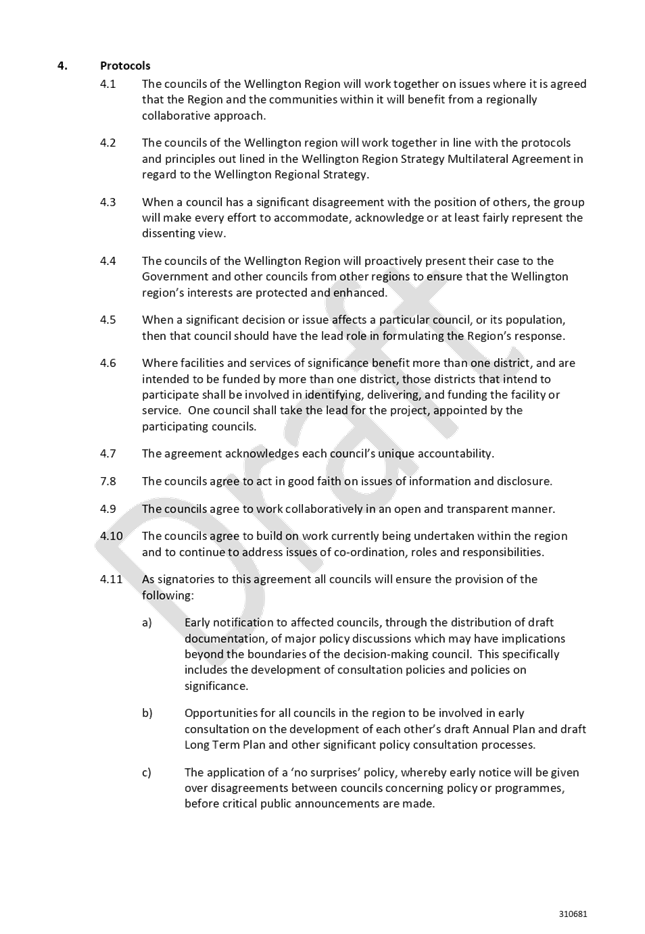
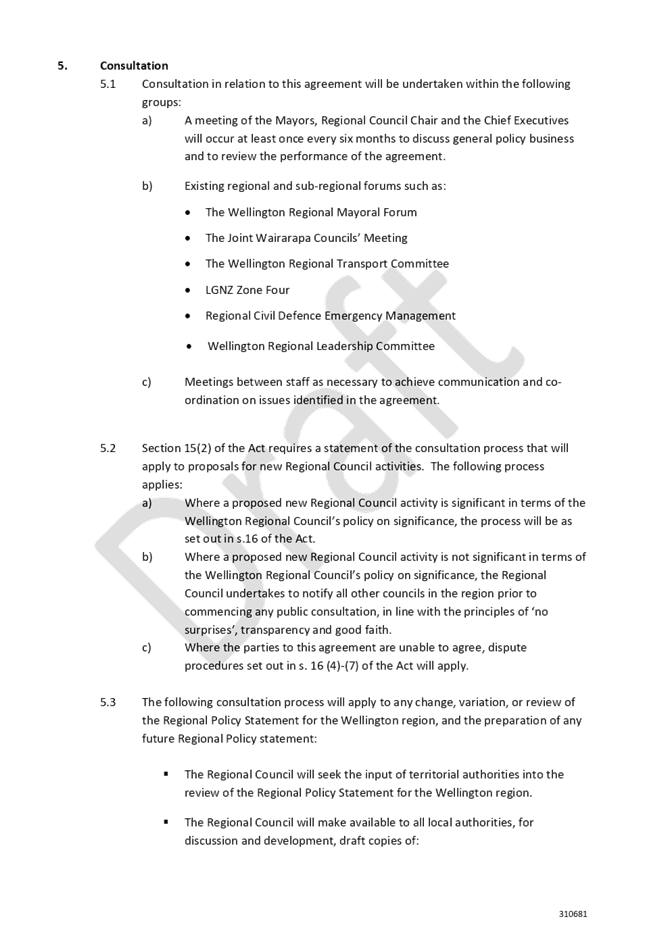
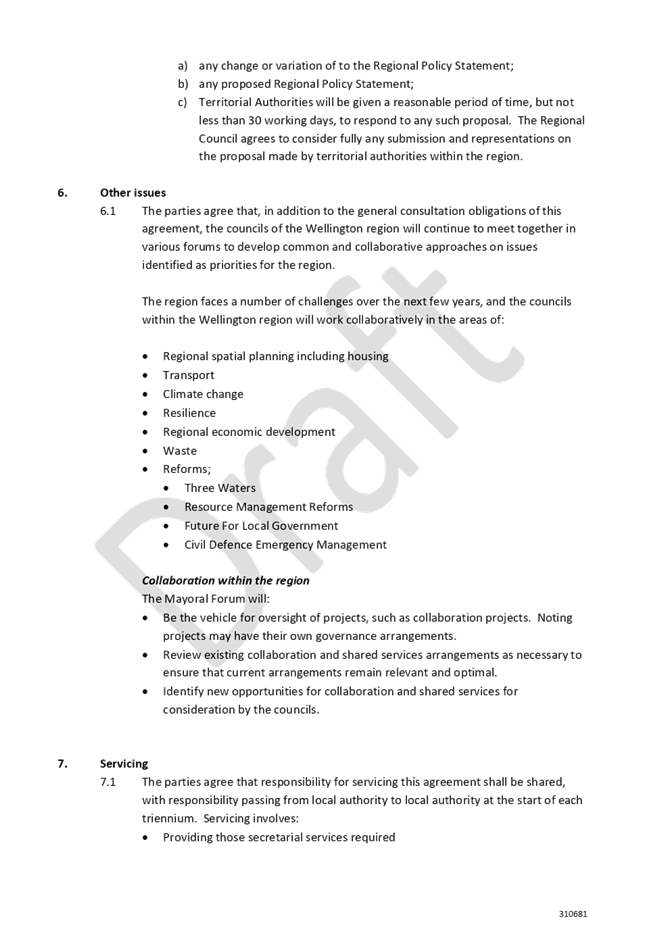
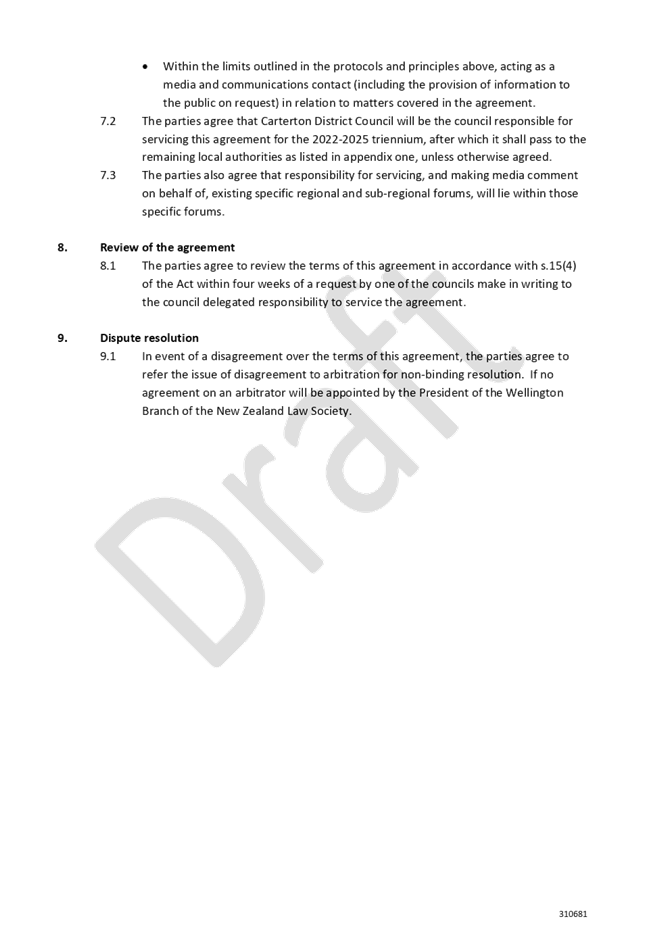
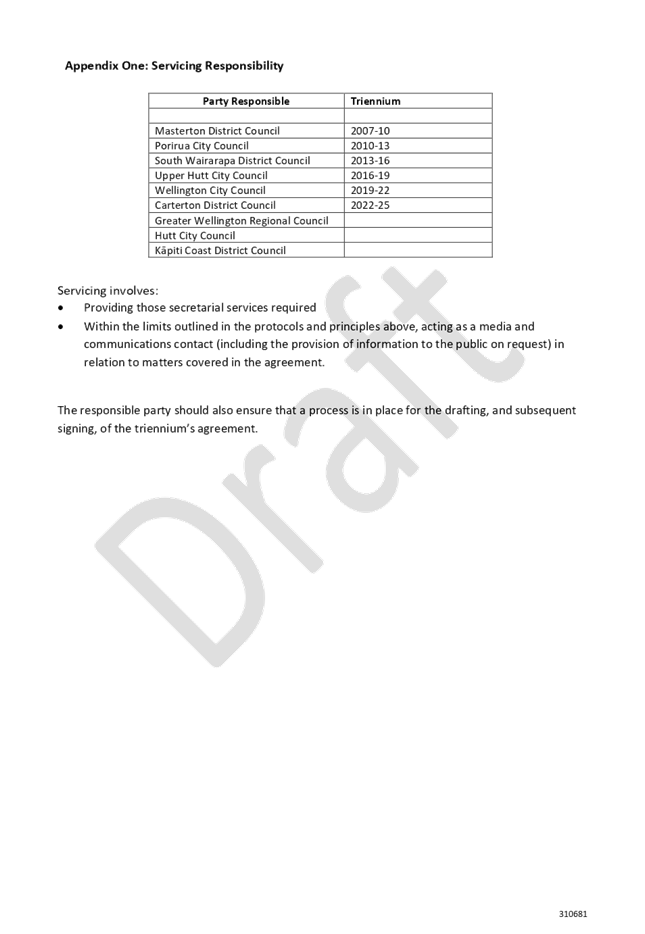
|
Ordinary
Council meeting Agenda
|
7
December 2022
|

7.13 Further
appointments to external bodies, joint committees and other groups
1. Purpose
For the Council to make Elected Member appointments
to various external bodies, joint committees and other groups for the 2022-25
Triennium.
2. Significance
The
matters for decision in this report are not considered to be of significance
under the Significance and Engagement Policy.
3. APPOINTMENTS
Council has further
appointments to make to several external groups.
Wairarapa Committee
(GWRC)
GWRC proposes that the
membership is the Mayor and an elected member alternate. In the last triennium
the Mayor attended with the Deputy Mayor as an alternate.
Wairarapa Joint
Policy Working Group
Two elected members
are sought for this group that works on joint Wairarapa council policies such
as the Smoke/Vape Free Policy and the Wairarapa Gambling Venue Policy and
Wairarapa TAB Board Venue Policy. The previous members were Deputy Mayor
Vergunst and Cr R Cherry-Campbell.
Carterton Creative
Communities Committee
The committee is made
up of community members, with one elected member and council officers providing
administration support.
Cr Steve Laurence has
been the chair of the group for the past few years, and until such time as a
decision is made, he has been co-opted on to the group as the interim CDC
elected member representative for the Creative Communities allocation meeting
on 1 December 2022. Moving forward an appointed elected member is sought
for the committee.
The Creative
Communities fund has two rounds per year, so the requirement from the
representative would be two allocation meetings per year.
Previous elected
members involved were Deputy Mayor R Vergunst and Cr R Cherry-Campbell as the
alternate.
Destination
Wairarapa
It is recommended that
Roger Wigglesworth continues as the CDC member on Destination Wairarapa.
Roger was appointed as
the Council’s representative on the Board of Destination Wairarapa in
2019. Prior to retiring from full-time employment, Roger was a Director
in the Tourism branch of the Ministry of Business, Innovation and
Employment. He previously held the positions of Director Small Business,
and Principal Advisor Economic and Regional Development with the Ministry of
Economic Development.
4. Considerations
4.1 Climate change
There
are no direct climate change implications from the decisions in this paper.
4.2 Tāngata whenua
There
are no specific considerations with regard to the decisions in this paper.
4.3 Financial impact
There
are no financial impacts.
4.4 Community Engagement
requirements
There
are no community engagement requirements.
4.5 Risks
There
are no additional risks with the decisions in this paper.
5. Recommendation
That the Council:
1. Receives
the report.
2. Makes
the following appointments for the term of the Triennium:
|
Committee / Entity
|
Elected Member
Appointee(s)
|
|
Wairarapa
Committee (GWRC) (1) + alternate
|
|
|
Wairarapa Policy
Working
Group
(2)
|
|
|
Carterton
Creative Communities Committee
(1) + alternate
|
|
|
Destination
Wairarapa
(1)
|
|
File
Number: 318791
Author: Kelly
Vatselias, Corporate Services Manager
Attachments: Nil
|
Ordinary
Council meeting Agenda
|
7
December 2022
|

7.14 Local
Government Official Information and Meetings Act Requests
1. Purpose
To inform the Council
of the number of requests under the Local Government Official Information and Meetings
Act (LGOIMA) 1987 (the Act) 2 September 2022 to 8 November 2022.
2. Significance
The
matters for decision in this report are not considered to be of significance
under the Significance and Engagement Policy.
3. Background
The
Act allows people to request official information held by local government
agencies. It contains rules of how such requests should be handled and
provides a right to complain to the Ombudsman in certain situations.
The
purpose of the Act is to increase the availability of official information held
by agencies and promote the open and public transaction of business at
meetings.
The
purposes of LGOIMA are specified in Section 4:
4 Purposes
The
purposes of this Act are, consistently with the principle of the Executive
Government’s responsibility to Parliament:
(a) to
increase progressively the availability of official information to the people
of New Zealand in order -
(i) to
enable their more effective participation in the making and administration of
law and policies; and
(ii) to
promote the accountability of Ministers of the Crown and officials, -
And thereby to
enhance respect for the law and to promote the good government of New Zealand:
(b) to
provide for proper access by each person to official information relating to
that person:
(c) to
protect official information to the extent consistent with the public interest
and the preservation of personal privacy.
The information is not limited to documentary material, and
includes material held in any format such as:
· written documents,
reports, memoranda, letter, notes, emails and draft documents
· non-written
documentary information, such as material stored on or generated by computers,
including databases, video or tape recordings
· information, which
is known to an agency, but which has not yet been recorded in writing or
otherwise (including knowledge of a particular matter held by an officer,
employee or member of an agency in their official capacity)
· documents and
manuals which set out the policies, principles, rules or guidelines for
decision making by an agency
· the reasons for
any decisions that have been made about a person.
It
doesn’t matter where the information originated or is currently located,
if it is held by the council, it must be provided if requested, unless there is
reason to withhold the information, as specified in Section 7:
7 Other
reasons for withholding official information
(1) Where
this section applies, good reason for withholding official information exists, for the purpose of section 5,
unless, in the circumstances of the particular case, the withholding of
that information is outweighed by other considerations which render it
desirable, in the public interest, to make that information available.
(2) Subject
to sections 6, 8,
and 17, this
section applies if, and only if, the withholding of the information is necessary to—
(a) protect the privacy of natural persons, including that of deceased
natural persons; or
(b) protect information where the
making available of the information-
(i) would disclose a trade secret; or
(ii) would be likely unreasonably to prejudice the commercial
position of the person who supplied or who is the subject of the information; or
(ba) in the case only of an application for a resource consent,
or water conservation order, or a requirement for a designation or heritage
order, under the Resource Management Act 1991, to avoid serious offence to tikanga Maori, or to avoid
the disclosure of the location of waahi tapu; or
(c) protect information which is
subject to an obligation of confidence or which any person has been or could be
compelled to provide under the authority of any enactment, where the making
available of the information-
(i) would be likely to prejudice the supply of similar information, or information from the same
source, and it is in the public interest that such information should continue to be supplied; or
(ii) would be likely otherwise to damage the public interest; or
(d) avoid prejudice to measures protecting the health or safety
of members of the public; or
(e) avoid prejudice to measures that prevent or mitigate
material loss to members of the public; or
(f) maintain the effective conduct of public affairs
through—
(i) the free and frank expression of opinions by or between or
to members or officers or employees of any local authority, or any persons to
whom section 2(5) applies, in the course of their duty; or
(ii) the protection of such members, officers, employees, and
persons from improper pressure or harassment; or
(g) maintain legal professional privilege; or
(h) enable any local authority holding the information to
carry out, without prejudice or disadvantage, commercial activities; or
(i) enable any local authority holding the information to
carry on, without prejudice or disadvantage, negotiations (including commercial
and industrial negotiations); or
(j) prevent the disclosure or use of
official information for improper gain or improper advantage.
It is
important for Council to identify issues arising across all communication
channels early and establish relationships with our key stakeholders out in the
public, so that Council resolve these issues as part of our day-to-day
business.
Councils
must respond to a requester ‘as soon as reasonably practicable’ and
no later than 20 working days after the day on which the request was
received. Our practice is to acknowledge receipt of the request within
the first working day. We respond promptly to requests and generally well
ahead of the 20 working days.
Where a person
requesting the information indicates urgency, we normally prioritise our
response ahead of other work. This mainly relates to requests from the
Media. Not all media requests for information are treated as LGOIMA
requests.
All
requests are recorded in a register and saved in our document management system.
The
Council proactively publishes official information responses on our website. As
such, the Council may publish the response on the CDC website after five
working days. The requestor’s name and contact details will be removed.
Proactive release of information to the public promotes openness and
transparency and fosters public trust and confidence in Council. There
are administrative benefits for the Council, such as reducing requests for
information which the publicly available and allowing for greater ease of
handling of the requests that are received.
4. reporting
lgoima requests to council
Attachment
1 contains the requests received from 2 September
2022 to 8 November 2022 as well as requests received in August, but which were
still open at the time of the August 2022 report to Council. As of 8 November
2022, there are four open requests.
For
those requests where a response was longer than 20 working days, all had
extensions applied under the legislation, and therefore met the time limit
requirements.
Under
section 13(7) of the LGOIMA, for those requests where an original request was
received and was amended or clarified after the date on which it is received,
the Council may treat the amended or clarified request as a new request,
replaces the original request.
The table below shows
total numbers of requests received in the year 2020 to 8 November 2022.
In comparison to 2020, 2021 LGOIMA numbers had increased by 49%. The number of
requests received so far this year is similar to 2020 numbers.
|
Number of requests received 2020-2022
|
|
|
2020
|
2021
|
2022
|
|
January
|
4
|
6
|
4
|
|
February
|
6
|
6
|
4
|
|
March
|
10
|
20
|
14
|
|
April
|
5
|
12
|
5
|
|
May
|
6
|
11
|
6
|
|
June
|
2
|
22
|
8
|
|
July
|
9
|
7
|
1
|
|
August
|
9
|
9
|
7
|
|
September
|
10
|
9
|
7
|
|
October
|
5
|
10
|
6
|
|
November
|
2
|
5
|
1
|
|
December
|
7
|
7
|
|
|
Total
|
75
|
124
|
63
|
5. OMBUDSMAN
In
the LGOIMA reports of 30 June 2021 and 25 August 2021, it was recorded that a
complaint was made to the Ombudsman. The requestor requested full cost
breakdowns of the Wastewater Treatment Plant relating to contractor and
subcontractors. The initial complaint was resolved.
On 21
September 2022, a further complaint made about the decision to the Ombudsman is
under review.
6. CONSIDERATIONS
6.1 Climate change
There are no climate
change considerations.
6.2 Tāngata whenua
There are no
tāngata whenua considerations.
6.3 Financial impact
There is no financial
impact.
6.4 Community Engagement
requirements
There are no community
engagement requirements.
6.5 Risks
No
specific risks are identified.
7. Recommendation
That the Council:
1. Receives
the report.
File
Number: 310265
Author: Serah
Pettigrew, Democratic Services Officer
Attachments: 1. LGOIMA
Report 7 December 2022 ⇩
|
Ordinary
Council meeting Agenda
|
7
December 2022
|
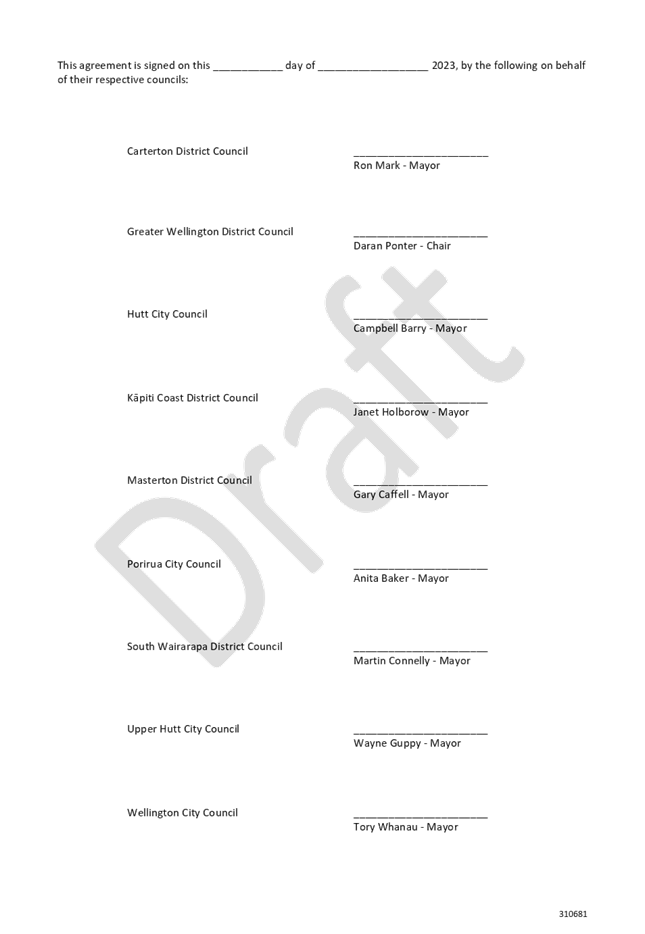
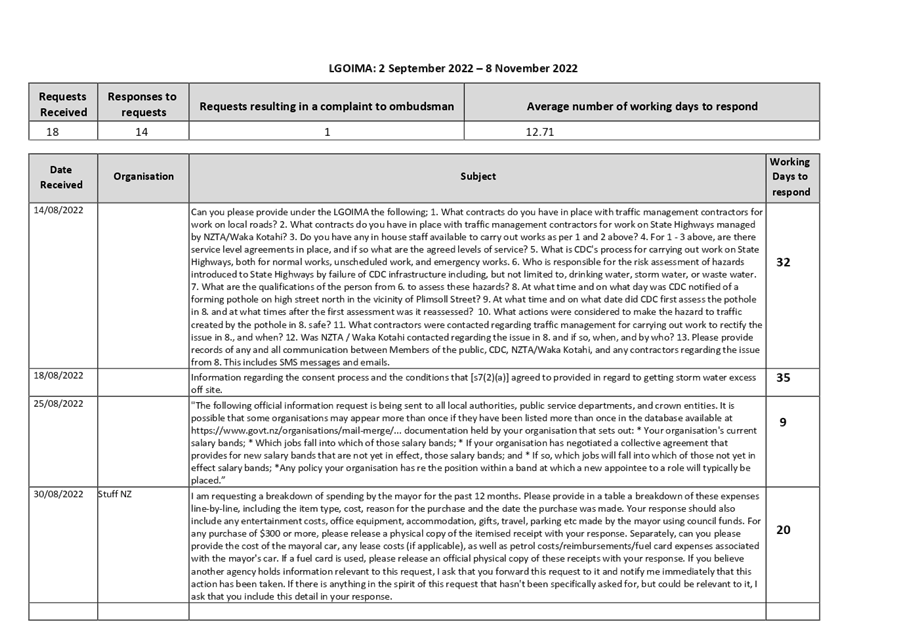
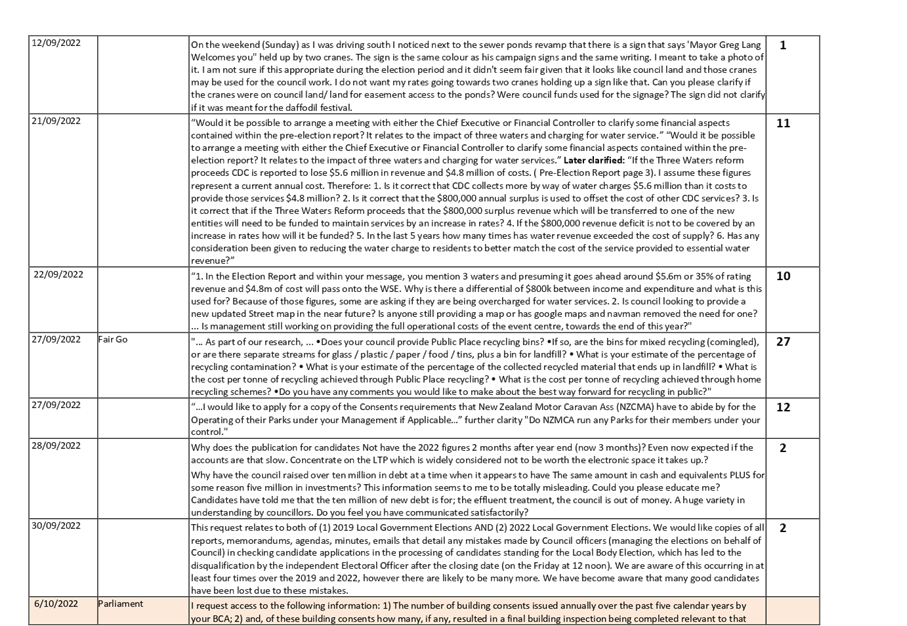
|
Ordinary
Council meeting Agenda
|
7
December 2022
|
|
Ordinary
Council meeting Agenda
|
7
December 2022
|
8 Exclusion
of the Public
RESOLUTION TO
EXCLUDE THE PUBLIC
|
Recommendation
That the public be excluded from the following parts of
the proceedings of this meeting.
The general subject matter of each matter to be considered
while the public is excluded, the reason for passing this resolution in
relation to each matter, and the specific grounds under section 48 of the
Local Government Official Information and Meetings Act 1987 for the passing
of this resolution are as follows:
|
General subject of each matter to be considered
|
Reason for passing this resolution in relation to each
matter
|
Ground(s) under section 48 for the passing of this
resolution
|
|
8.1 - Conditional Purchase of Land
|
s7(2)(g) - the
withholding of the information is necessary to maintain legal professional
privilege
s7(2)(h) - the
withholding of the information is necessary to enable Council to carry out,
without prejudice or disadvantage, commercial activities
|
s48(1)(a)(i) - the
public conduct of the relevant part of the proceedings of the meeting would
be likely to result in the disclosure of information for which good reason
for withholding would exist under section 6 or section 7
|
|





































































